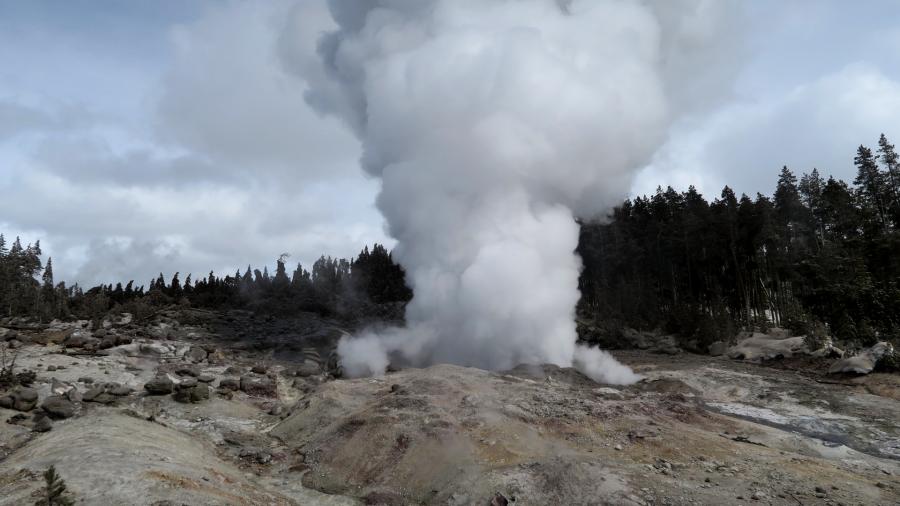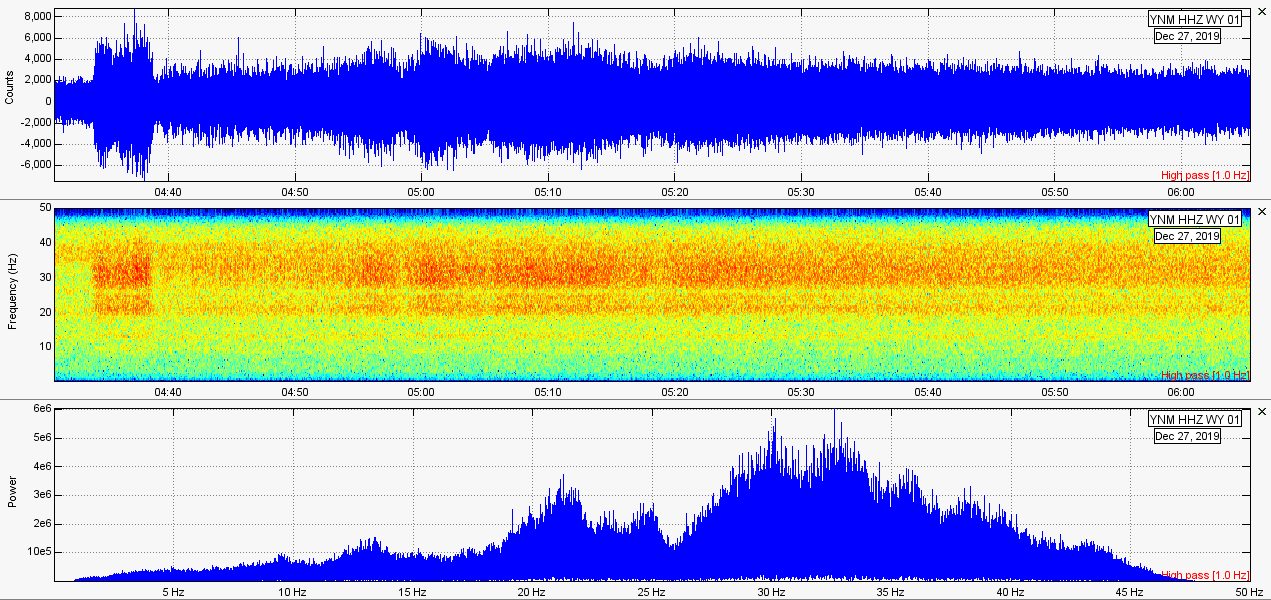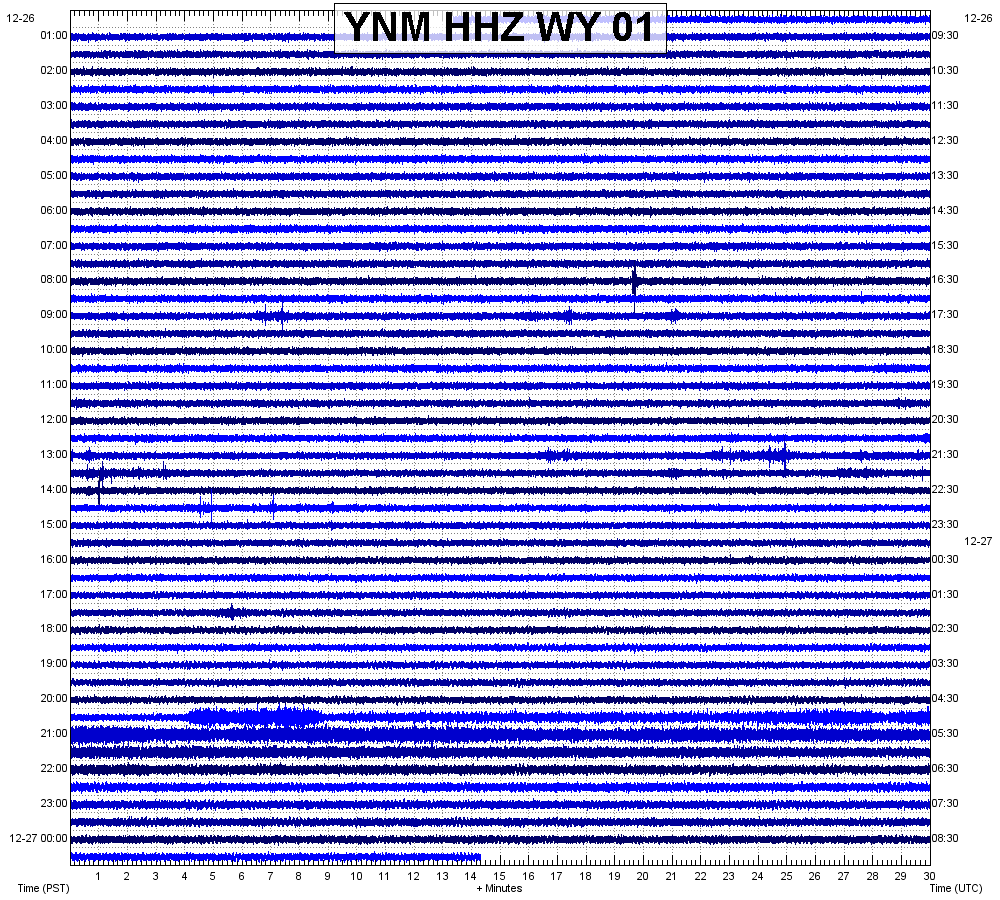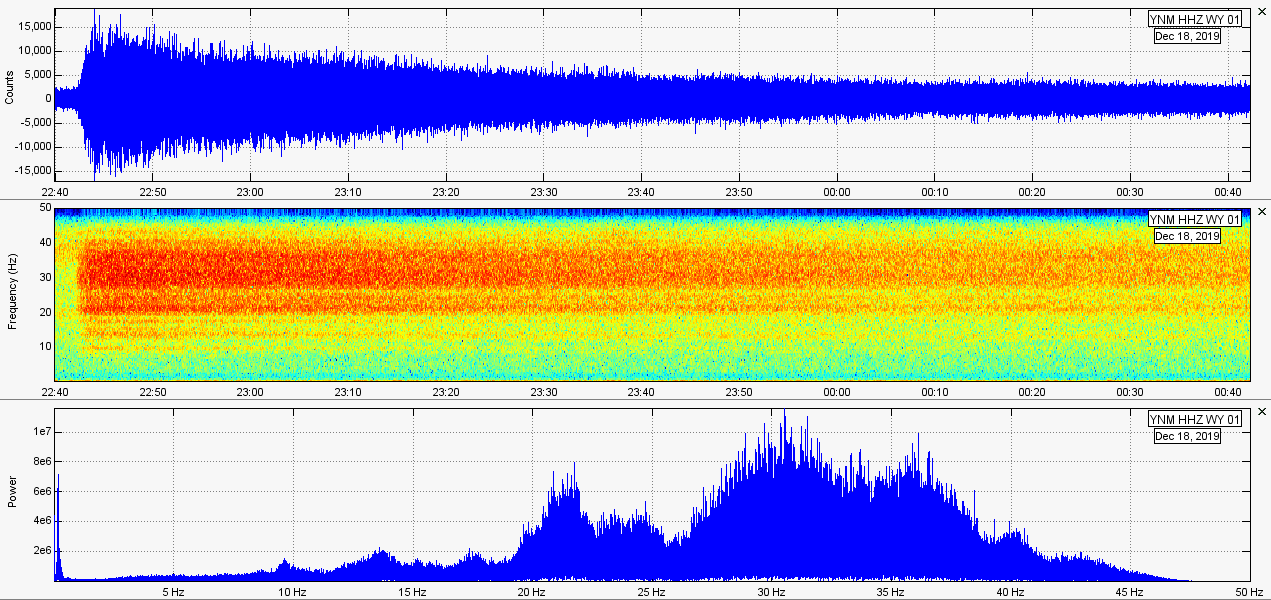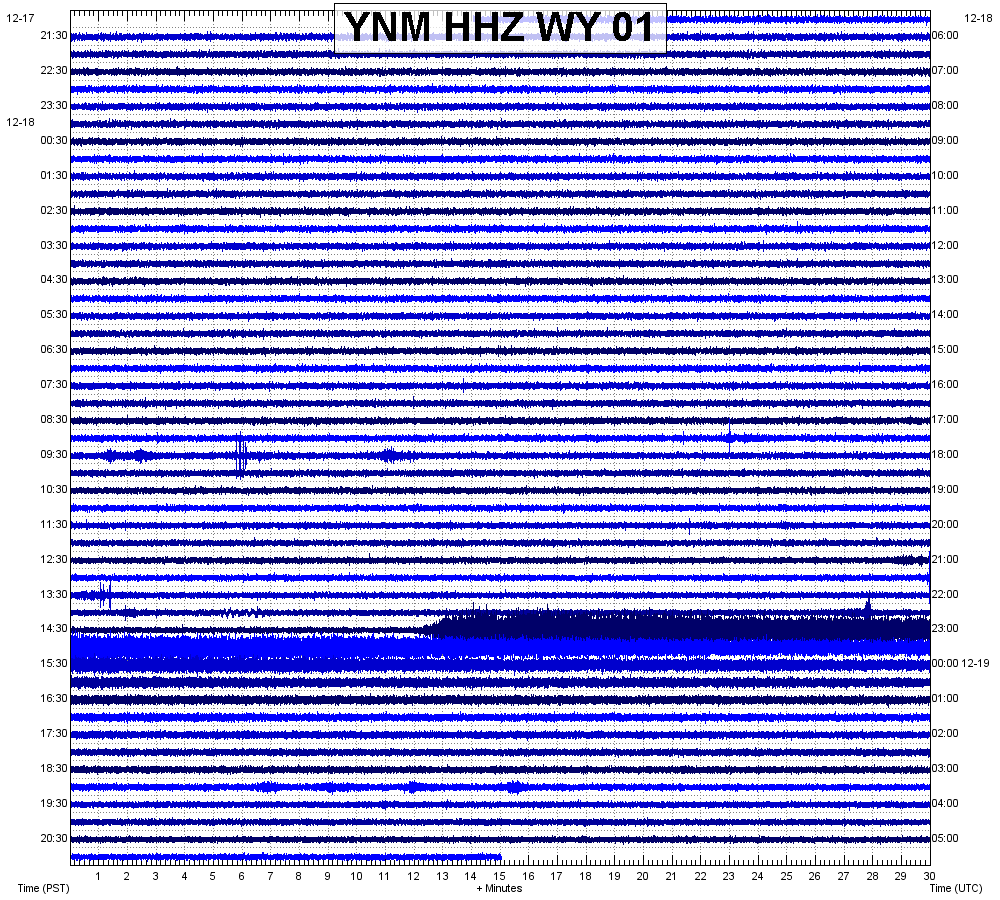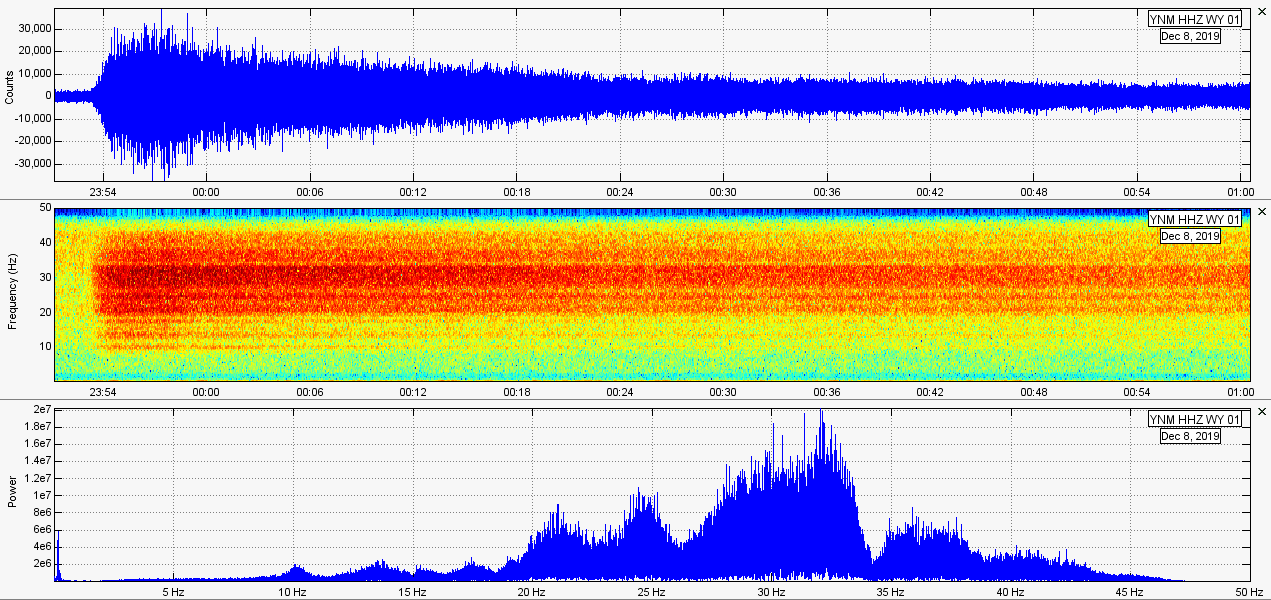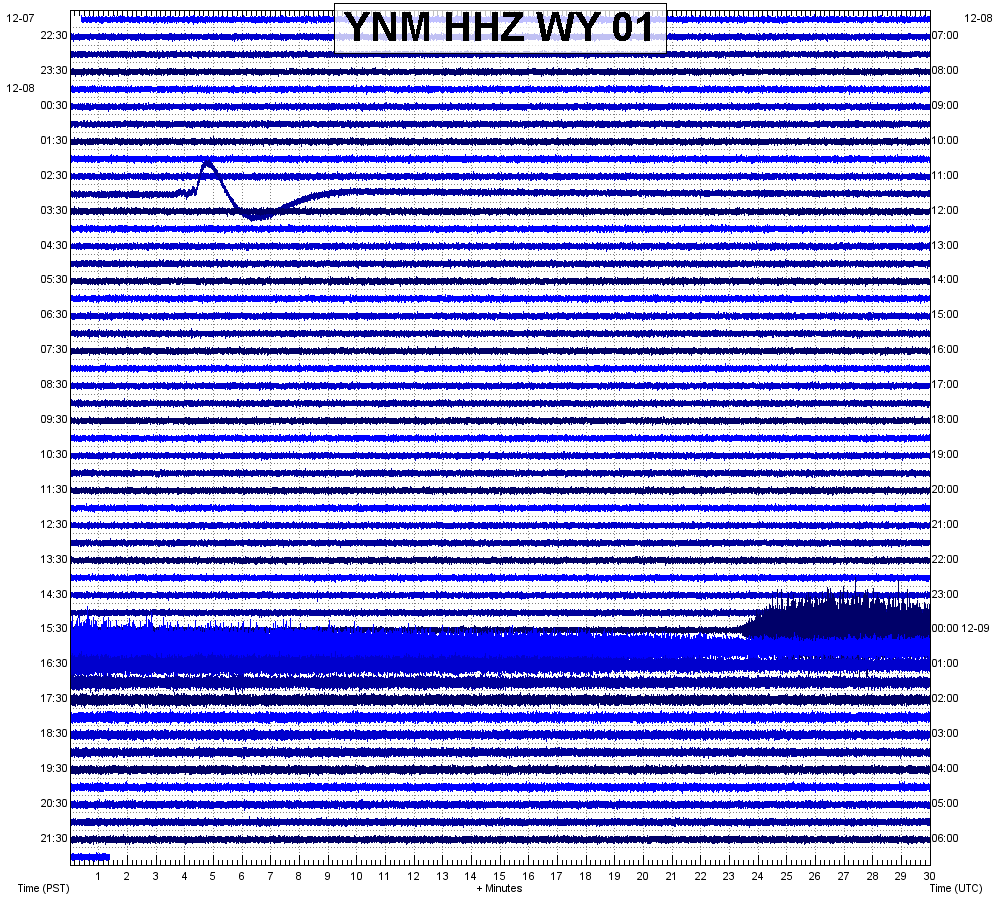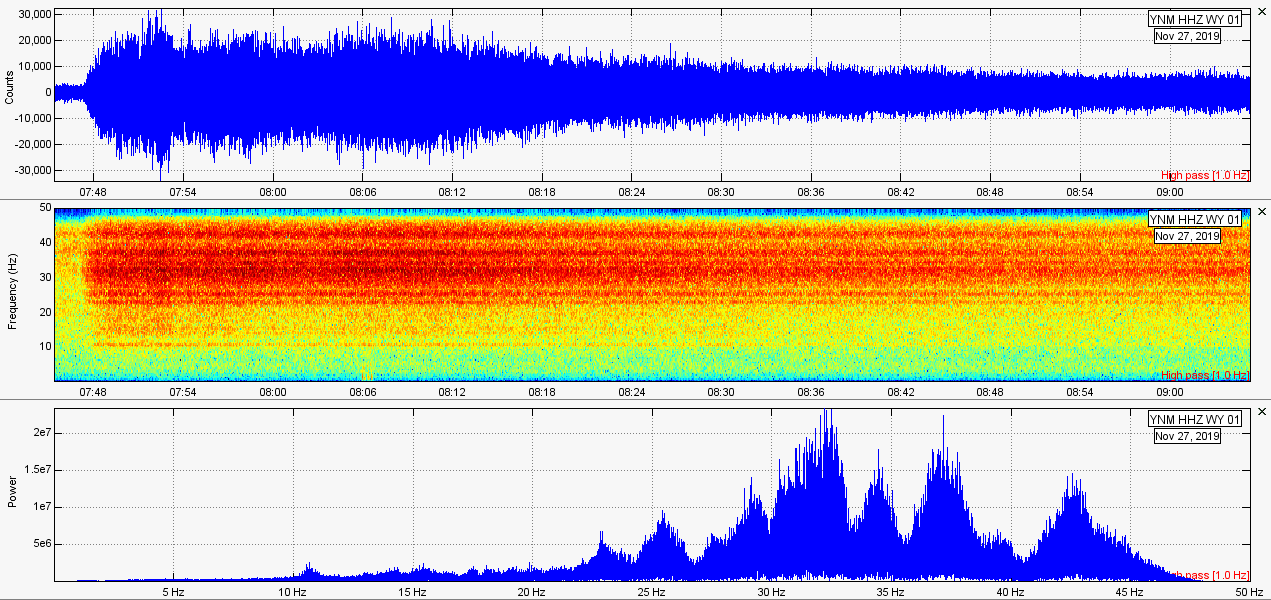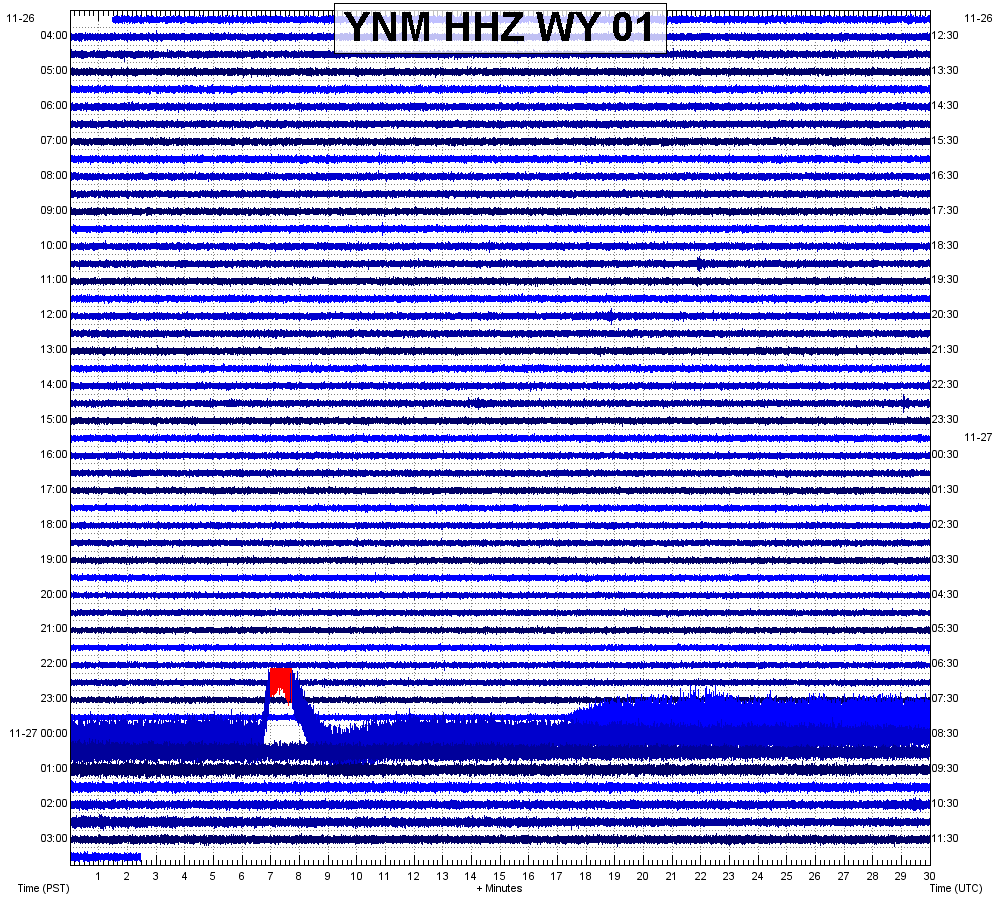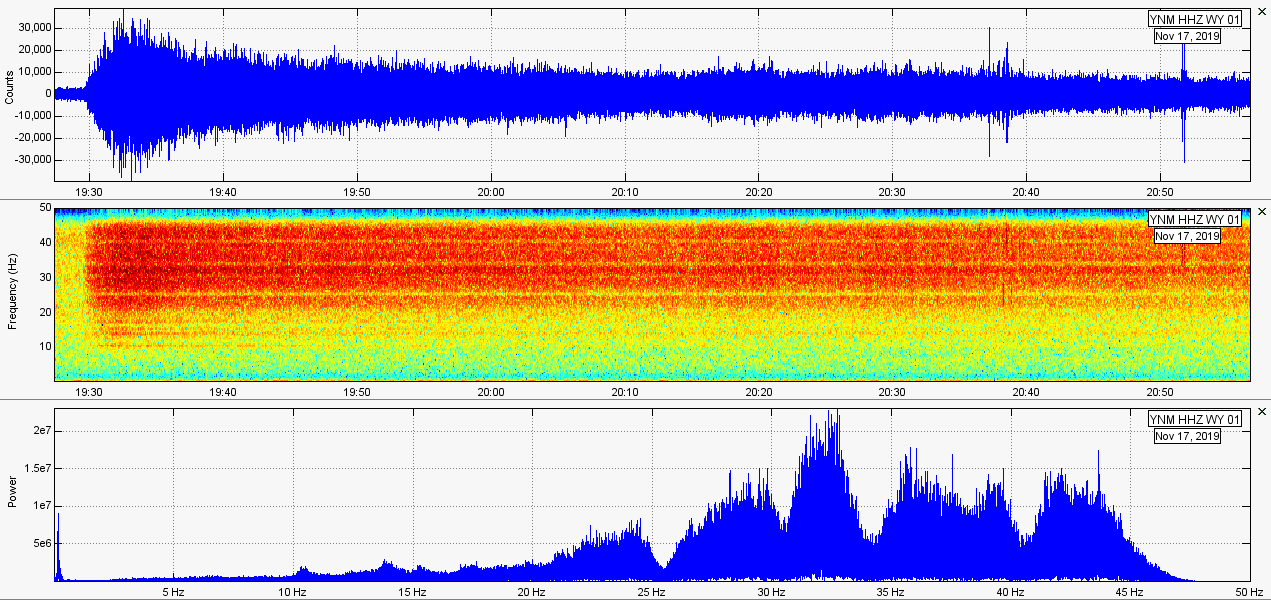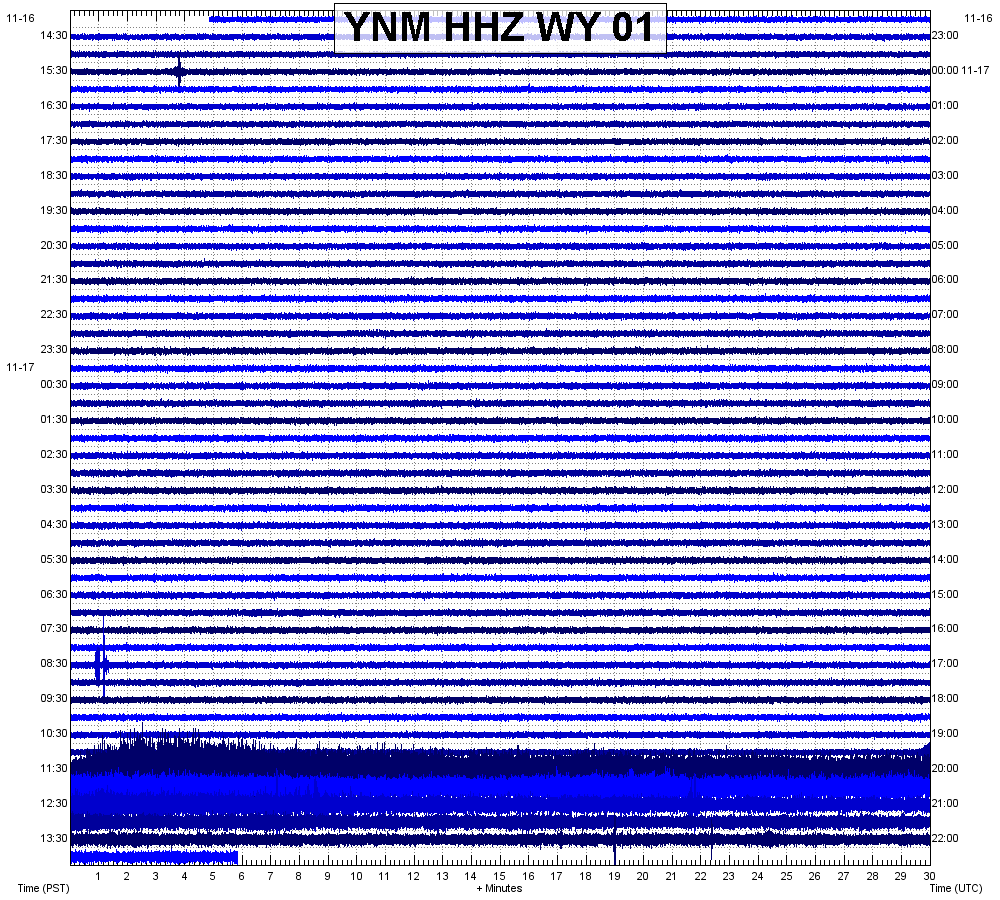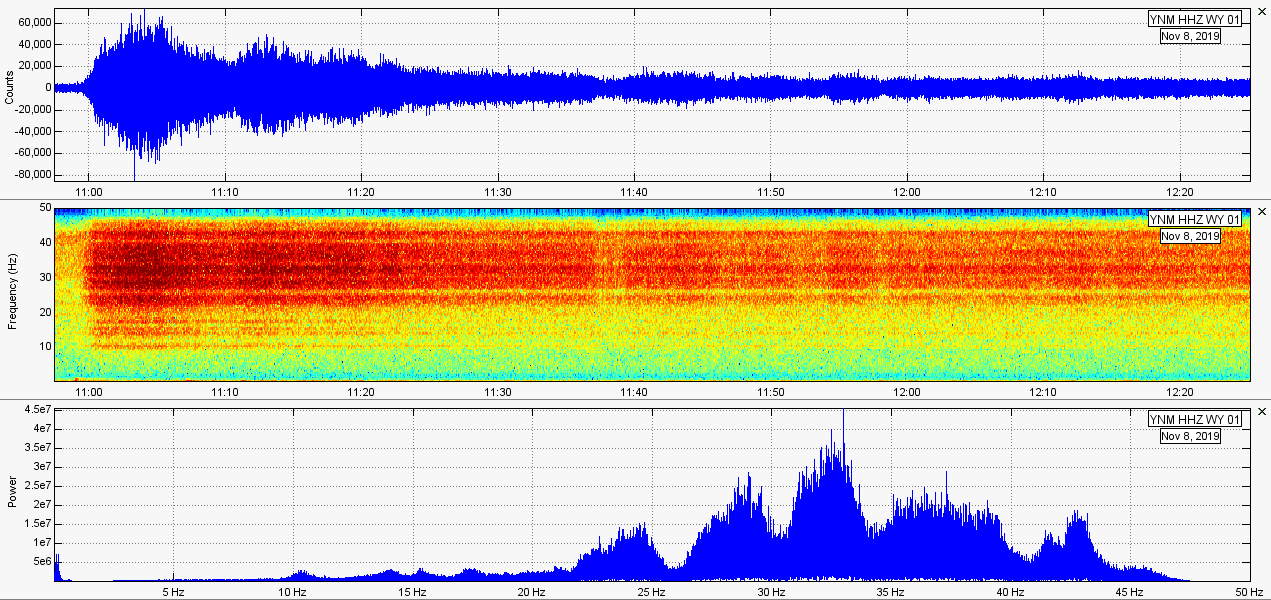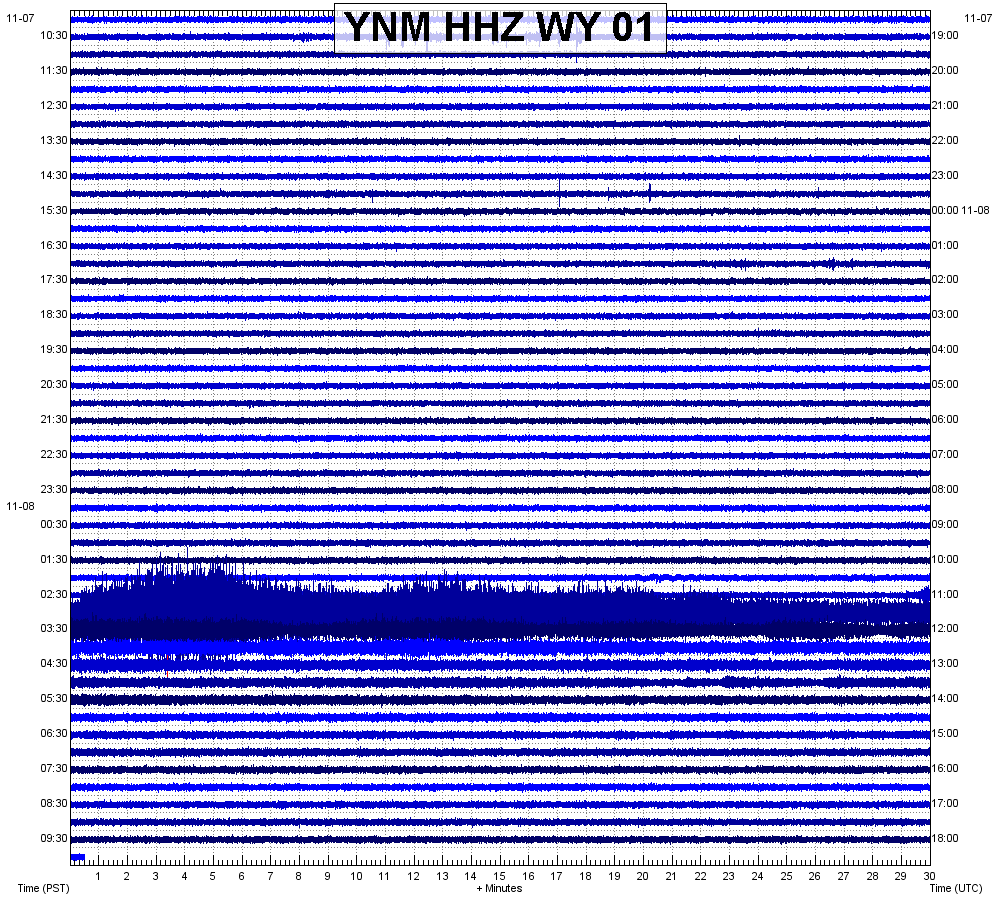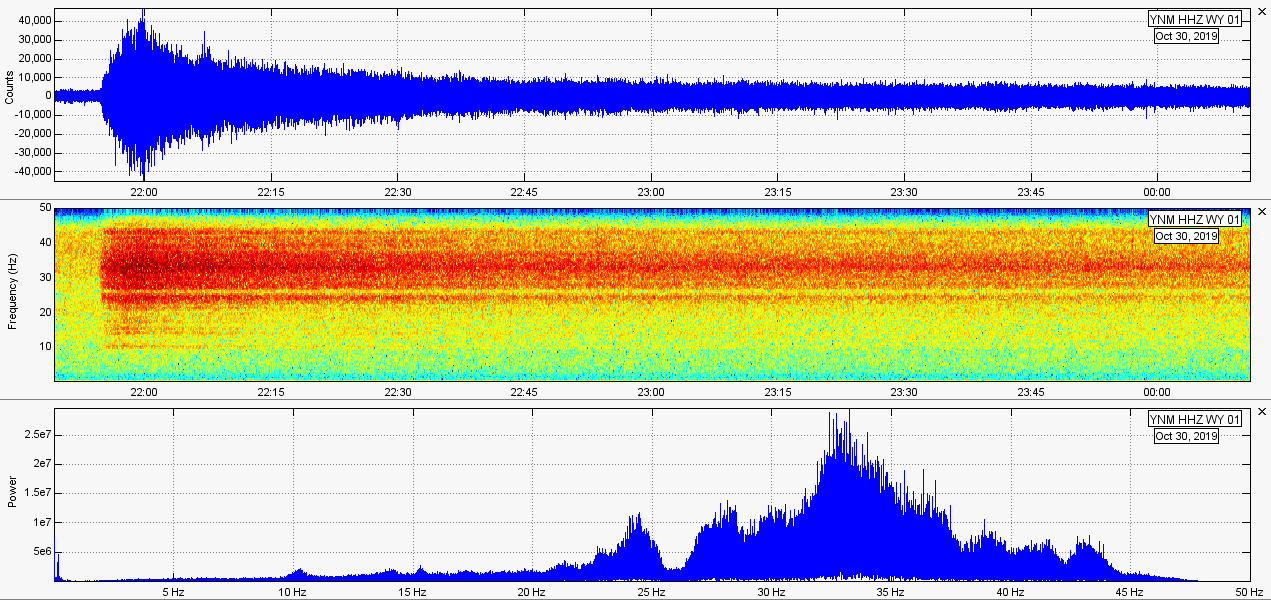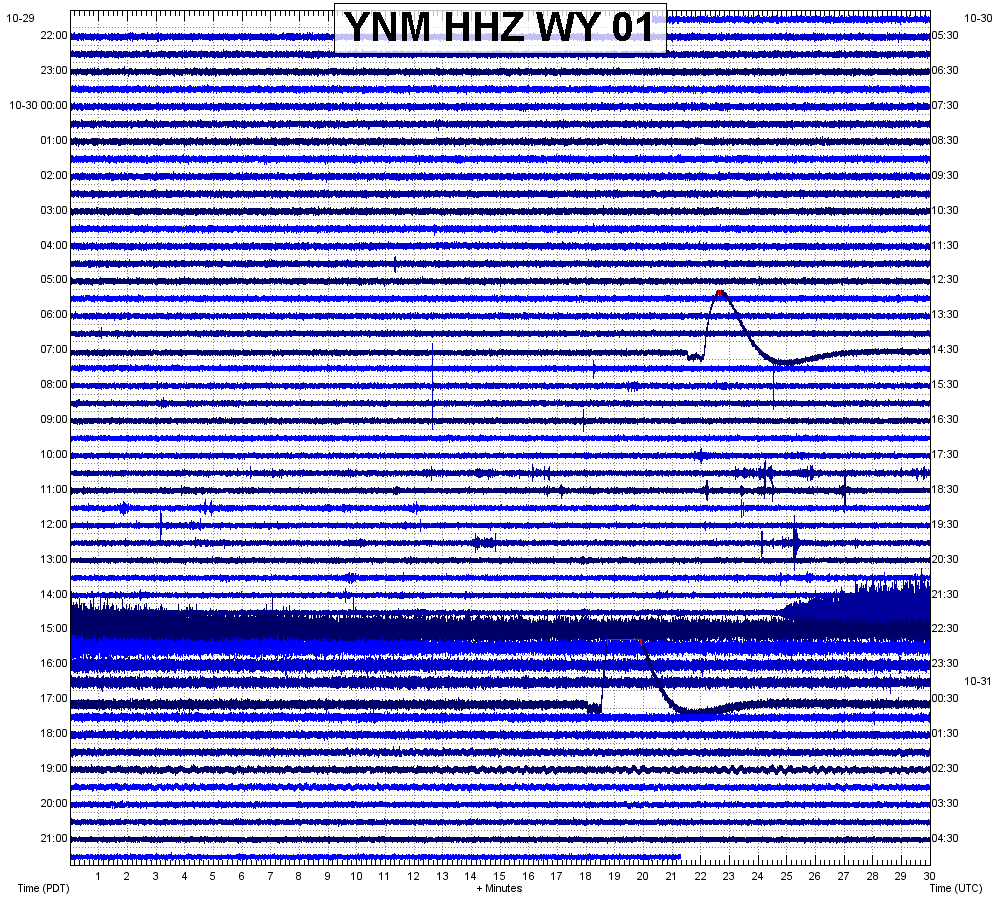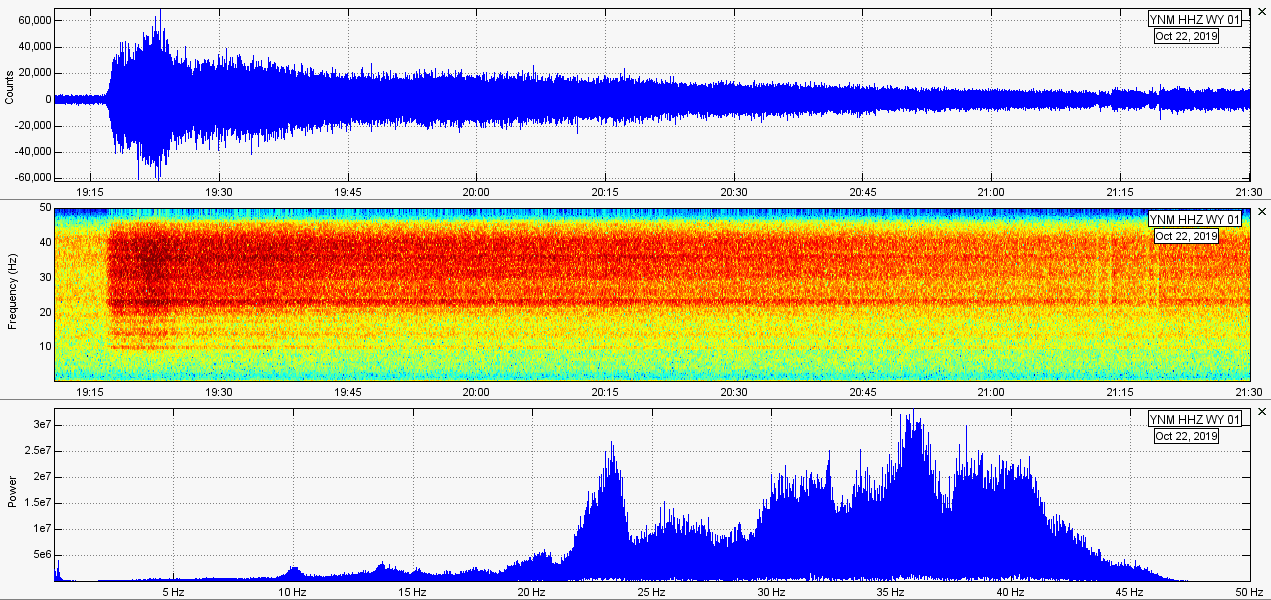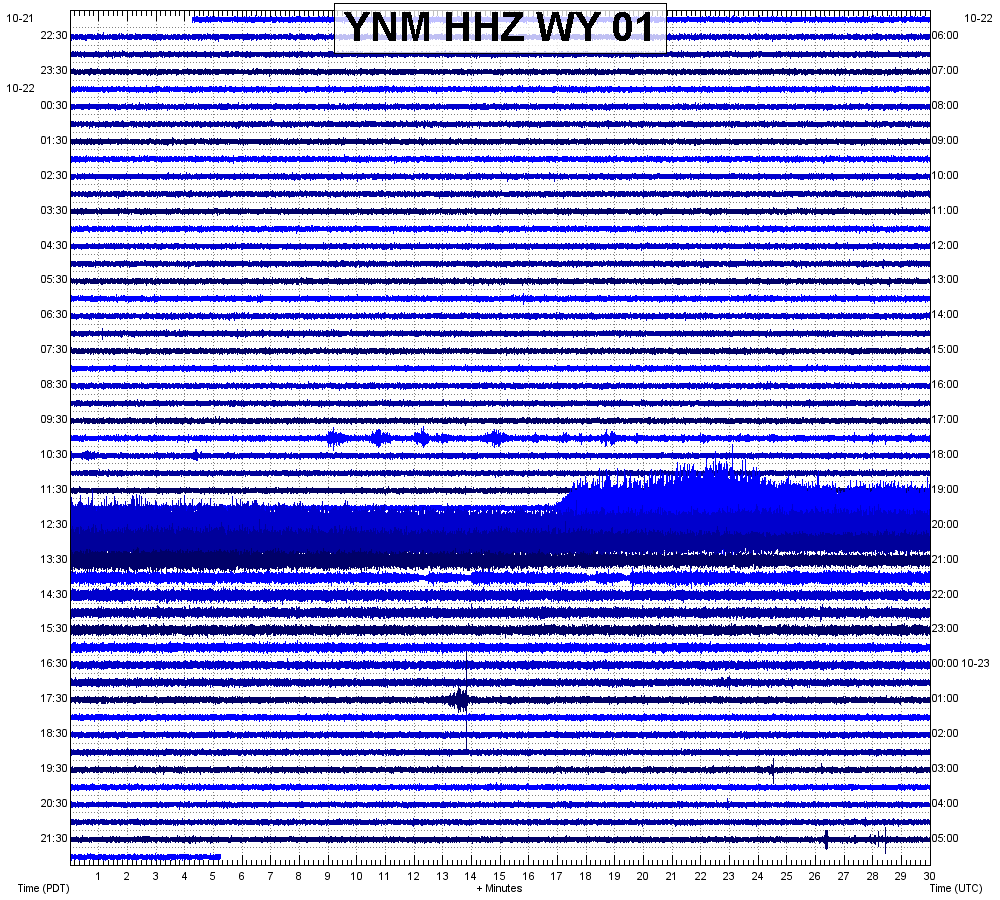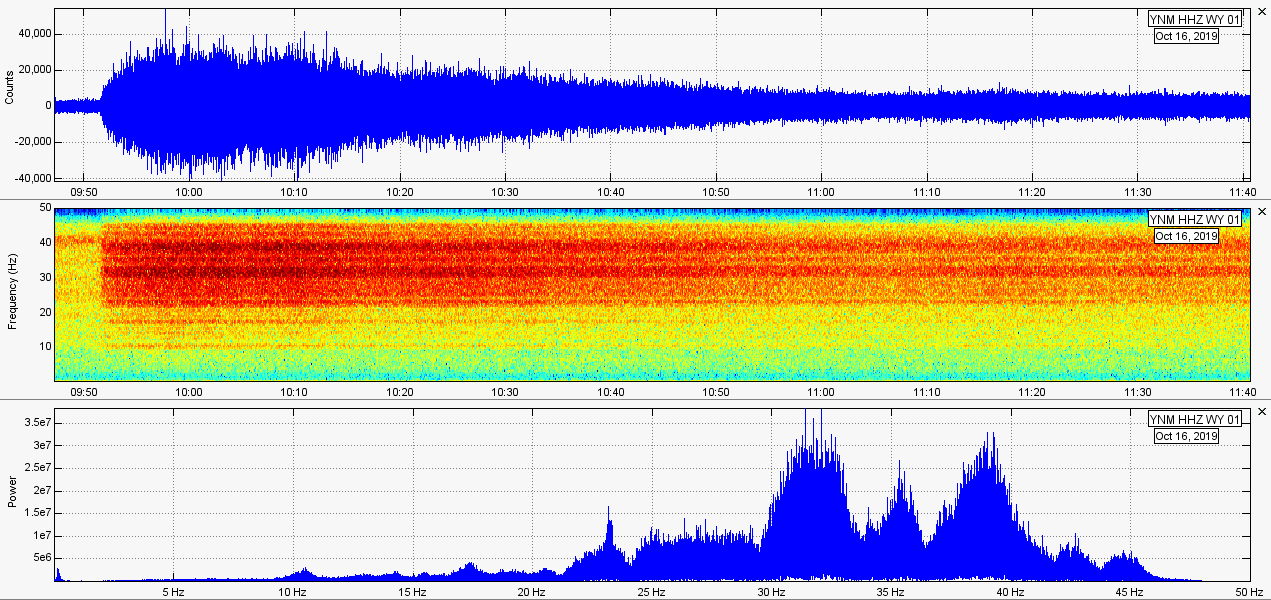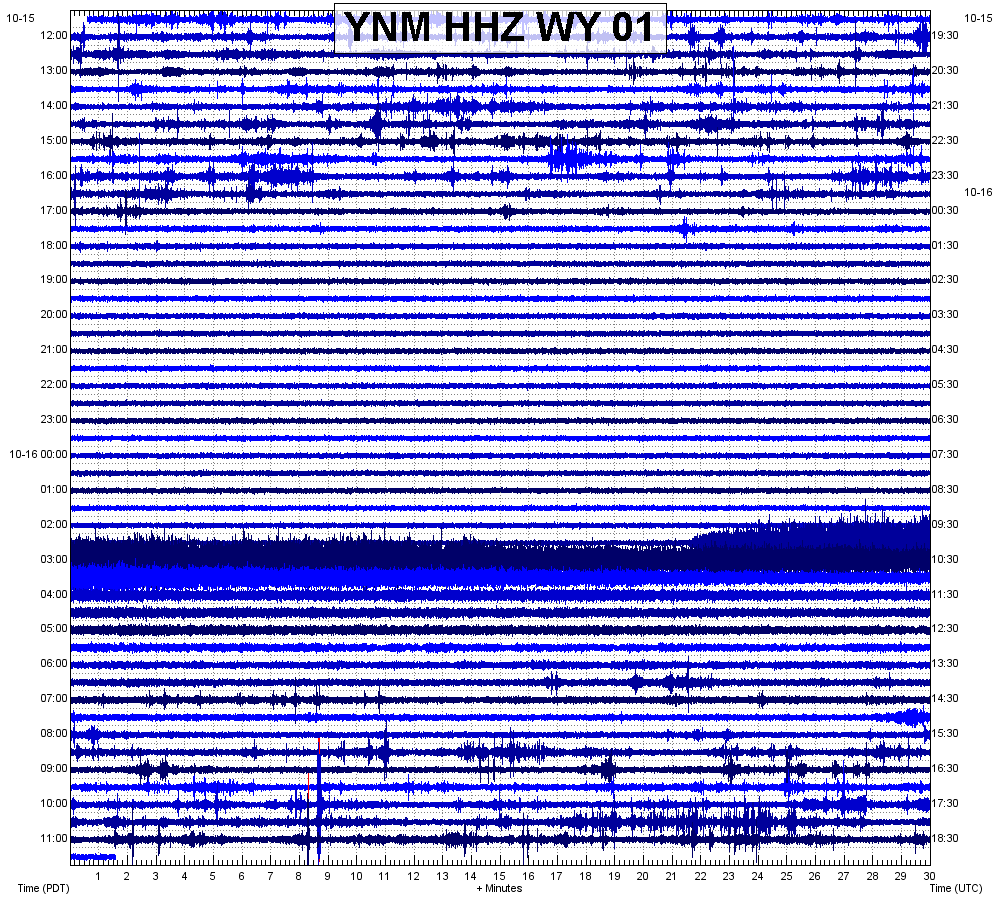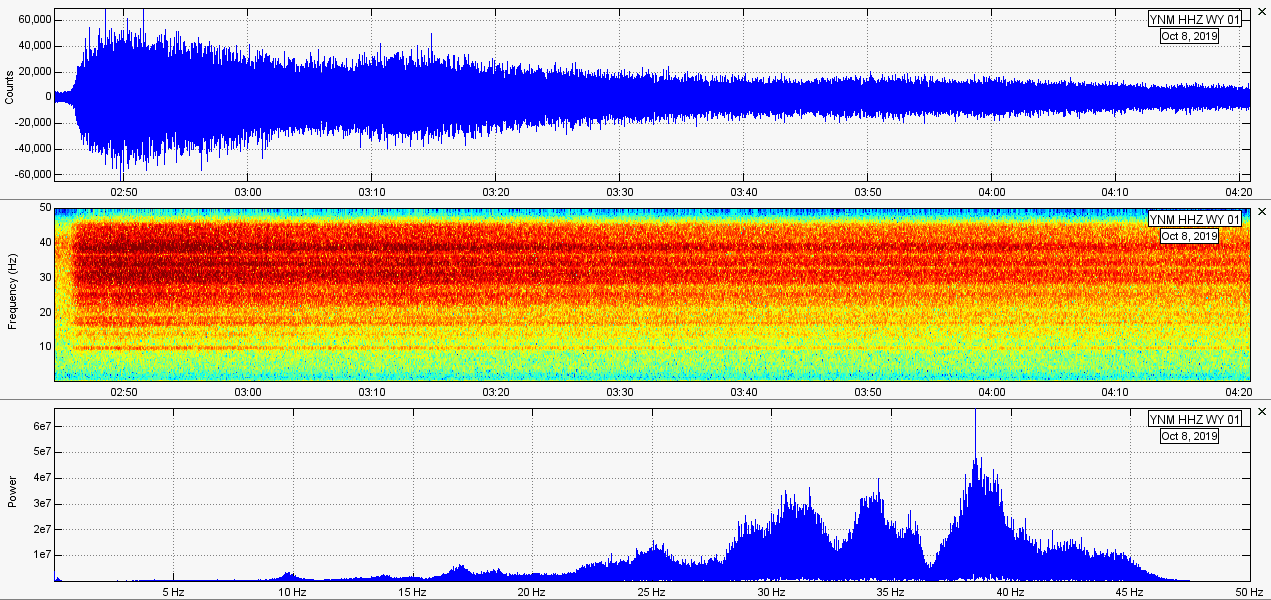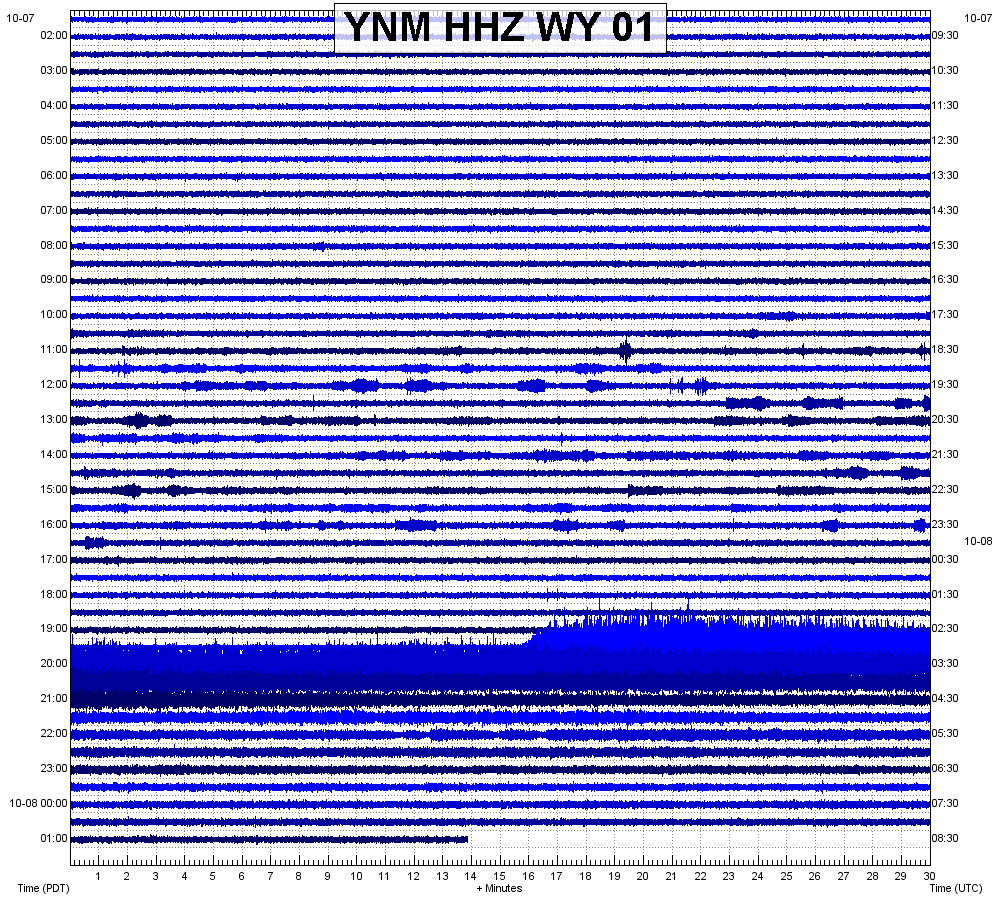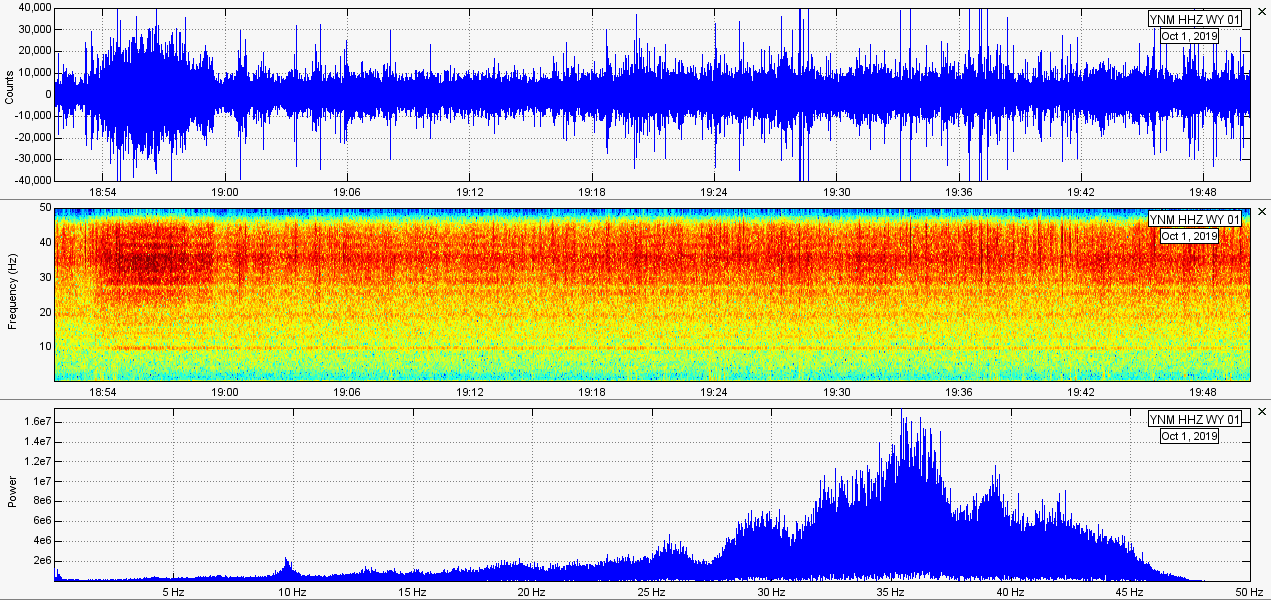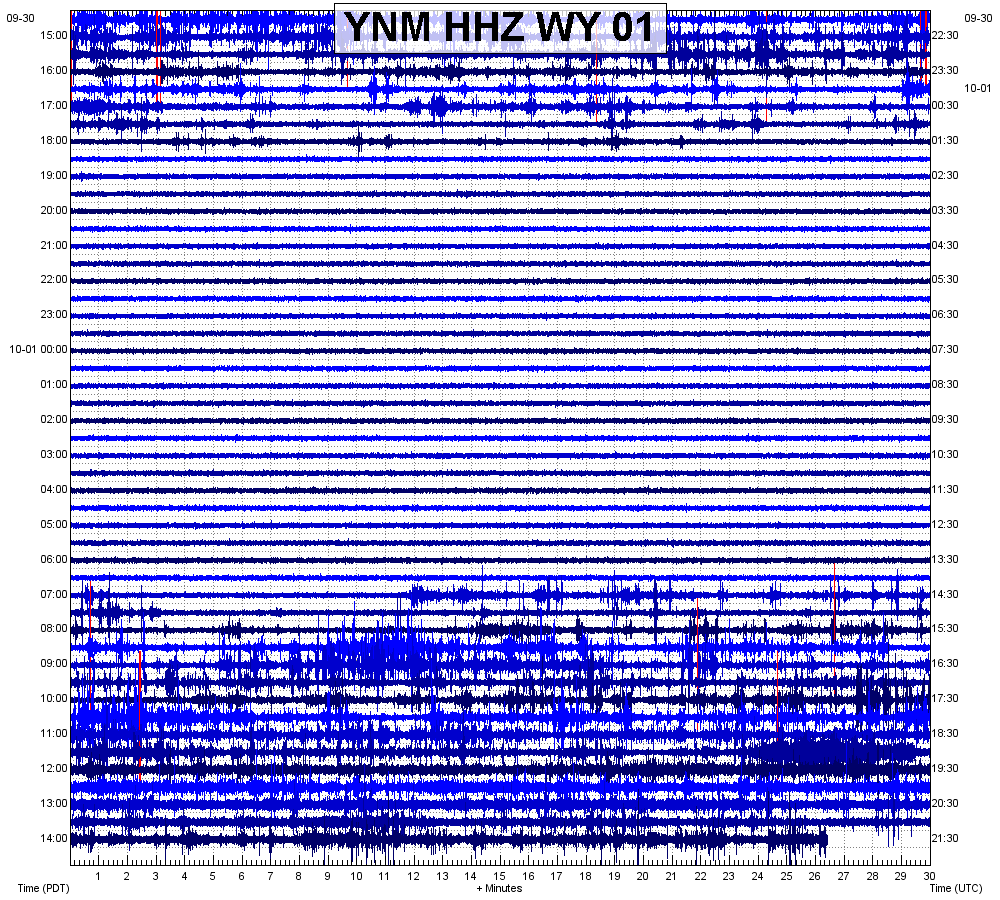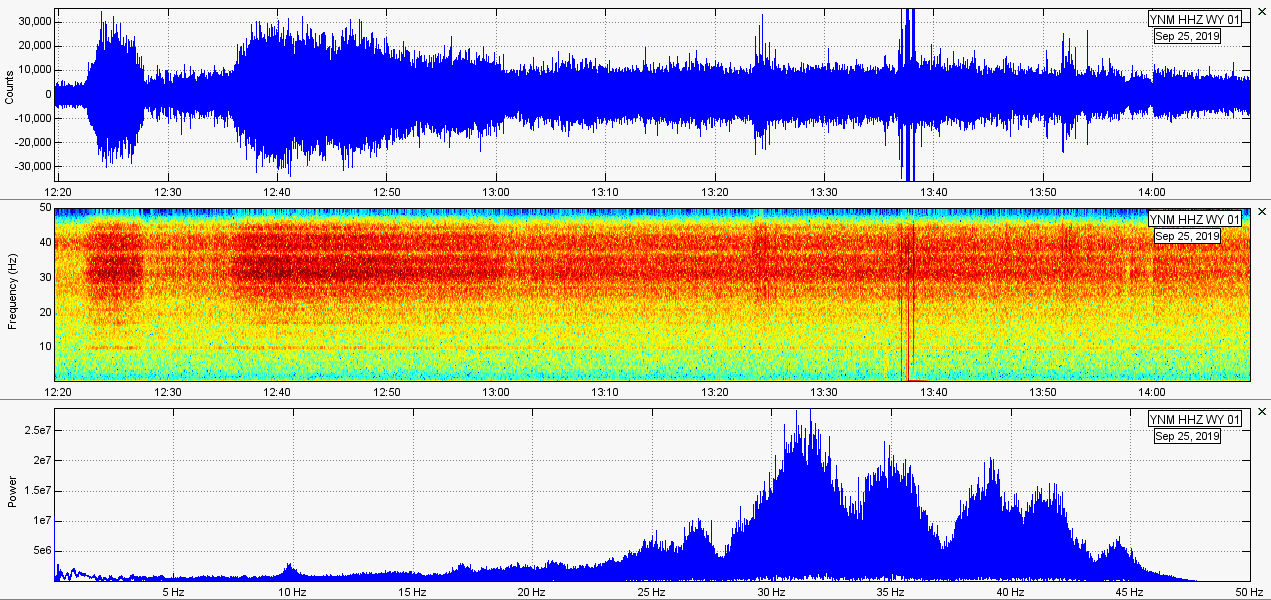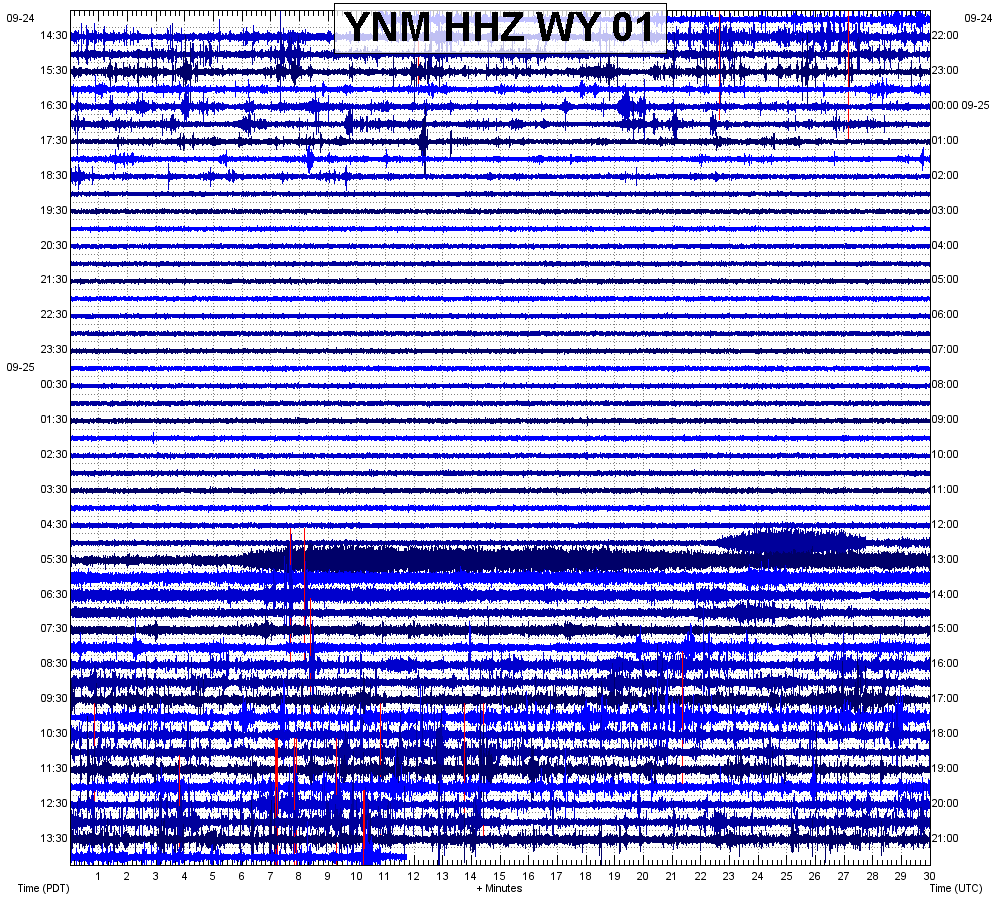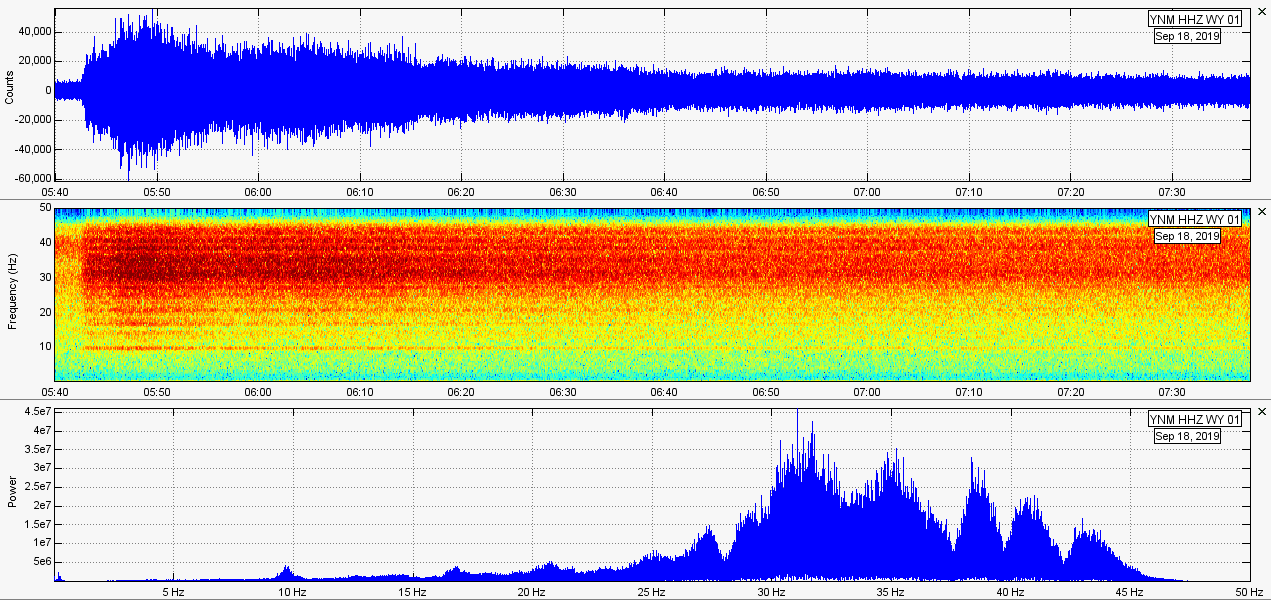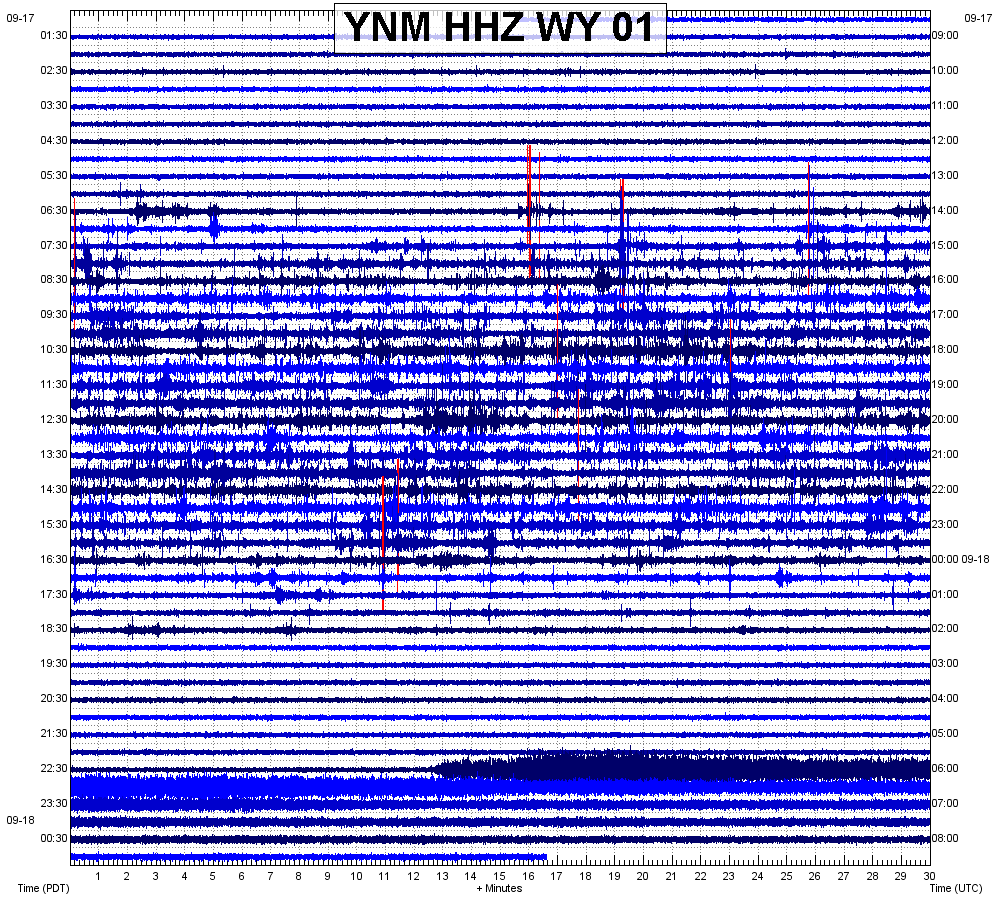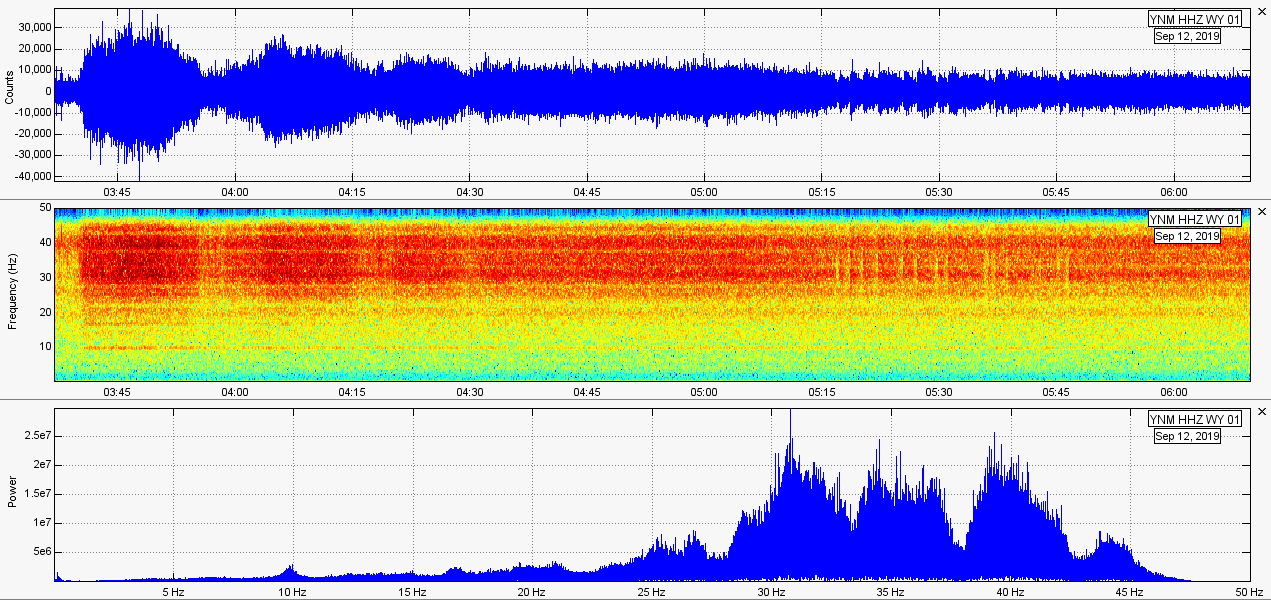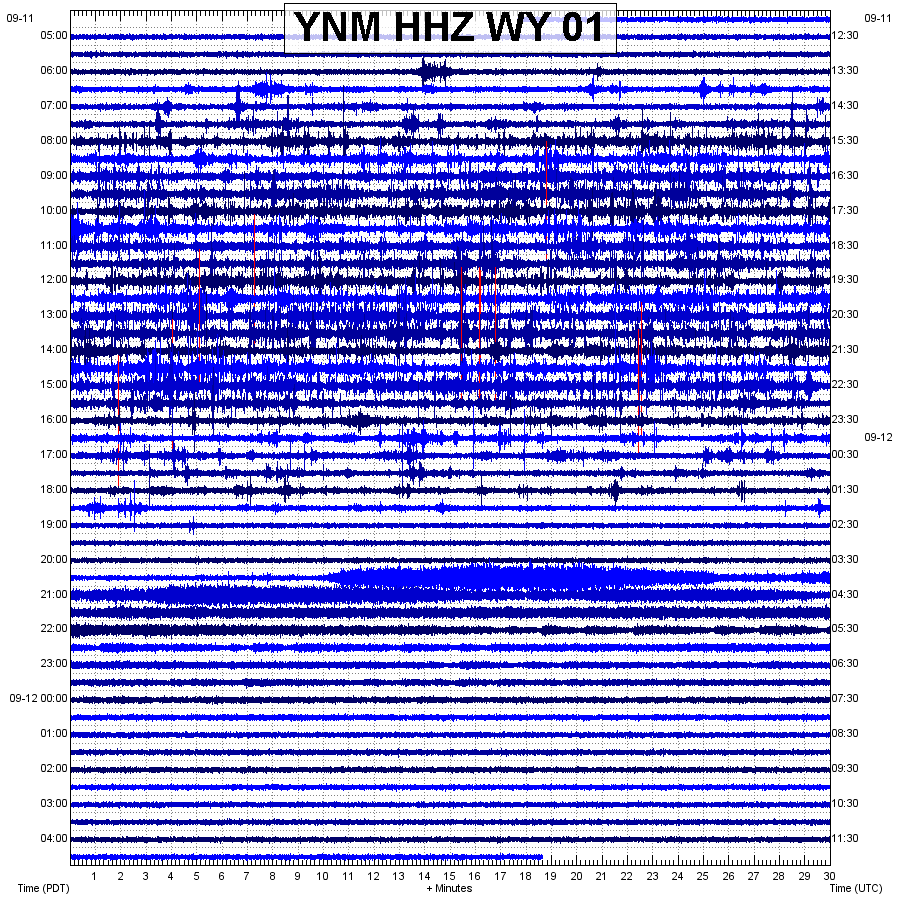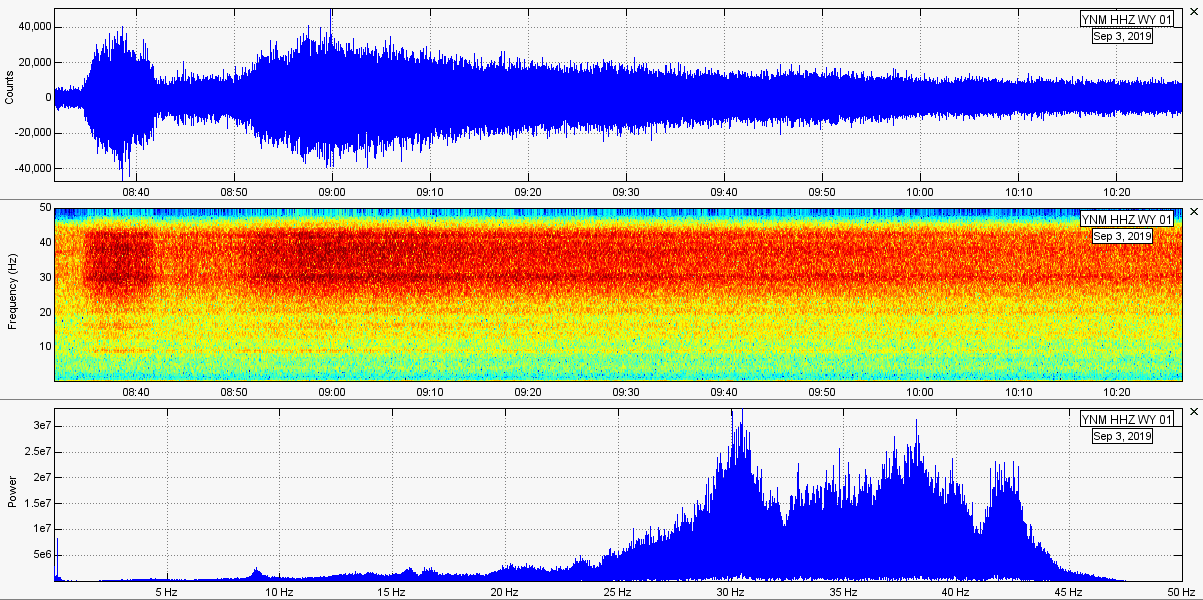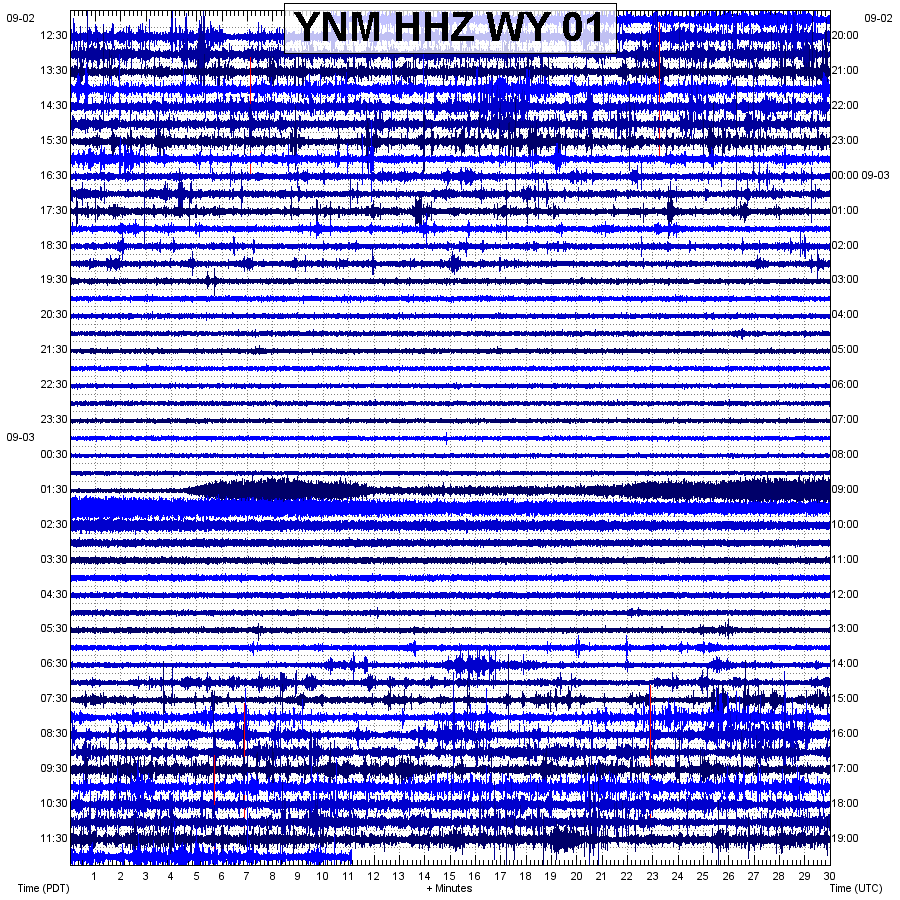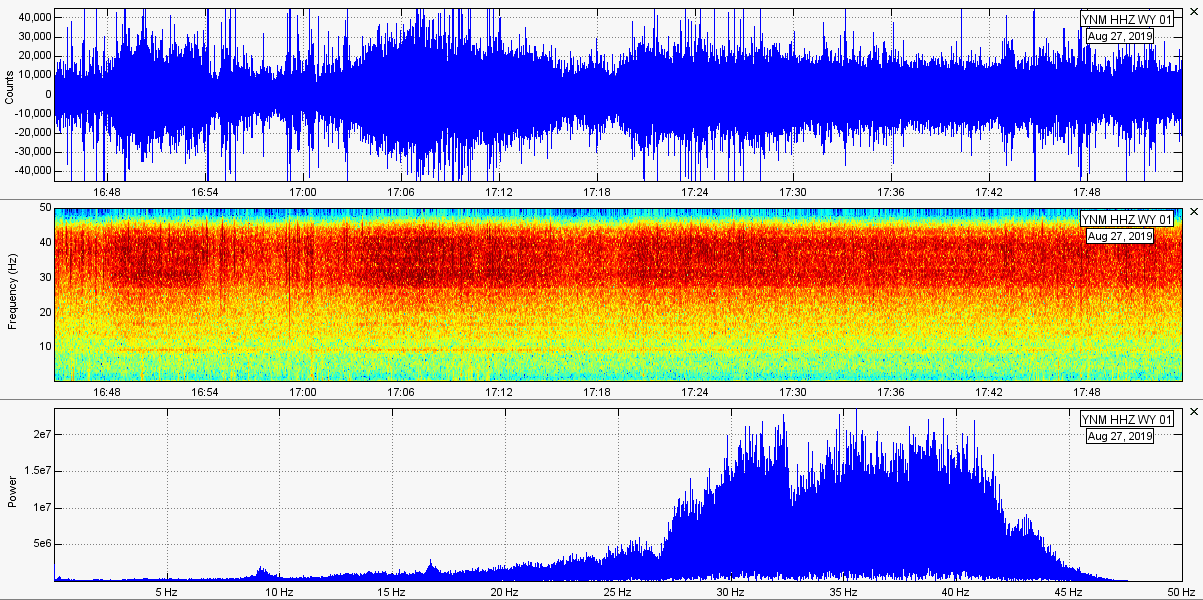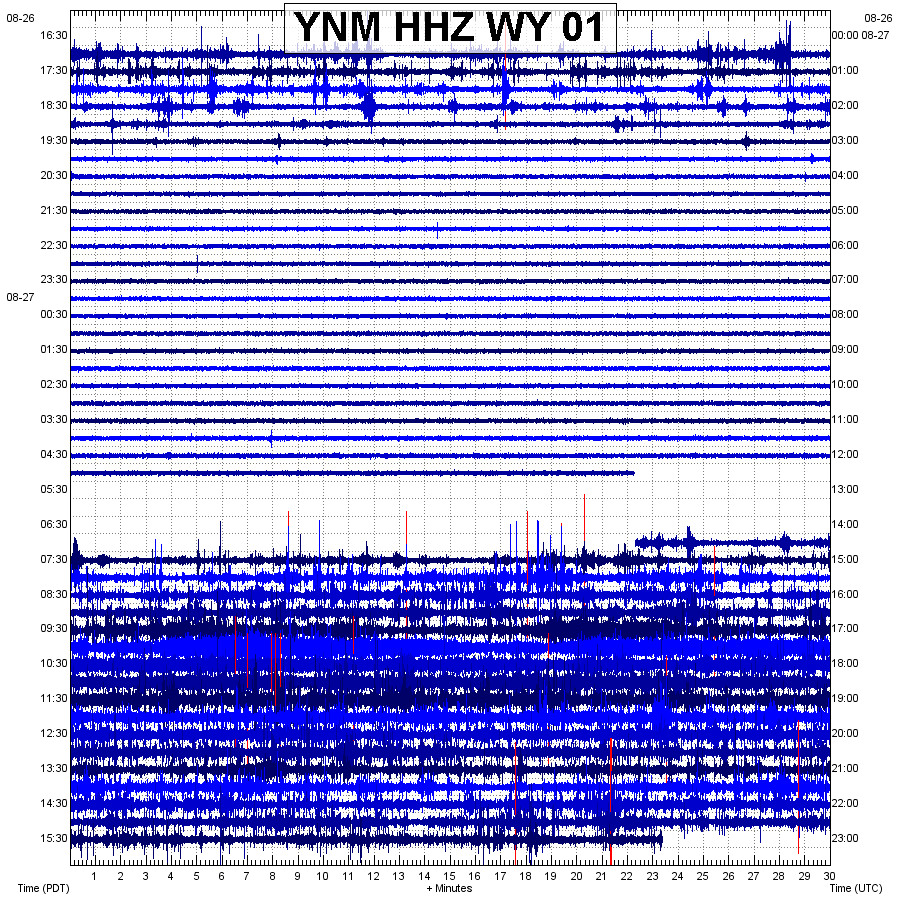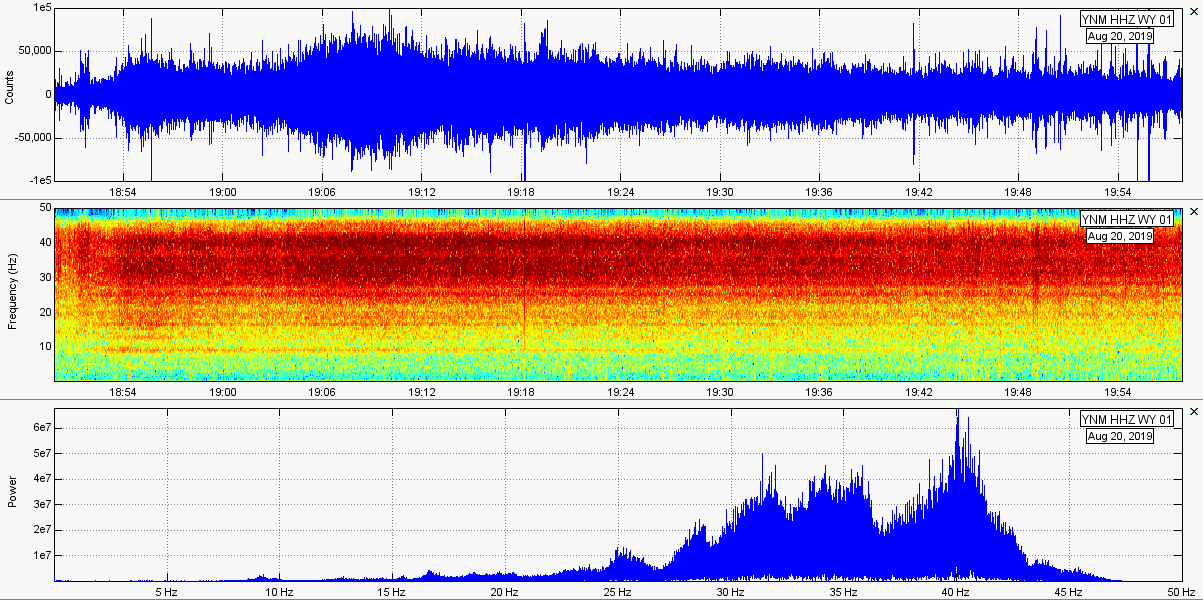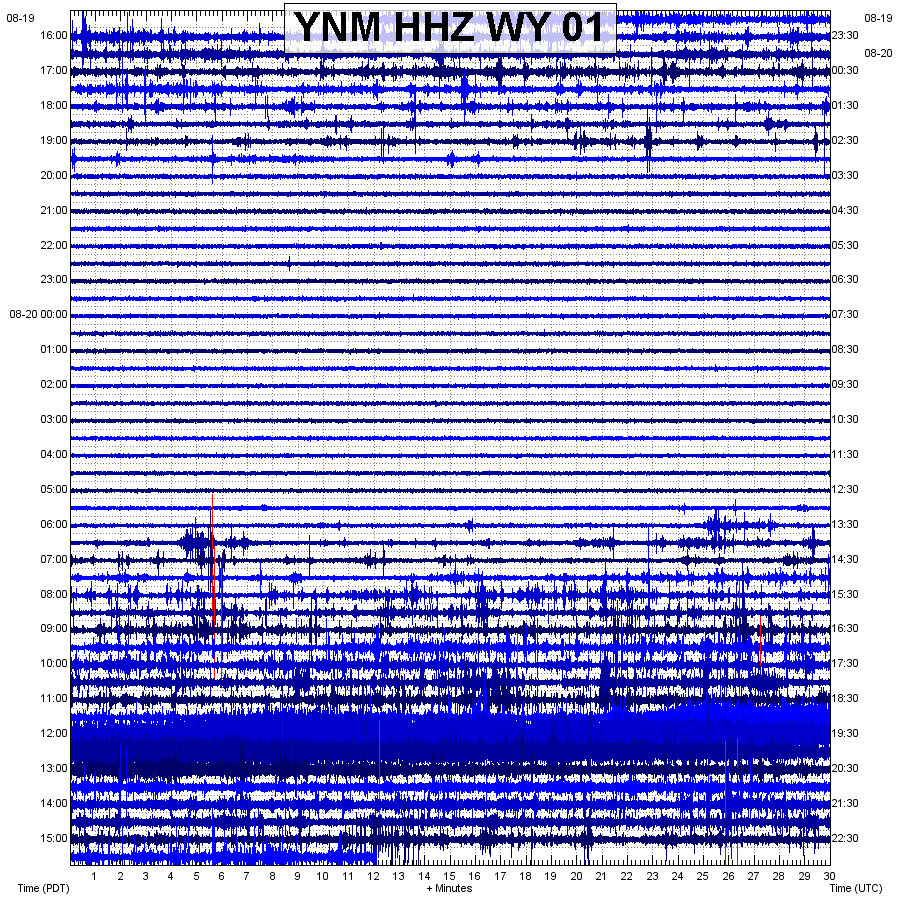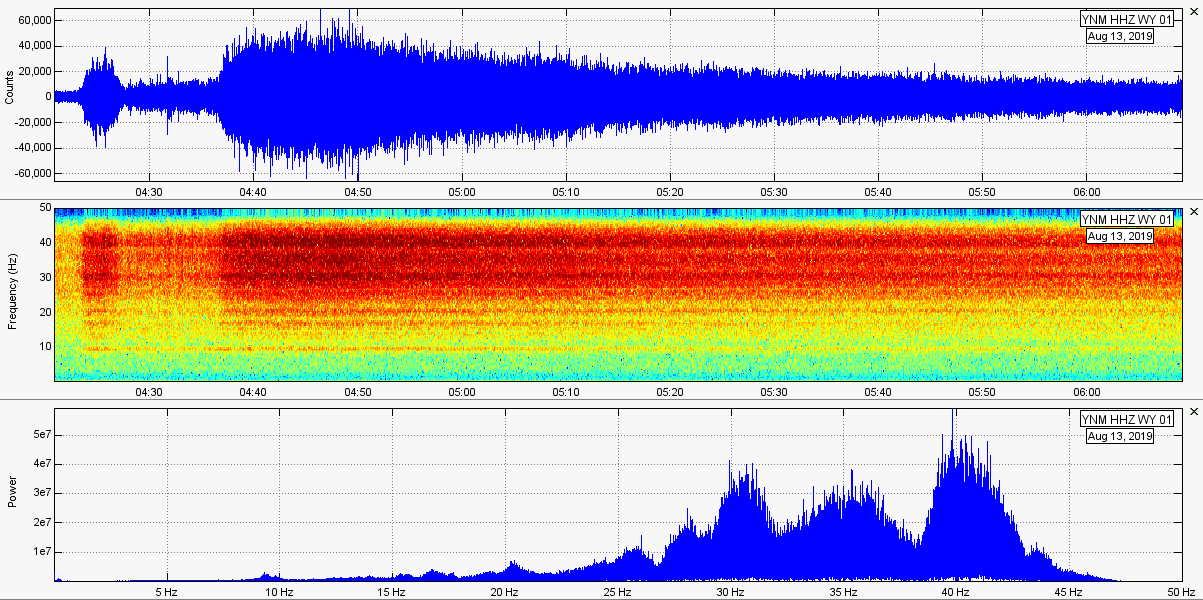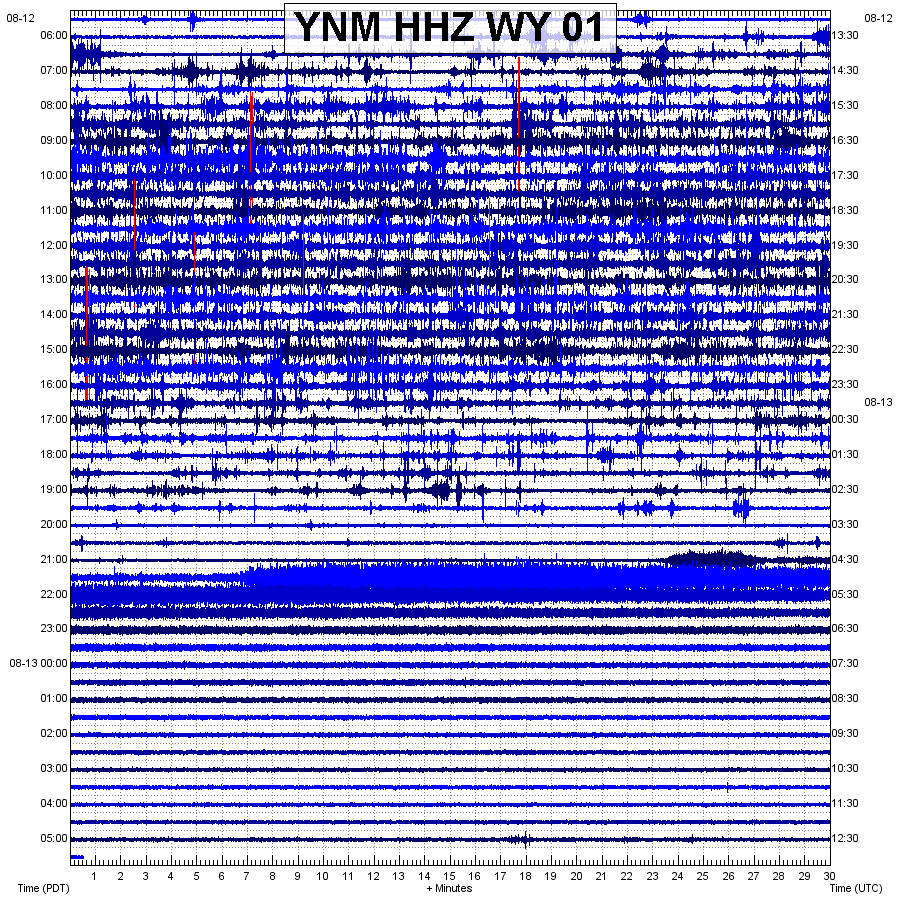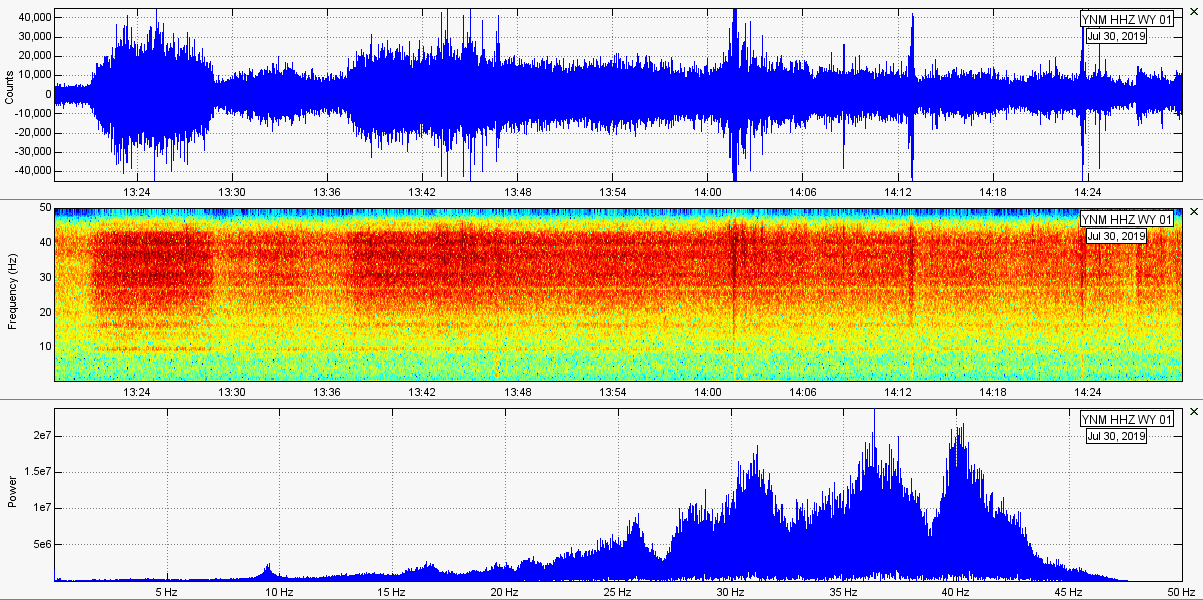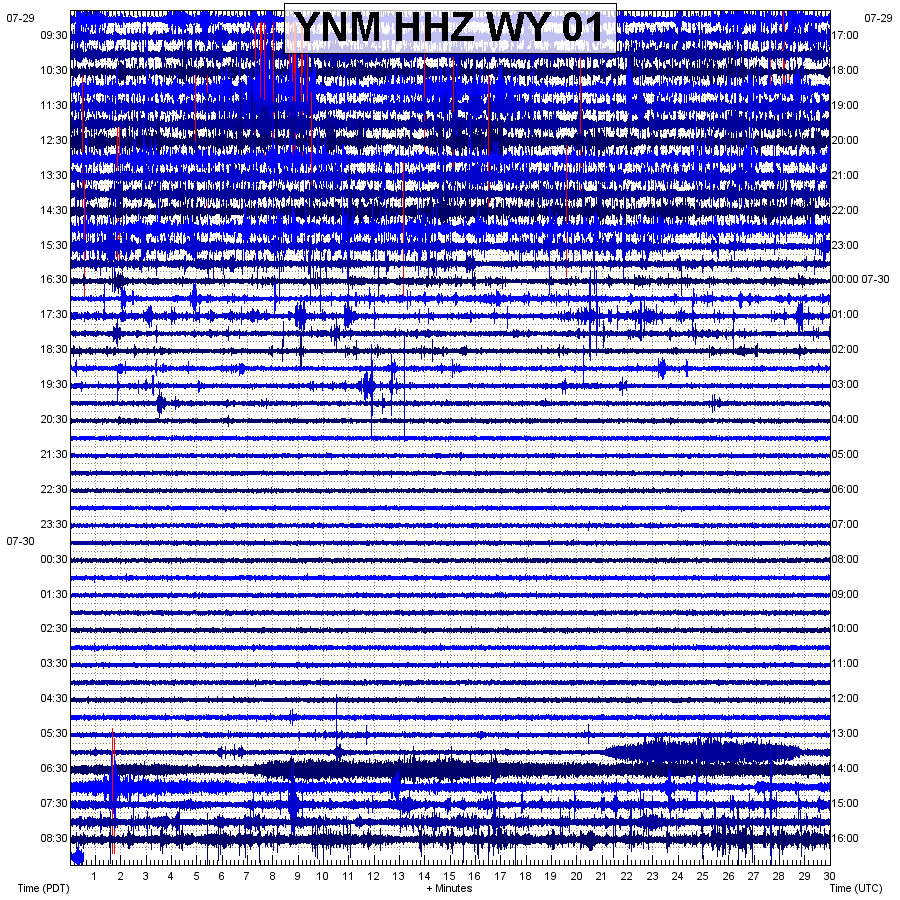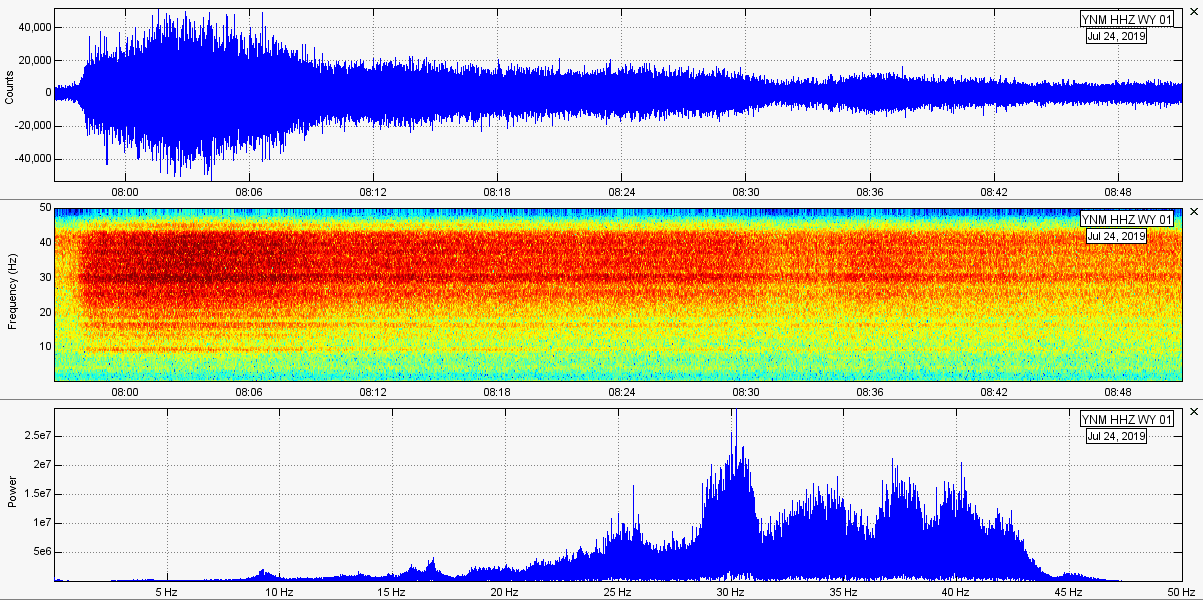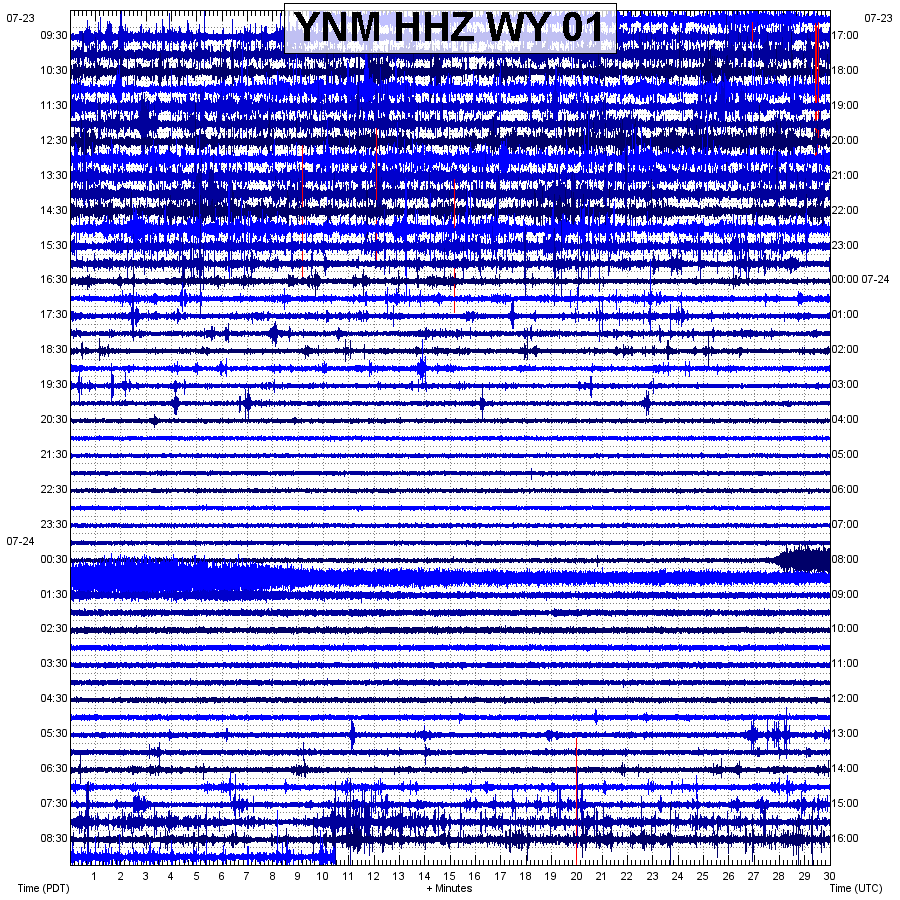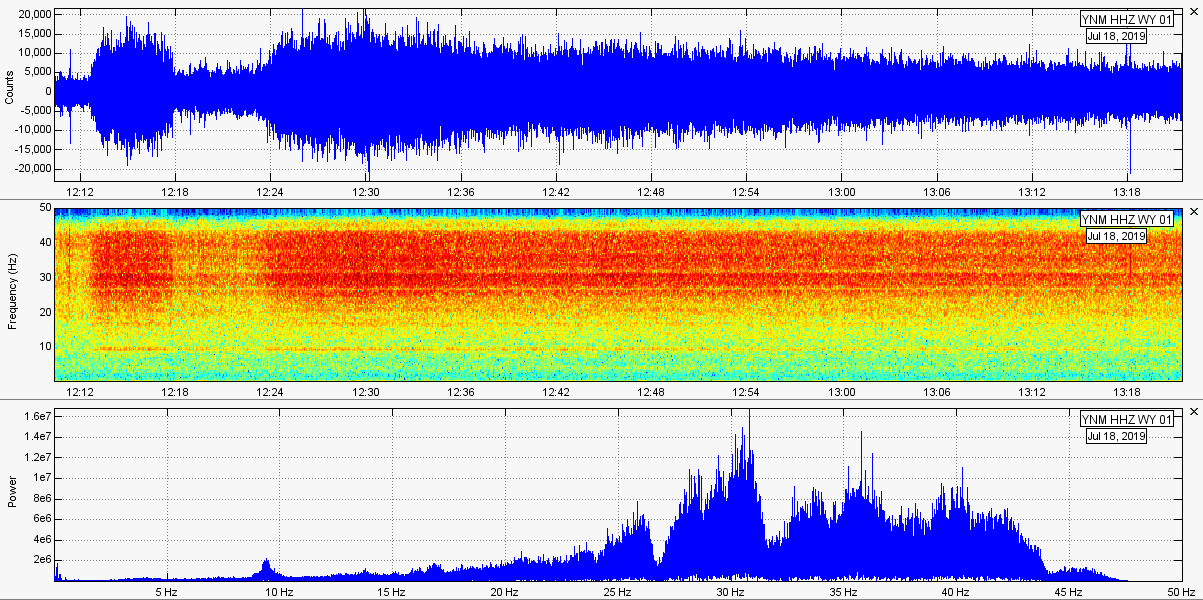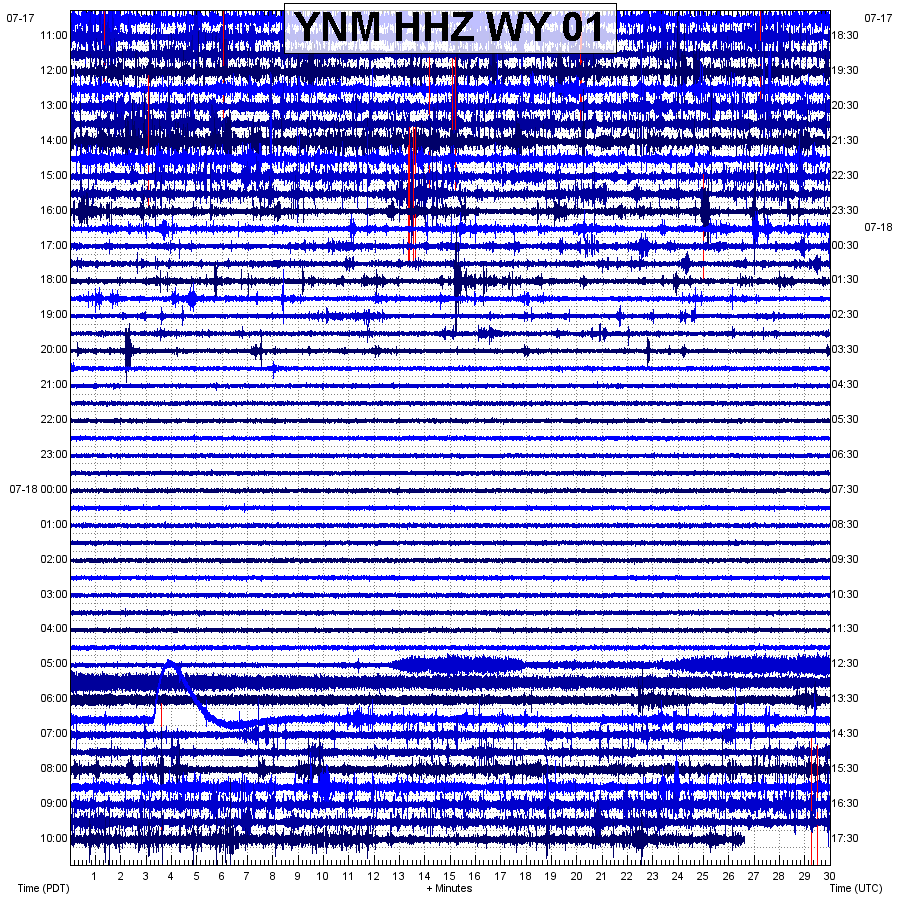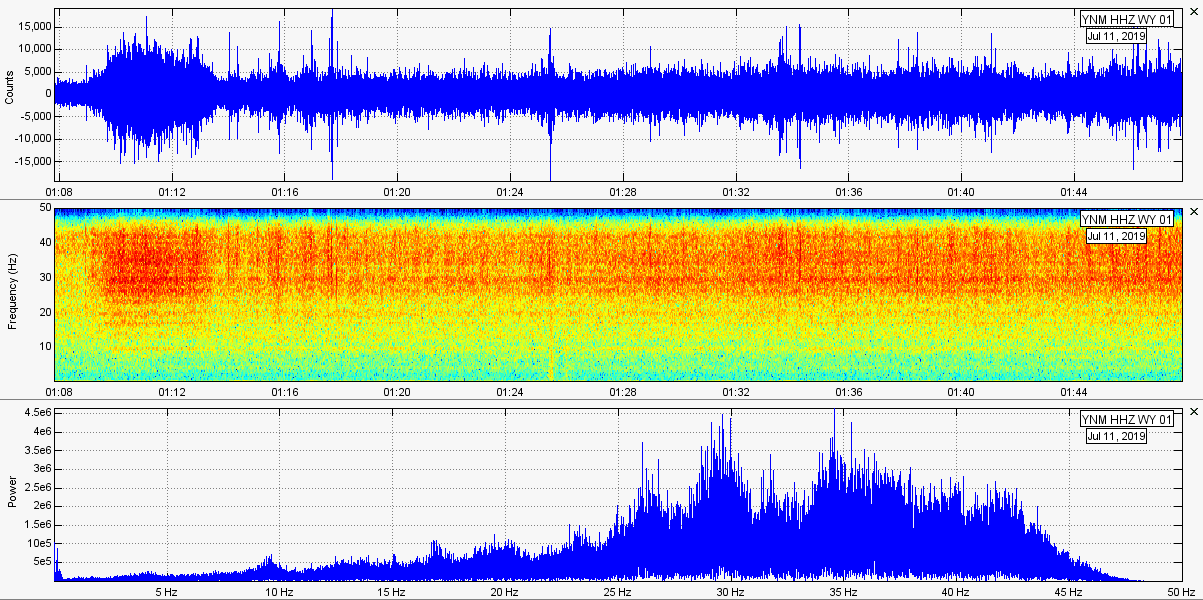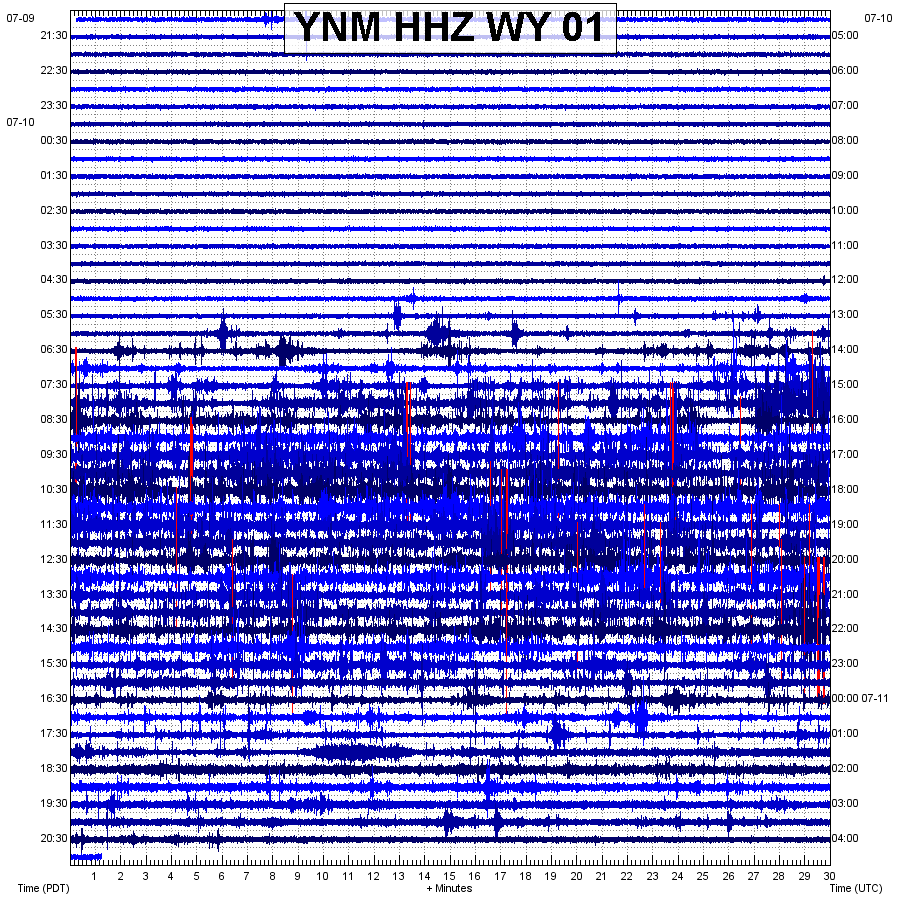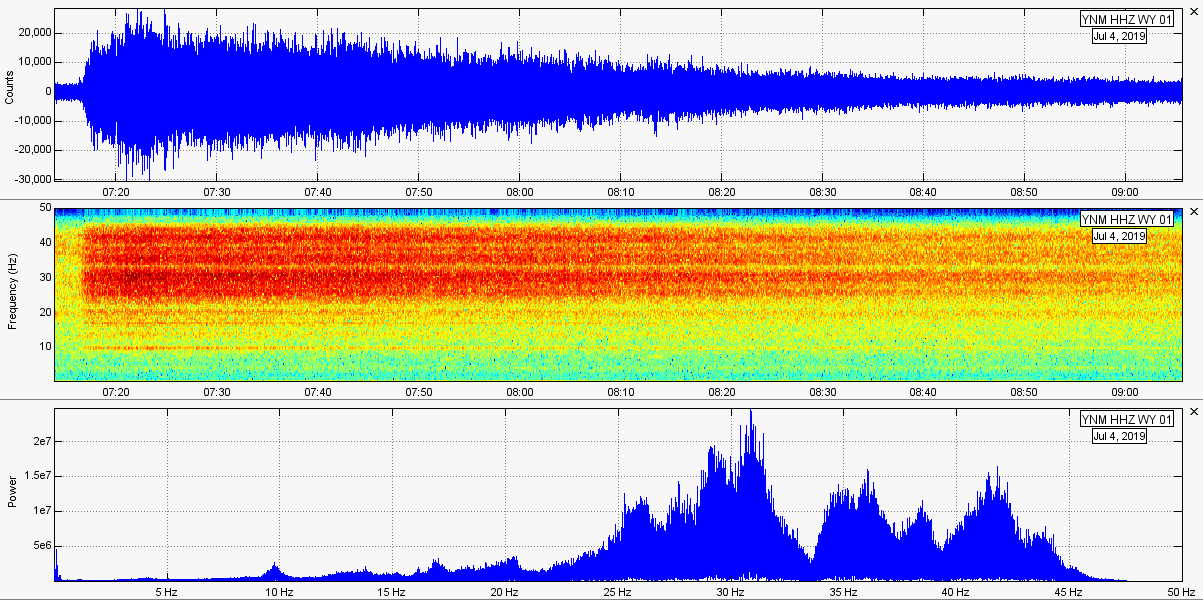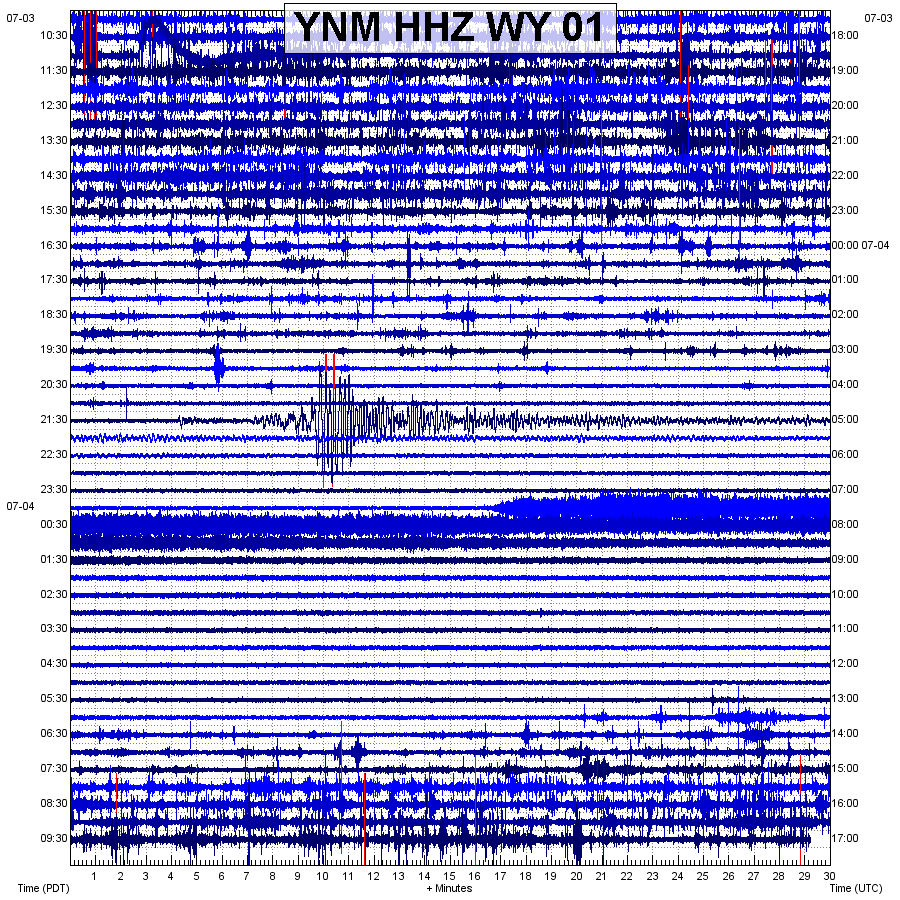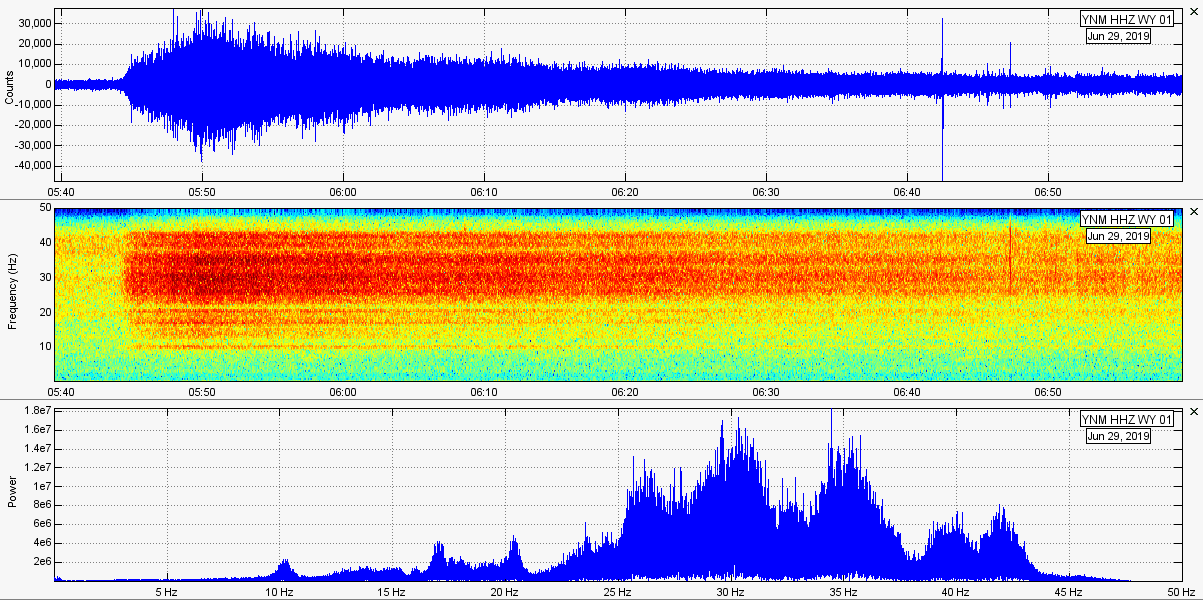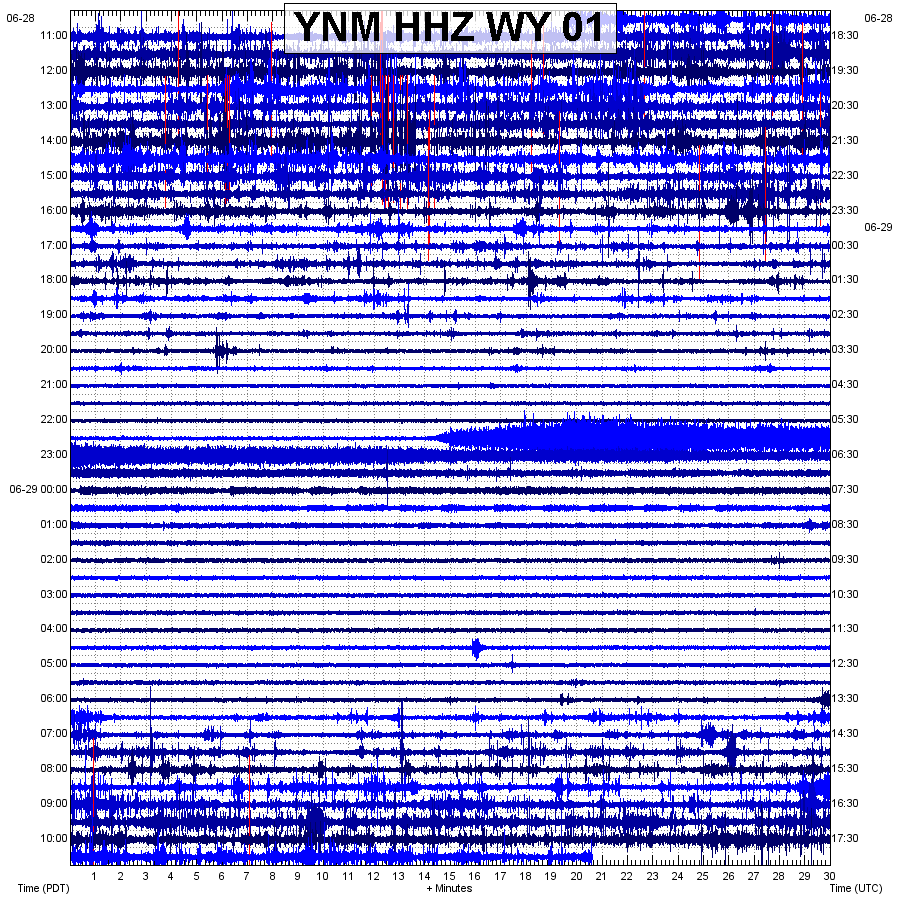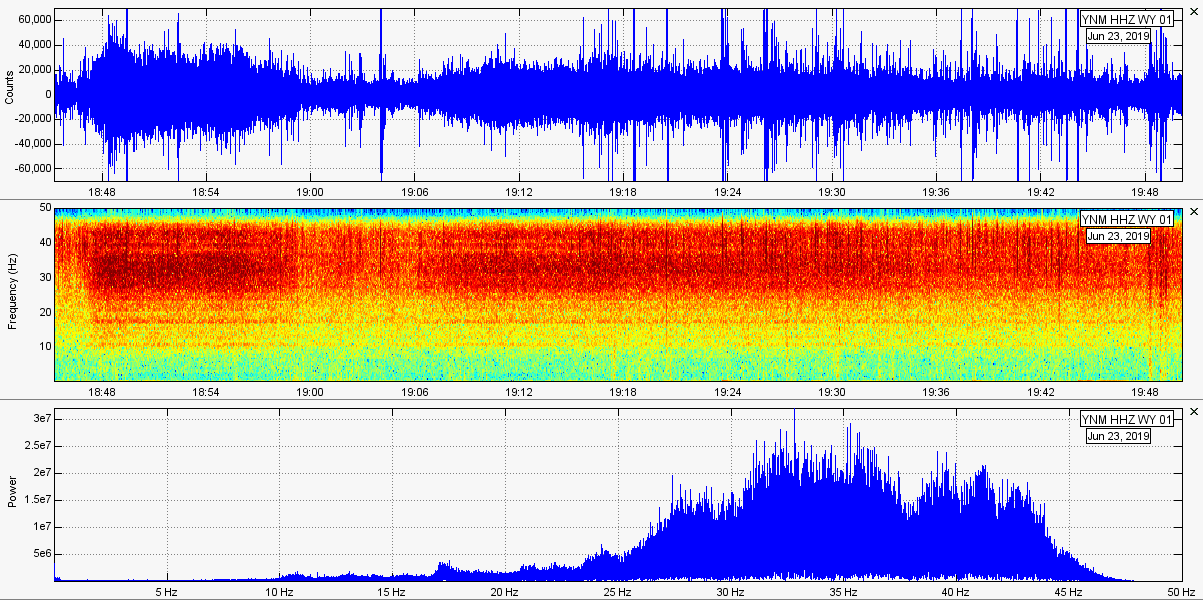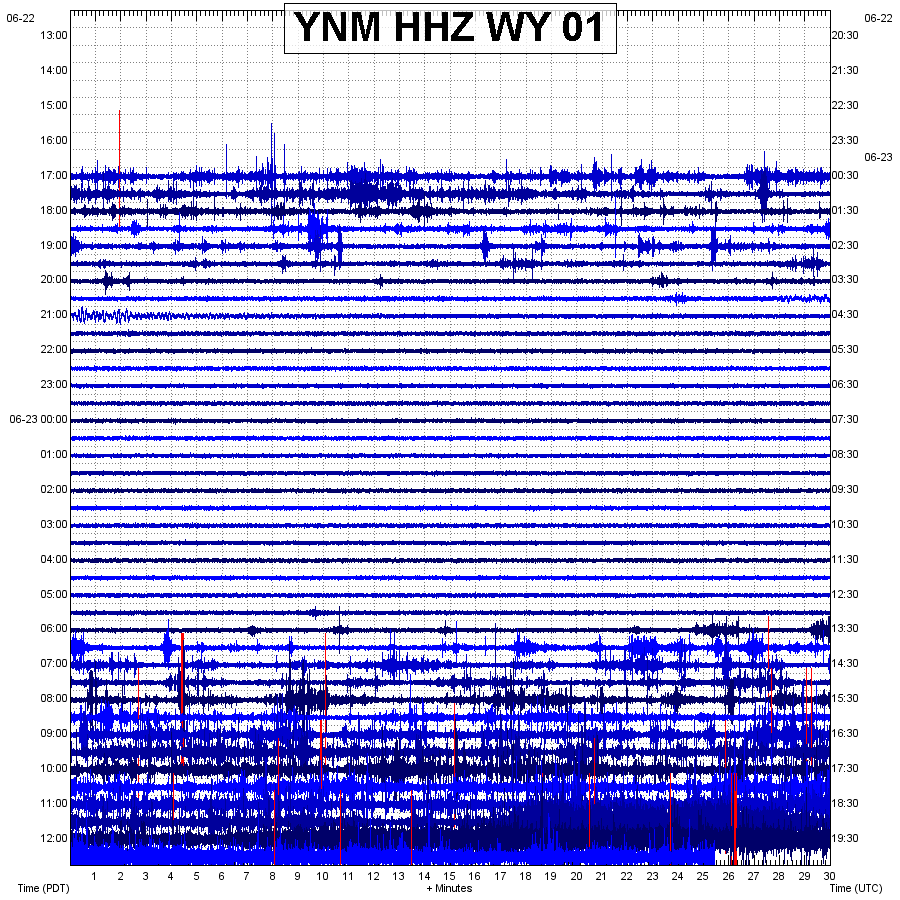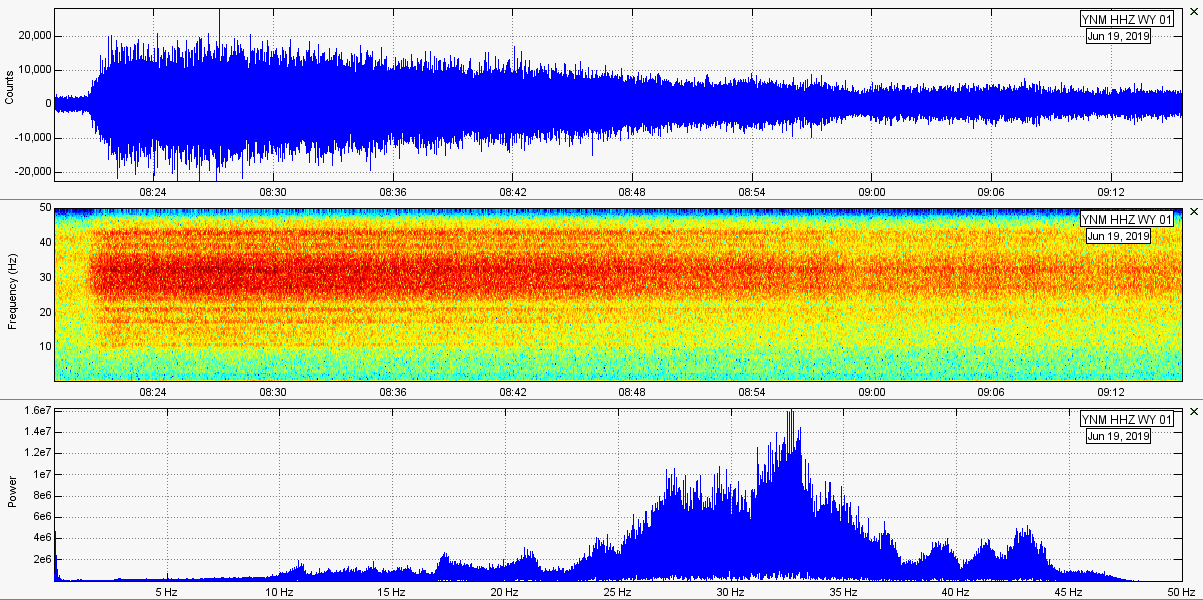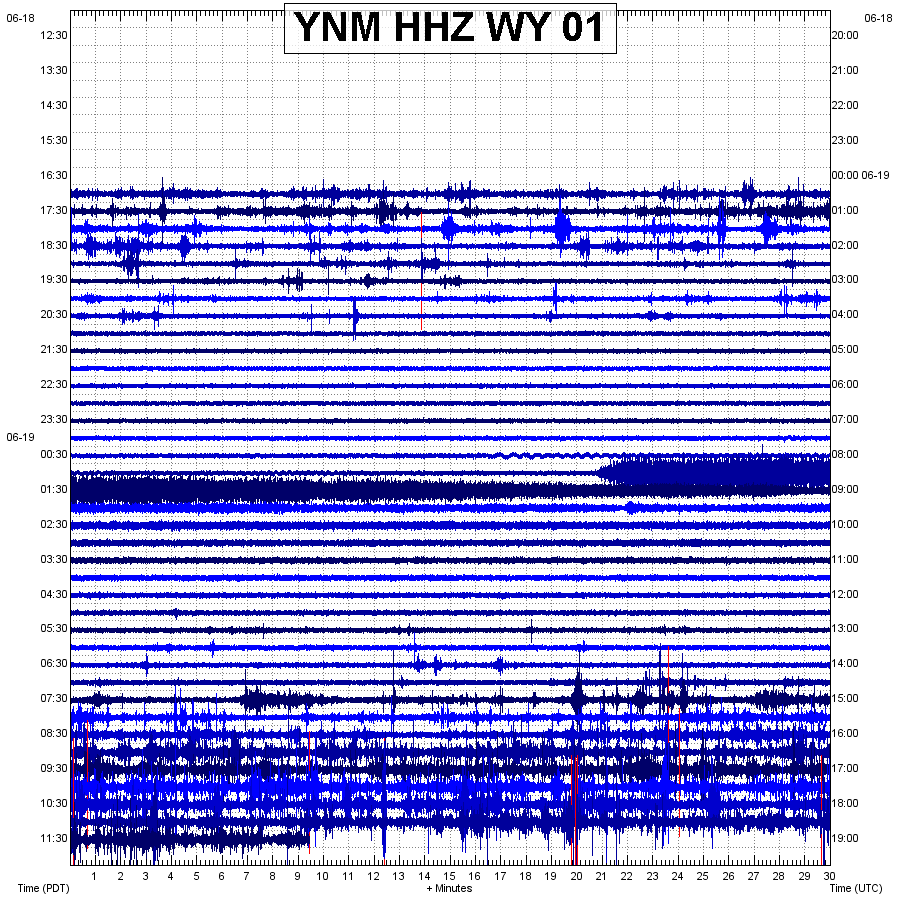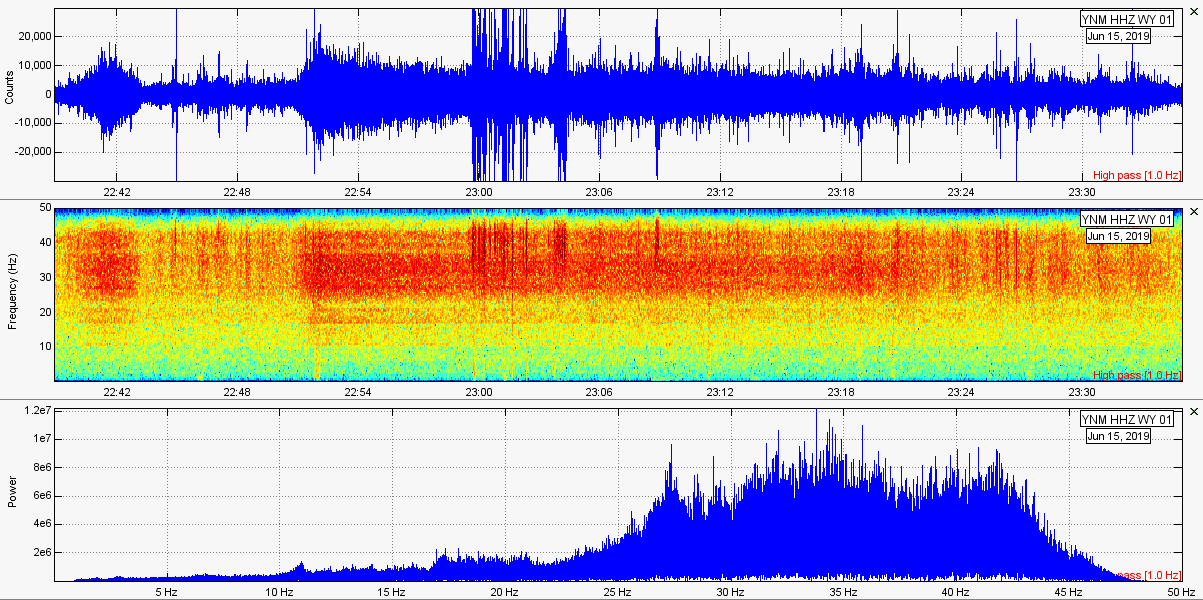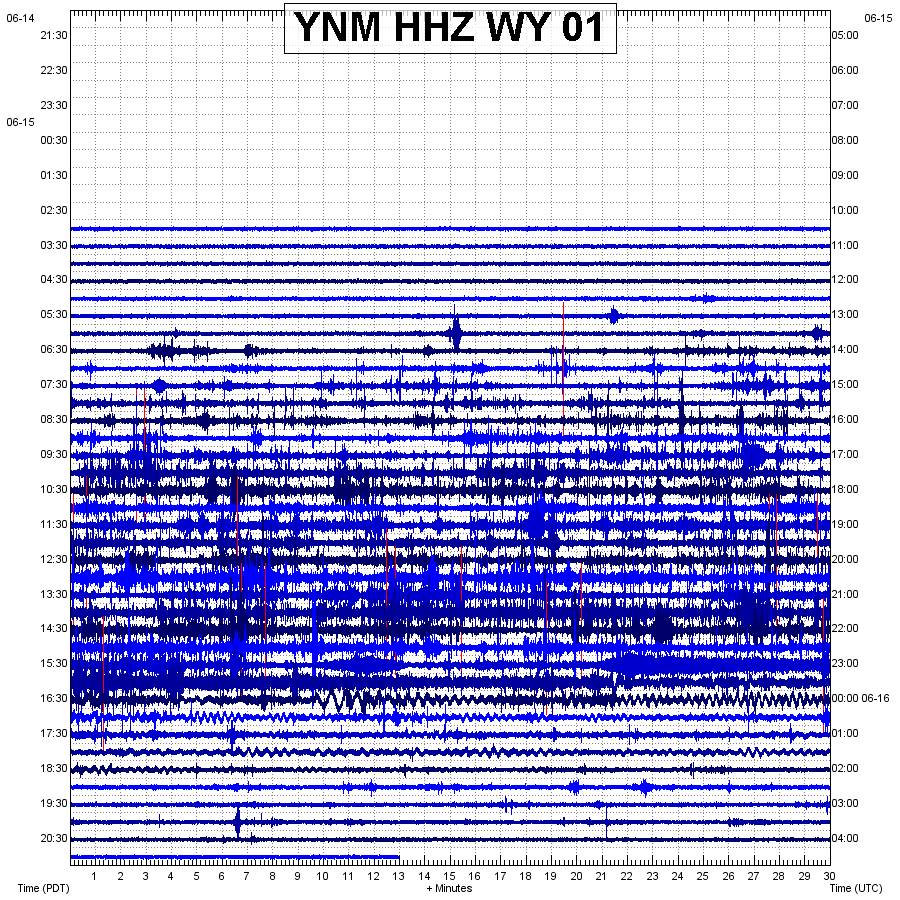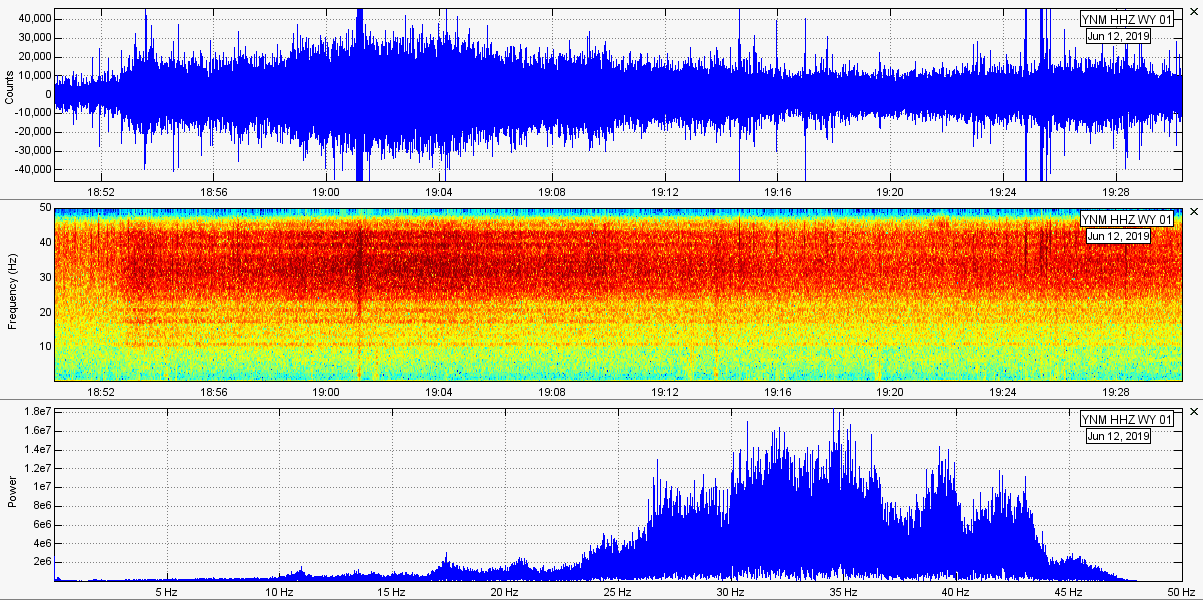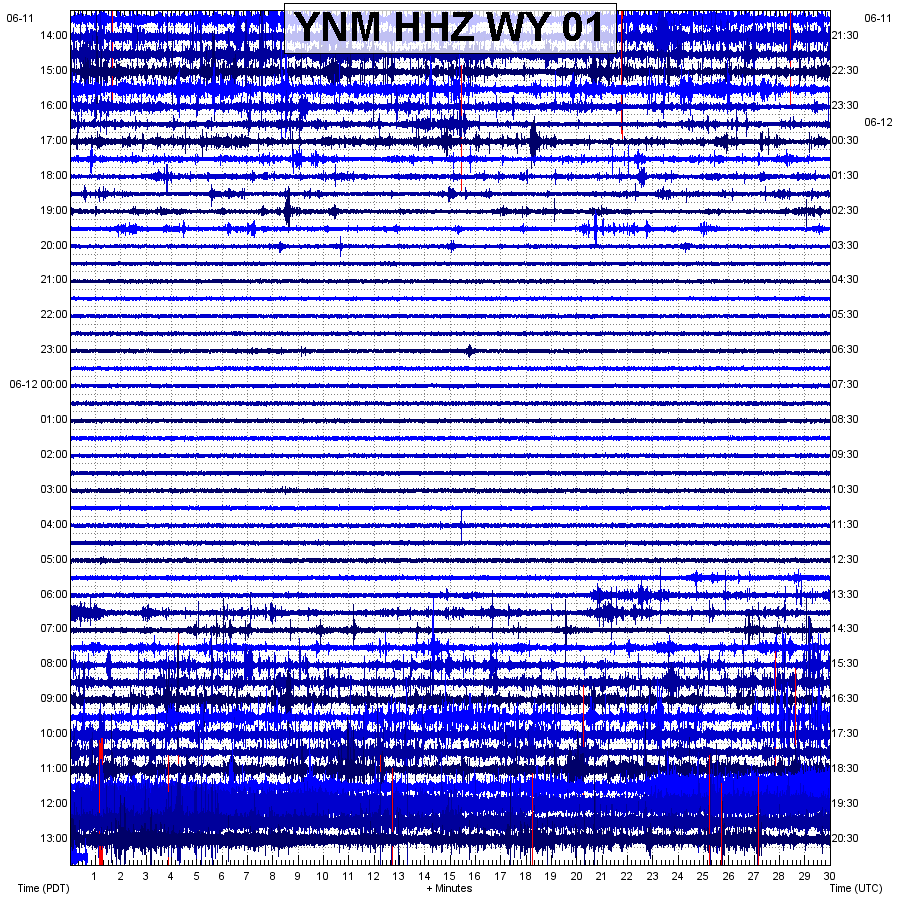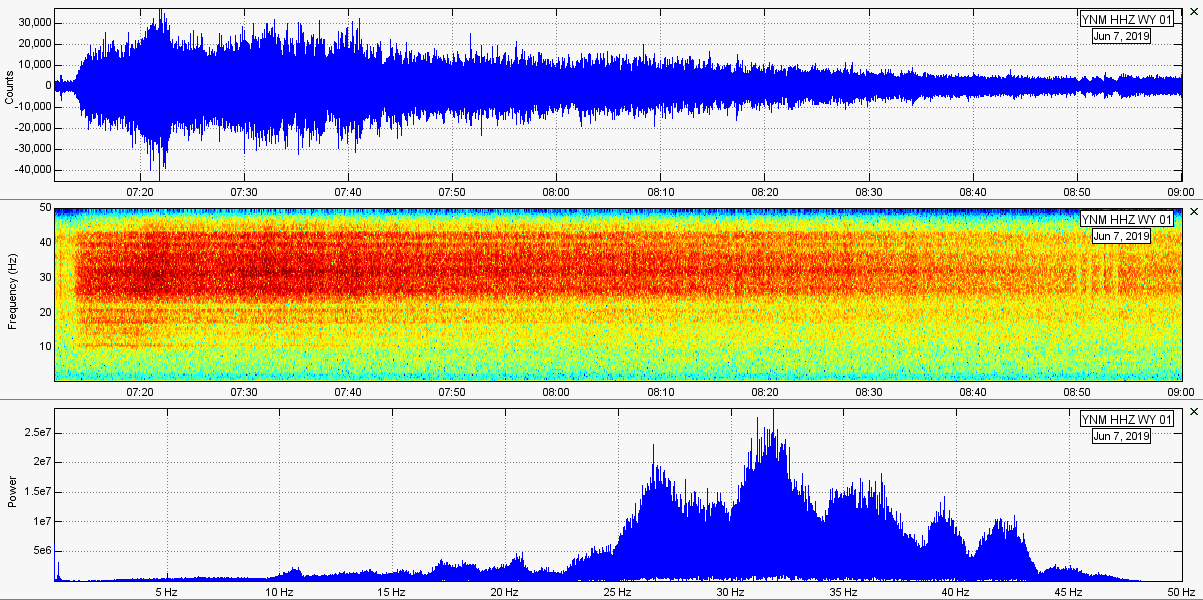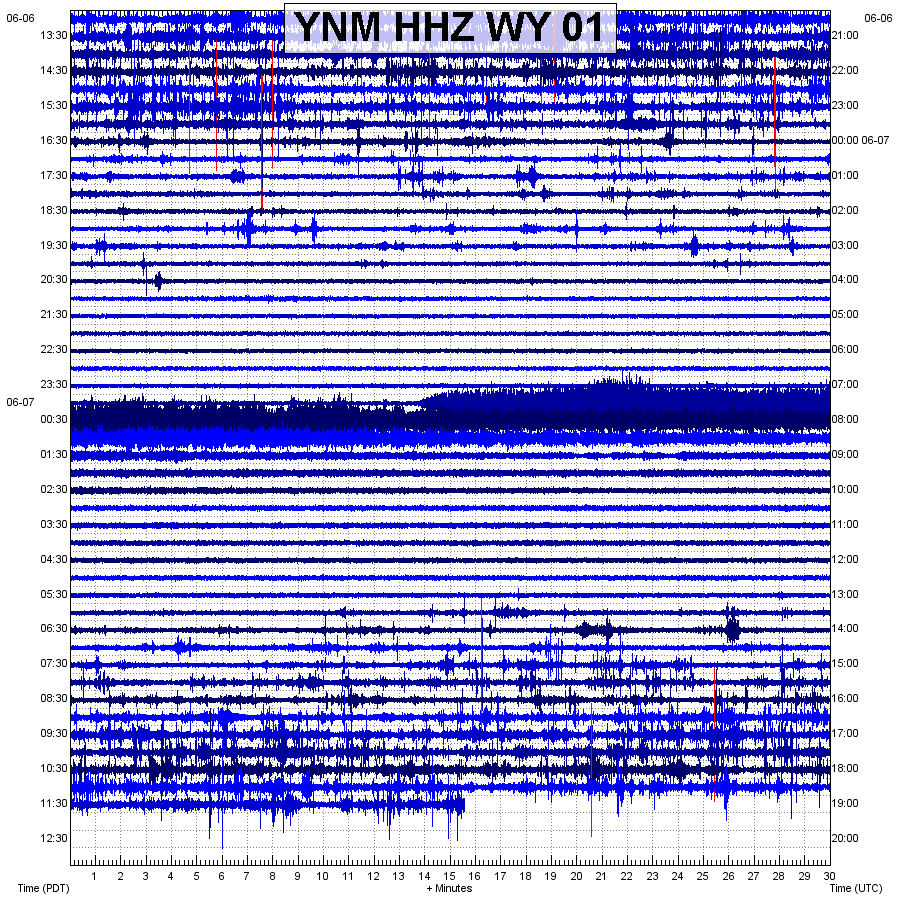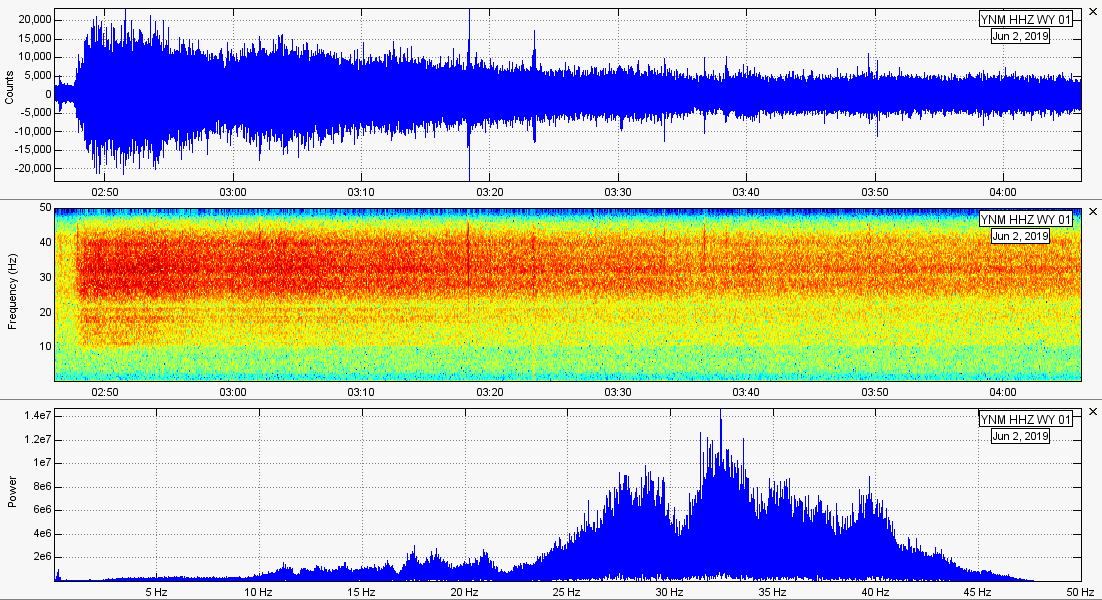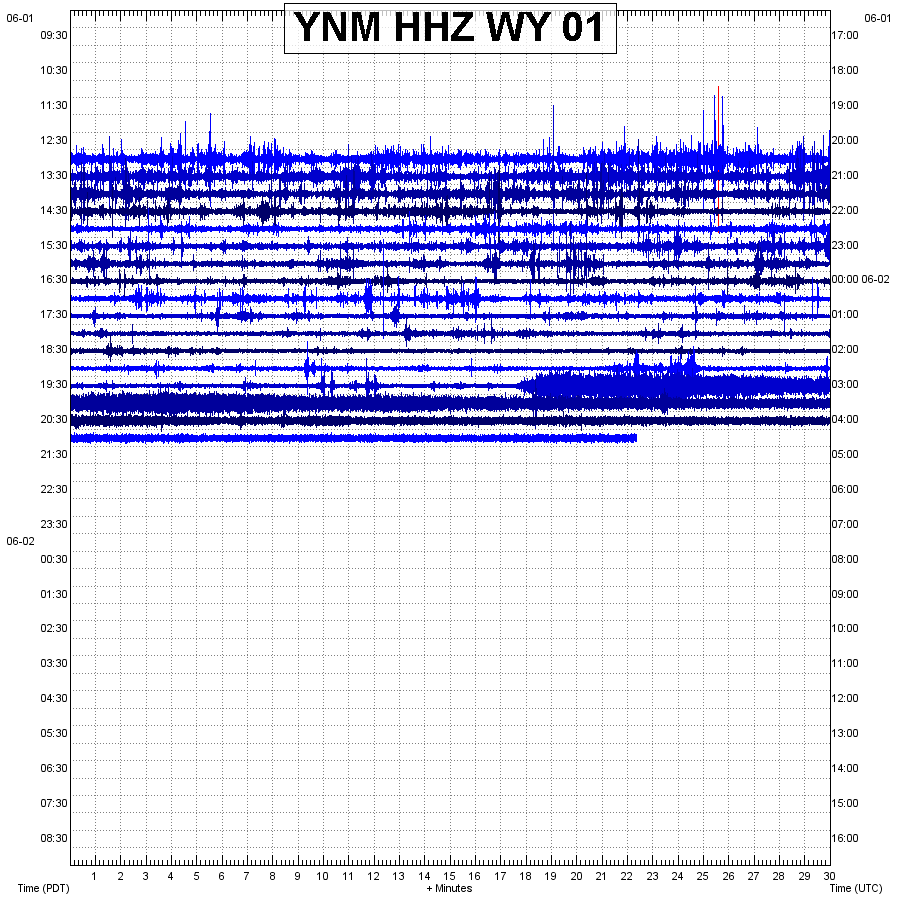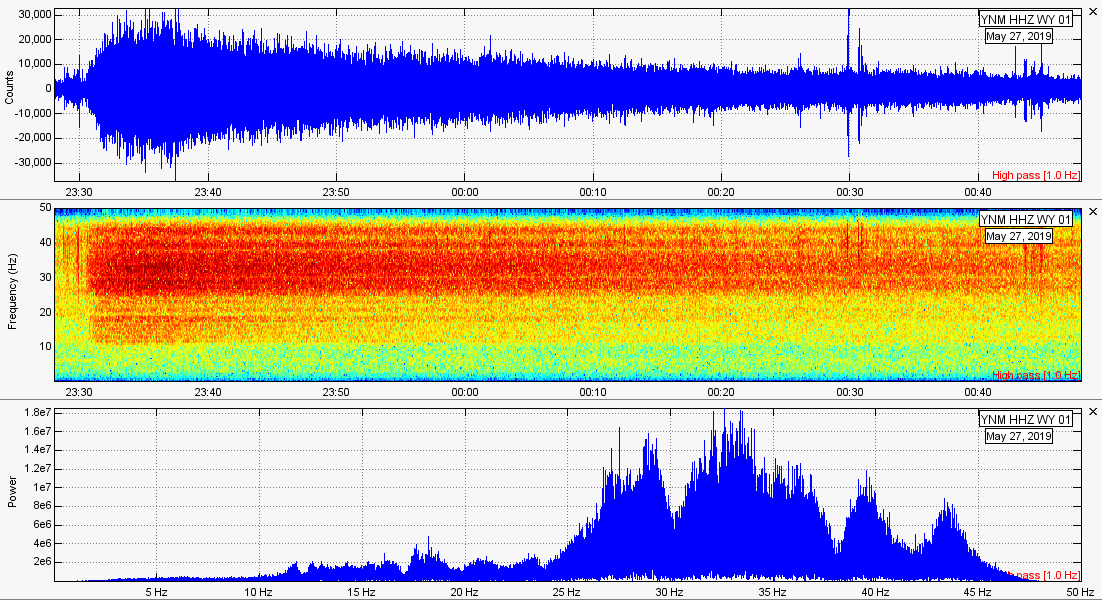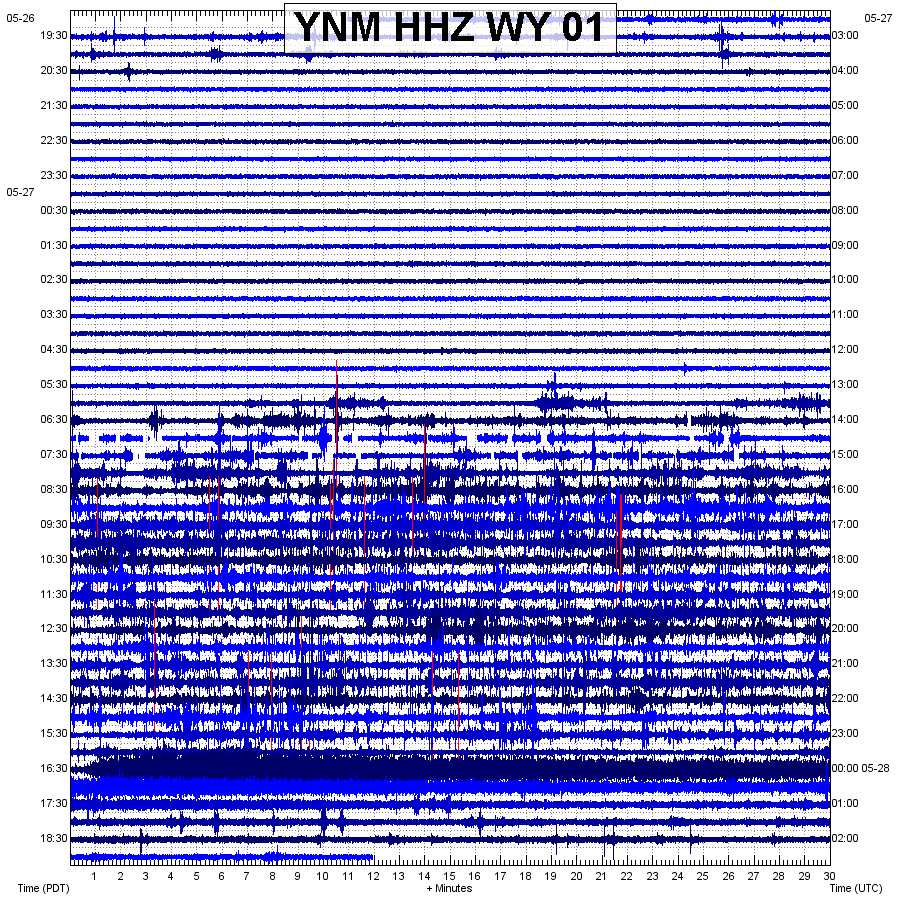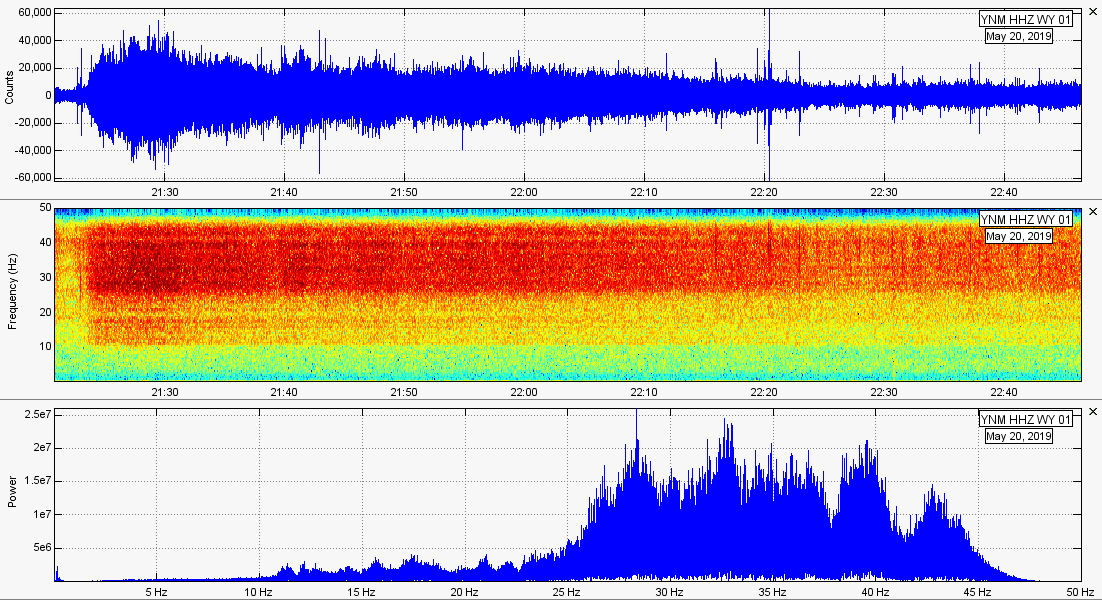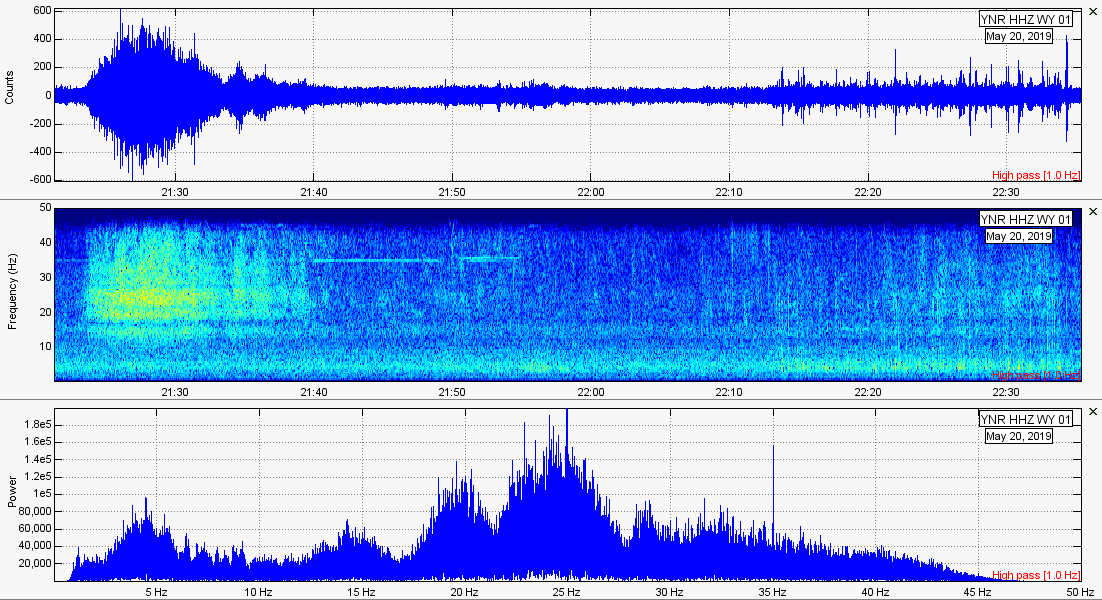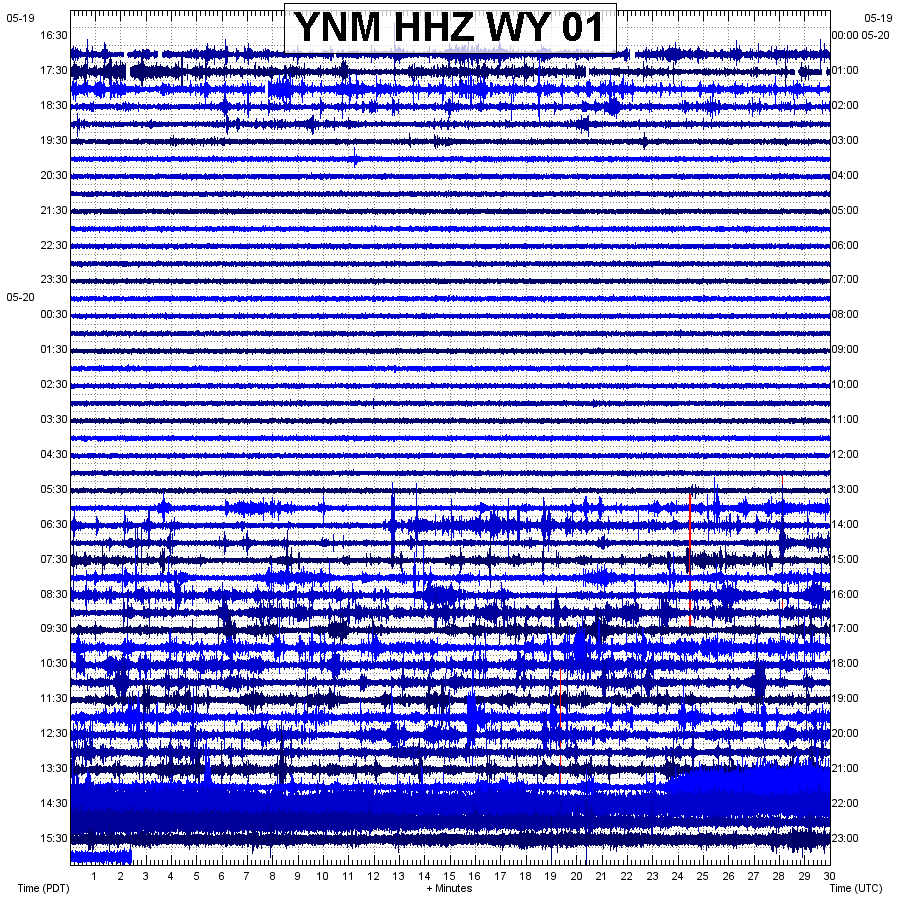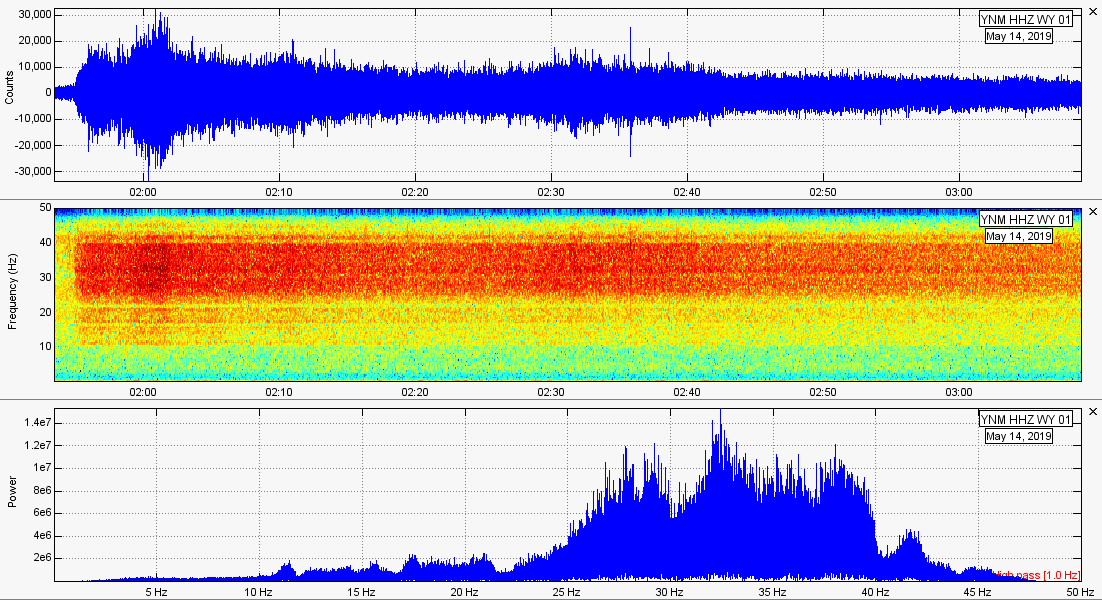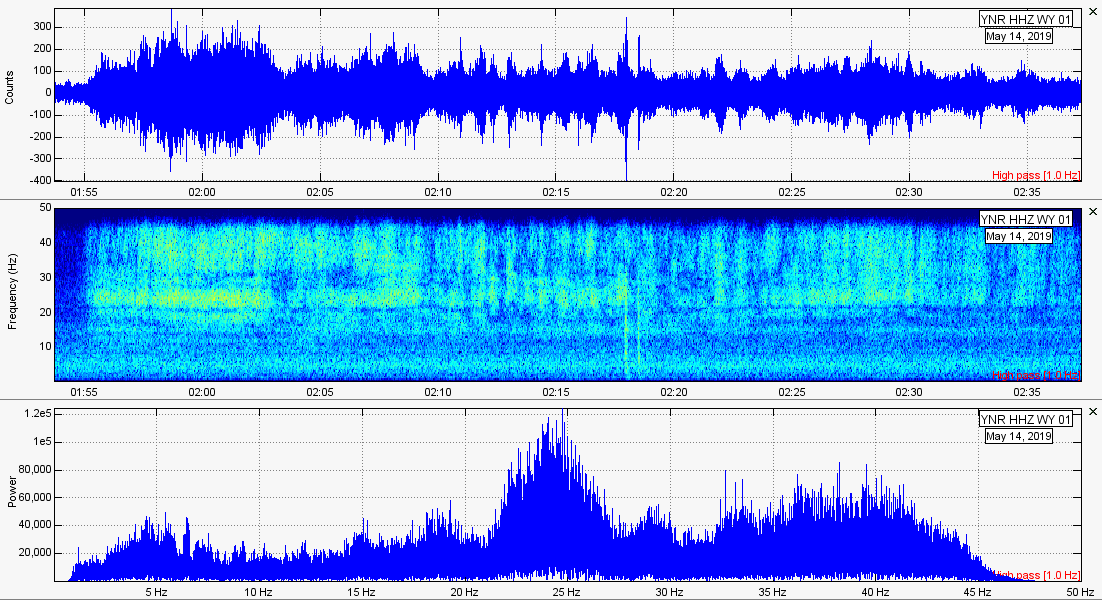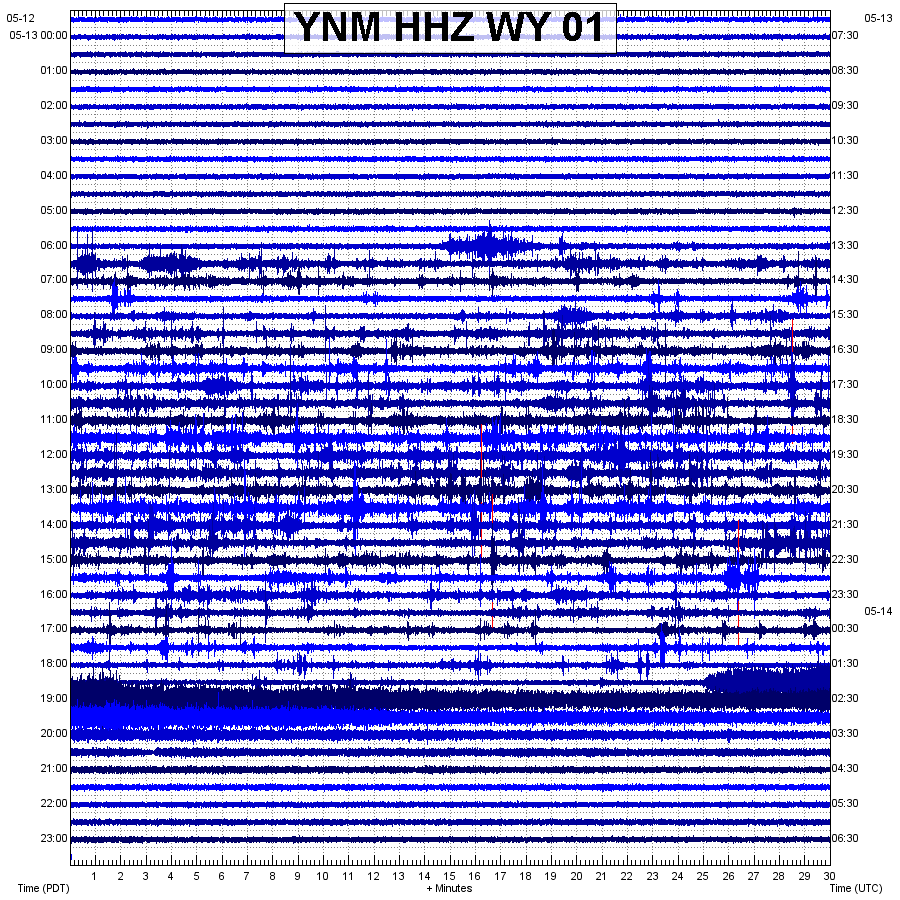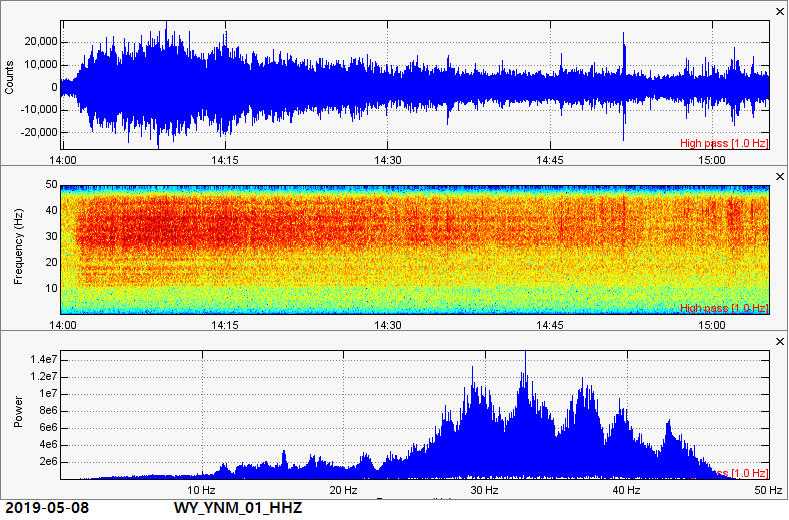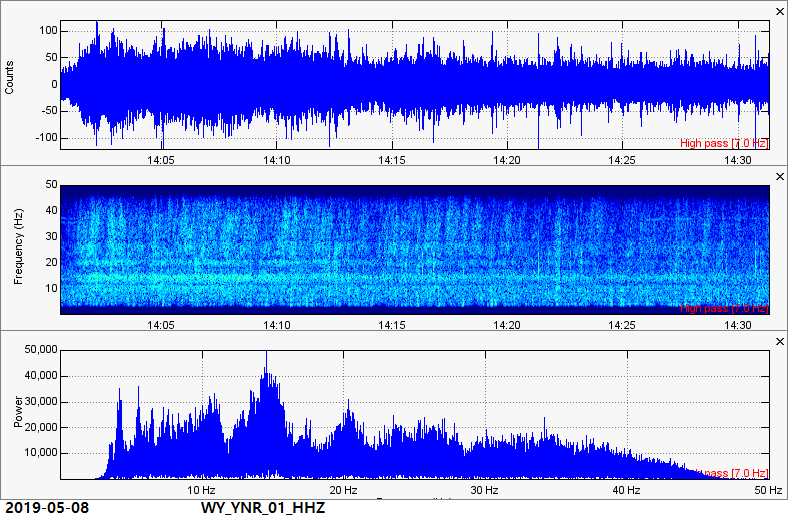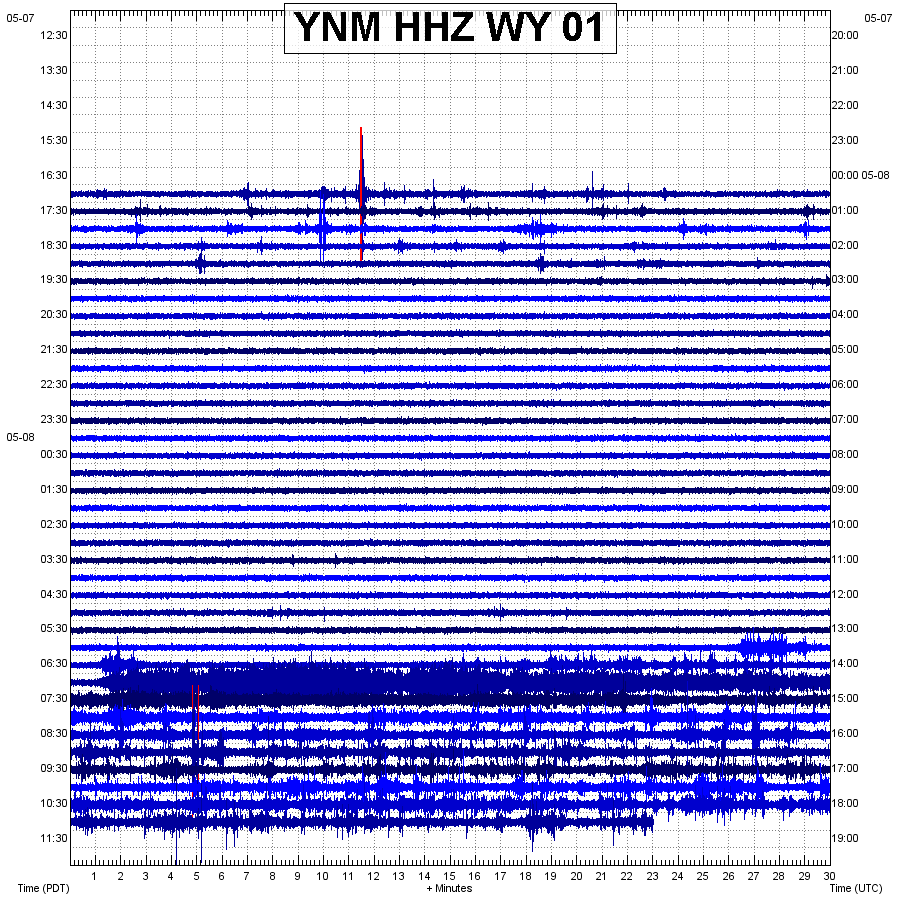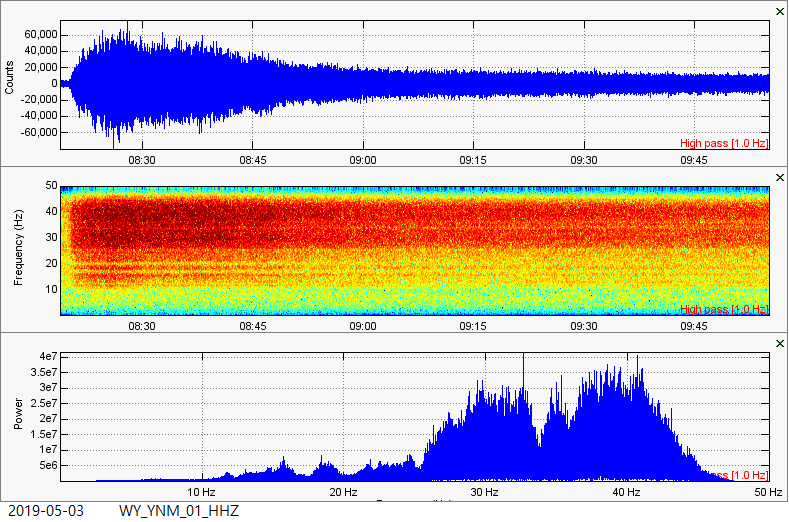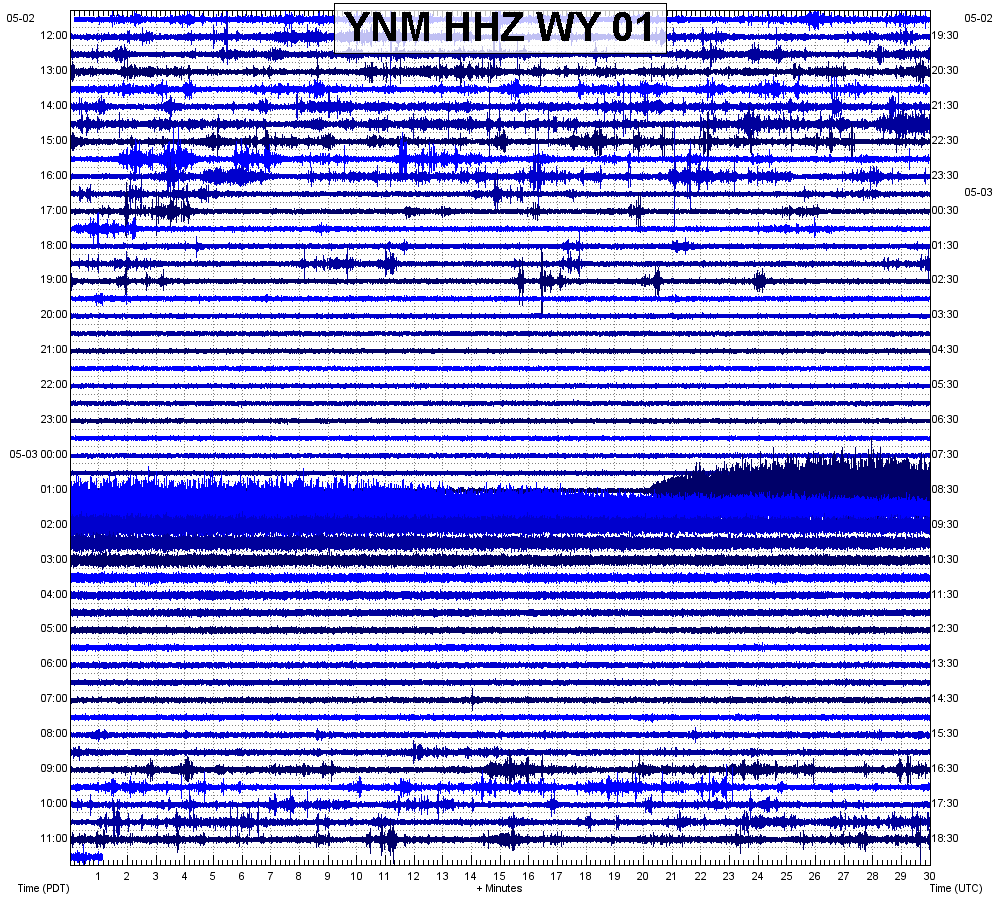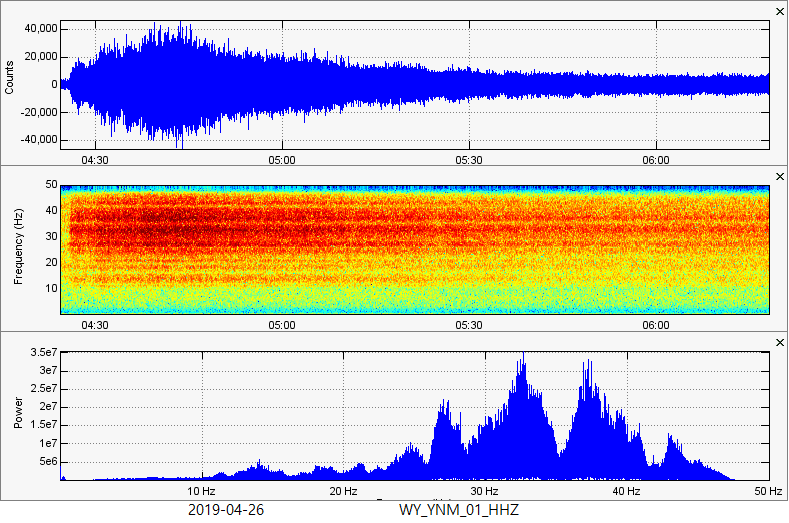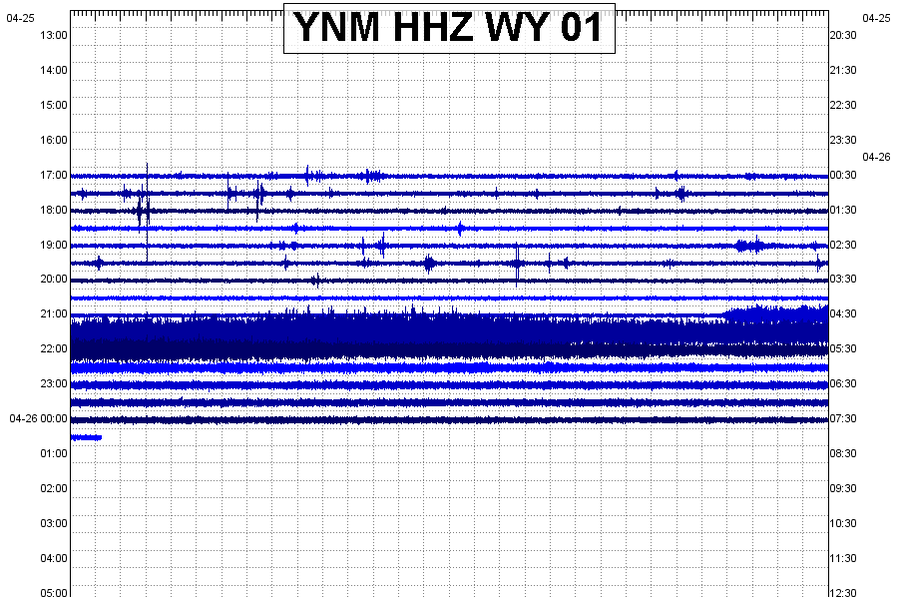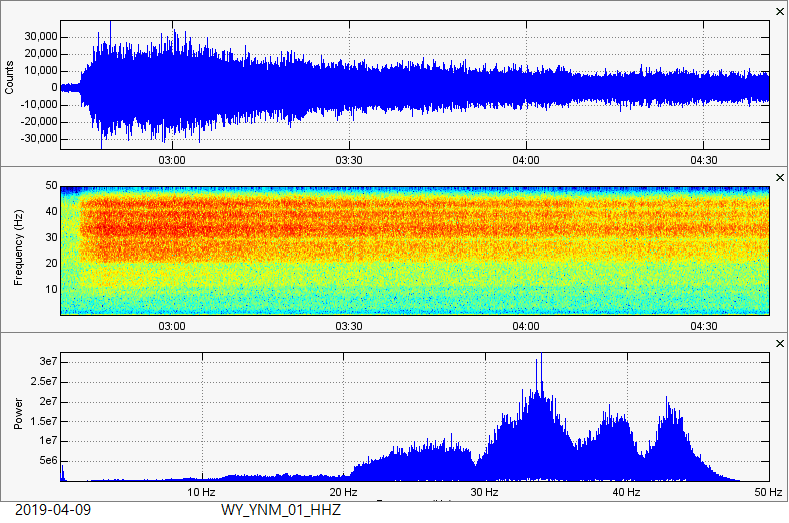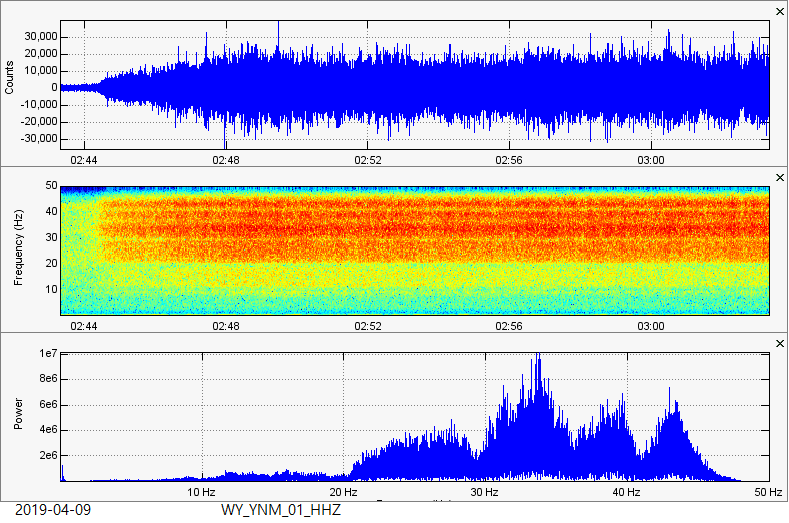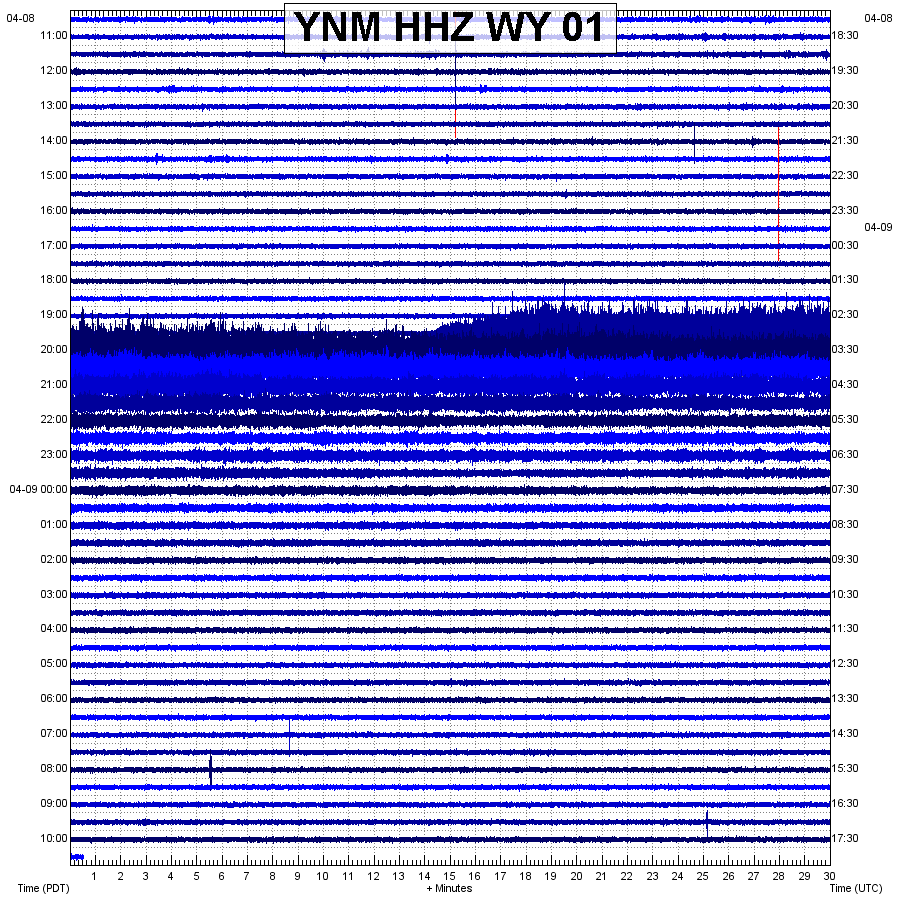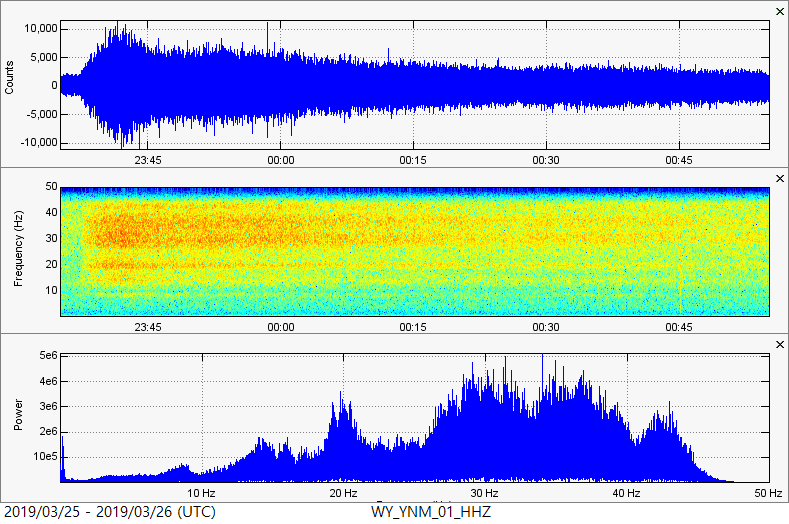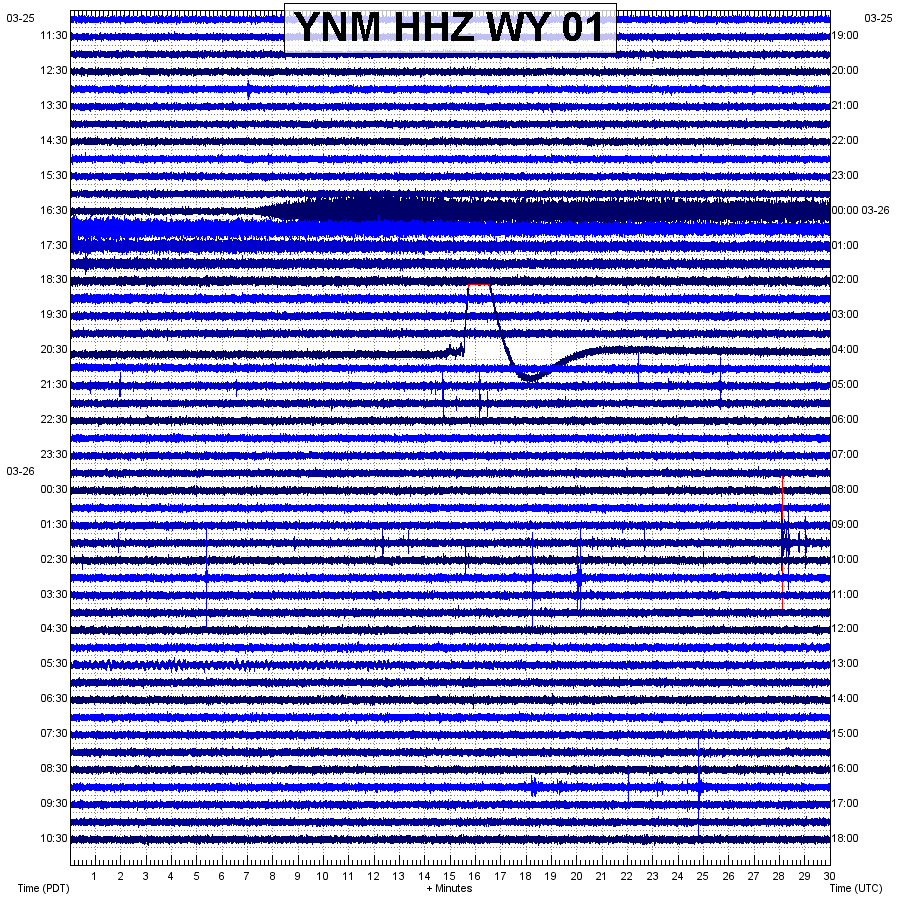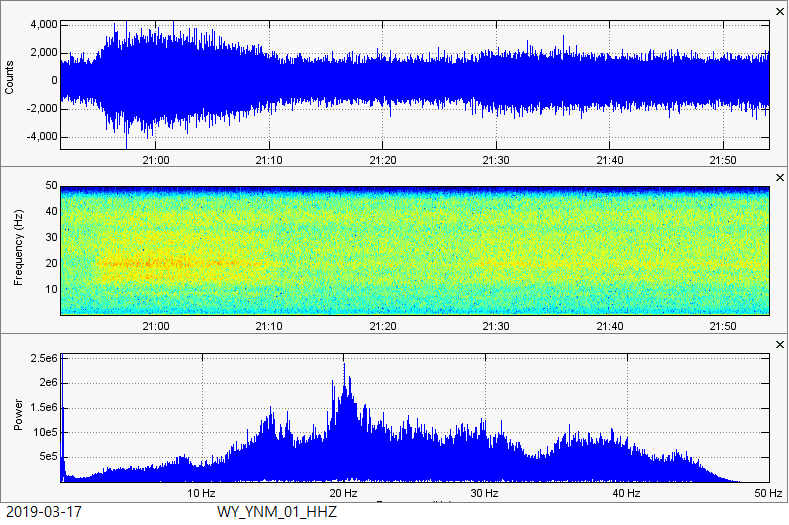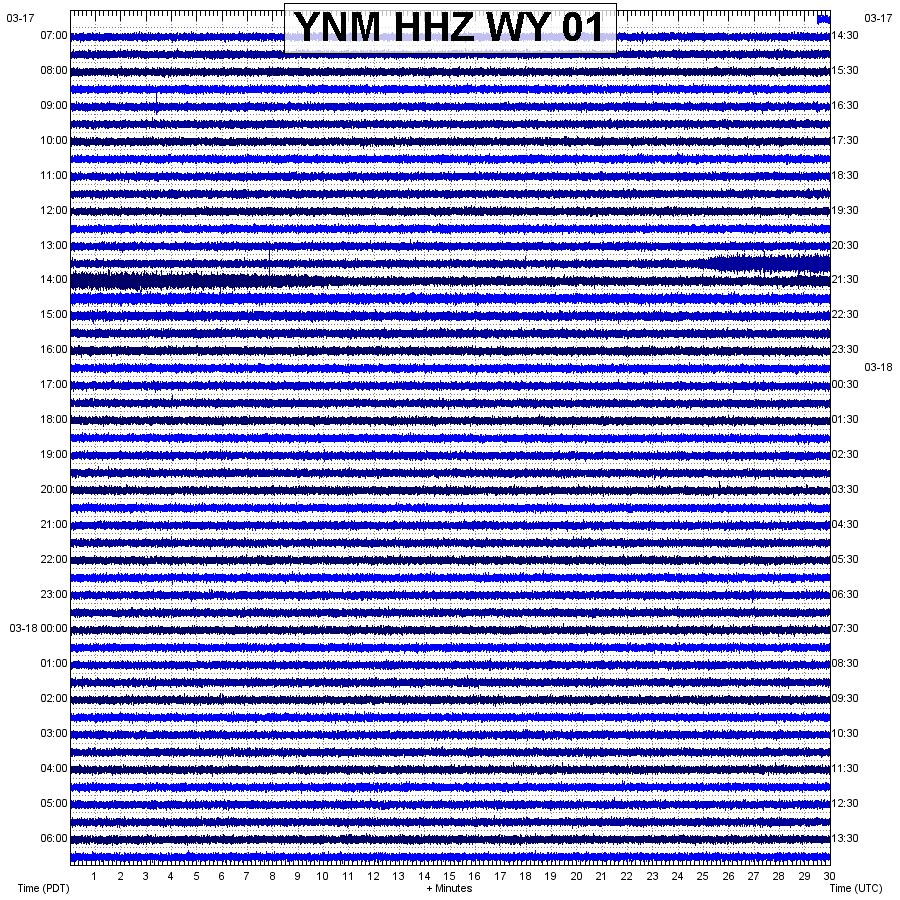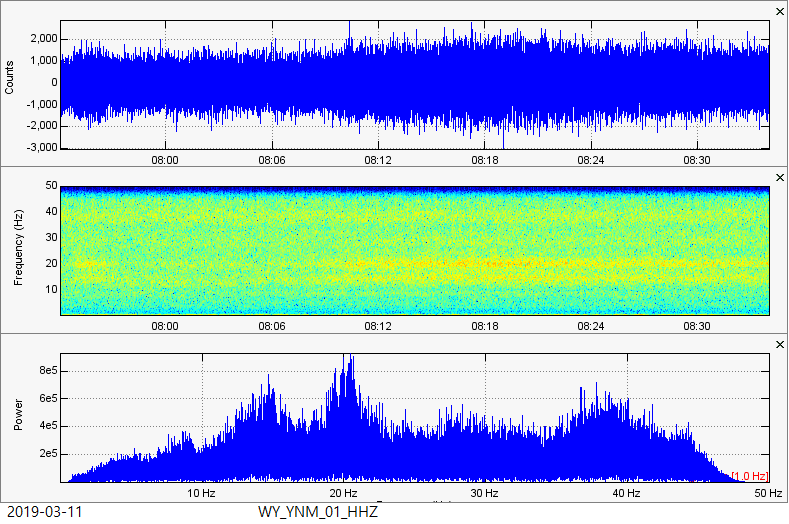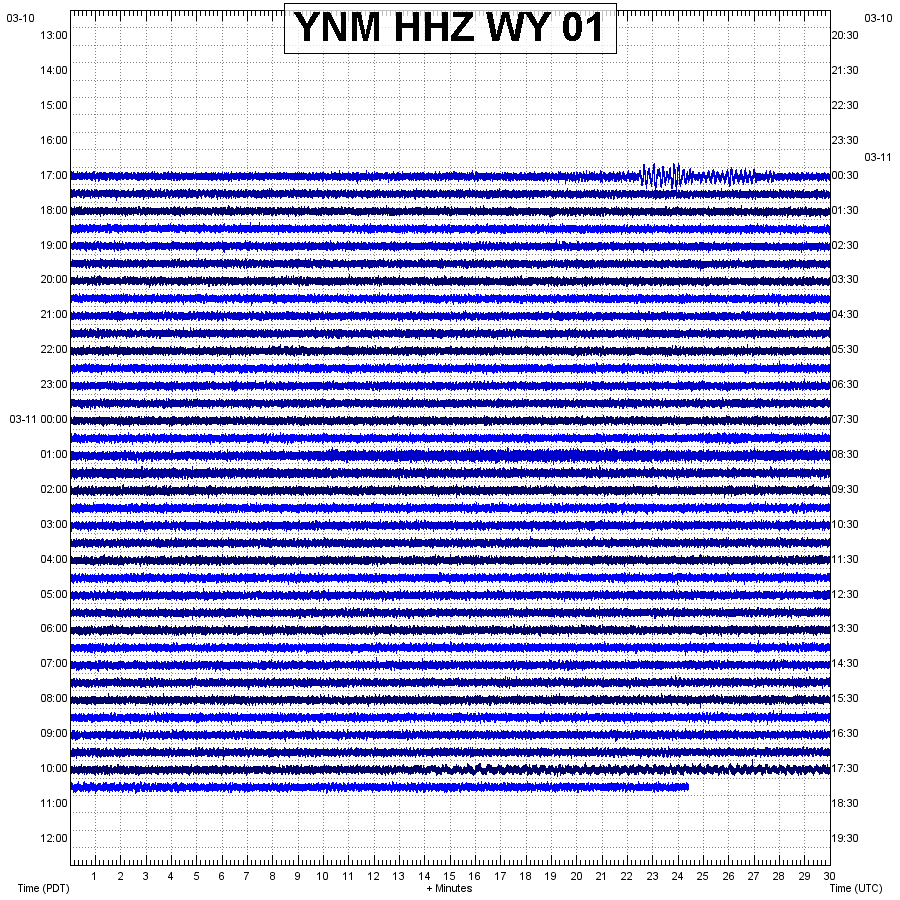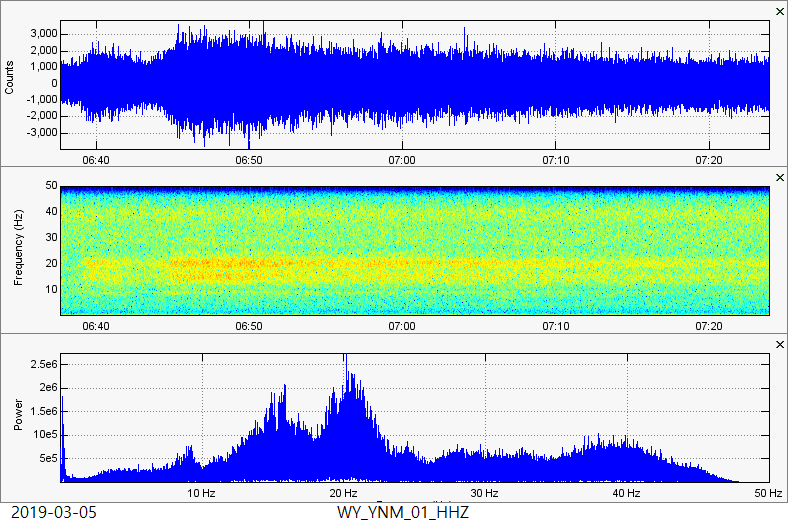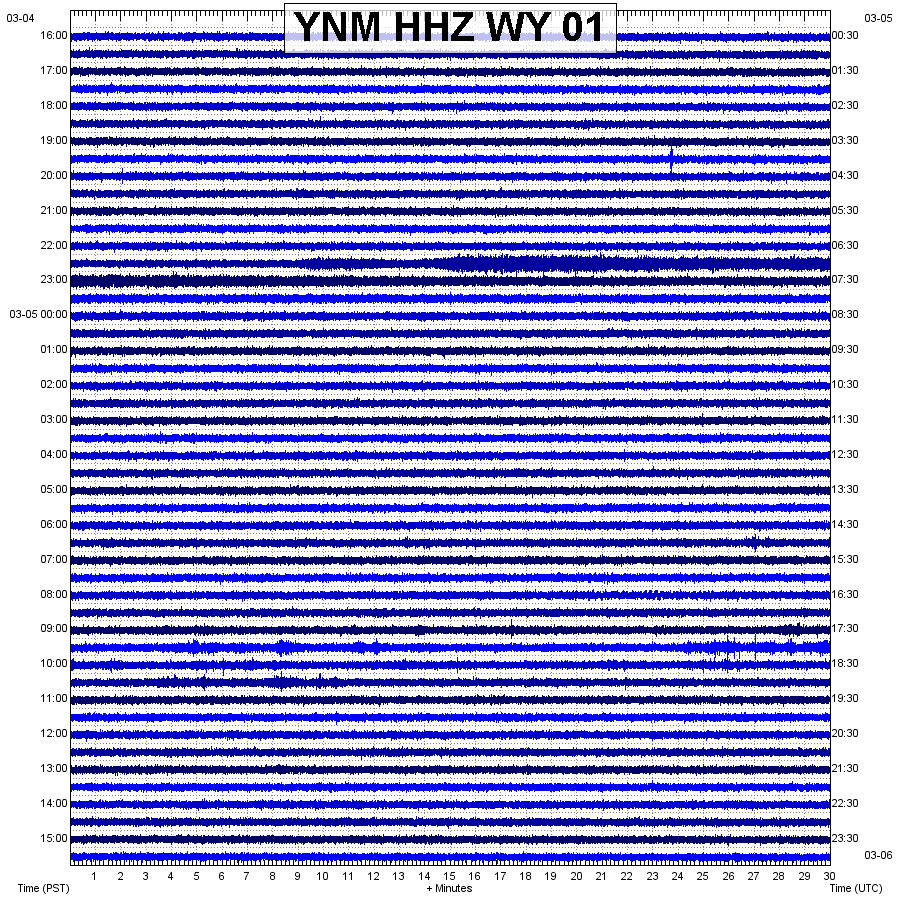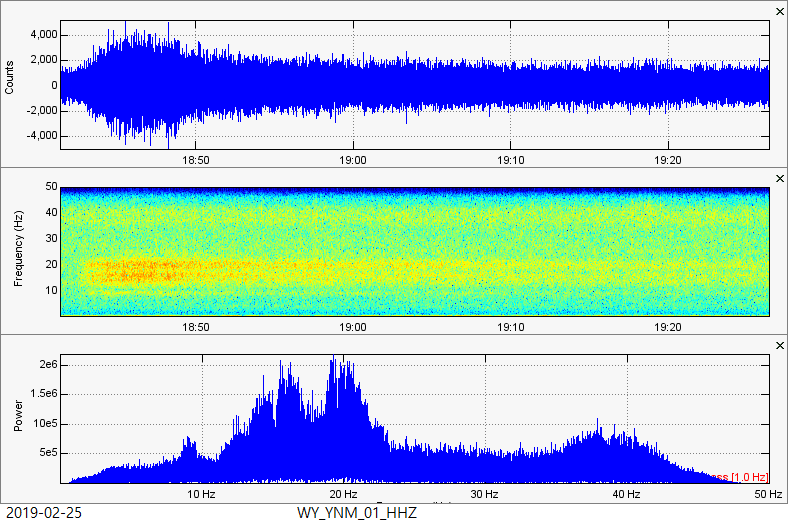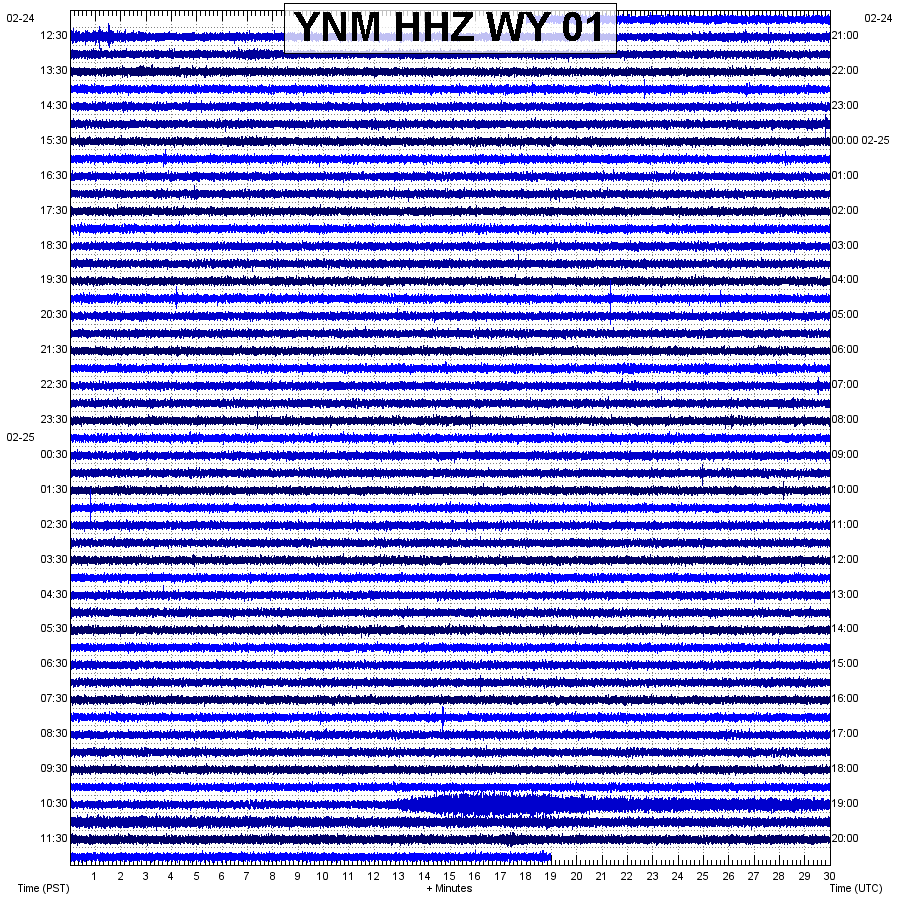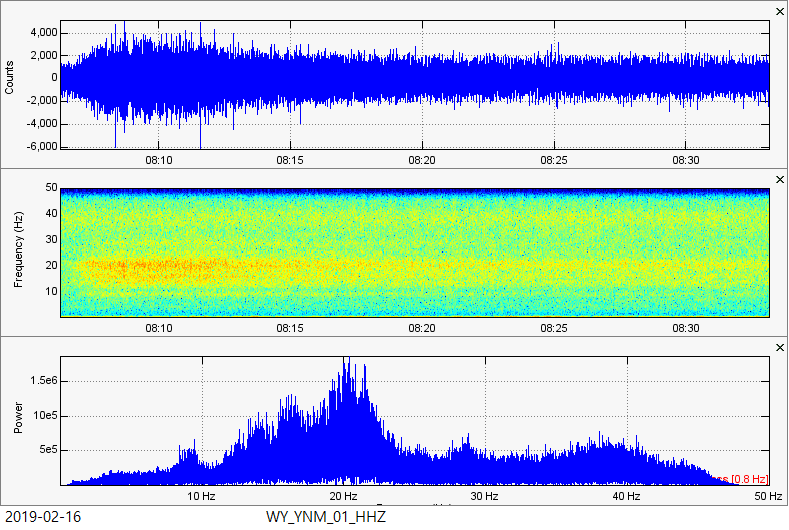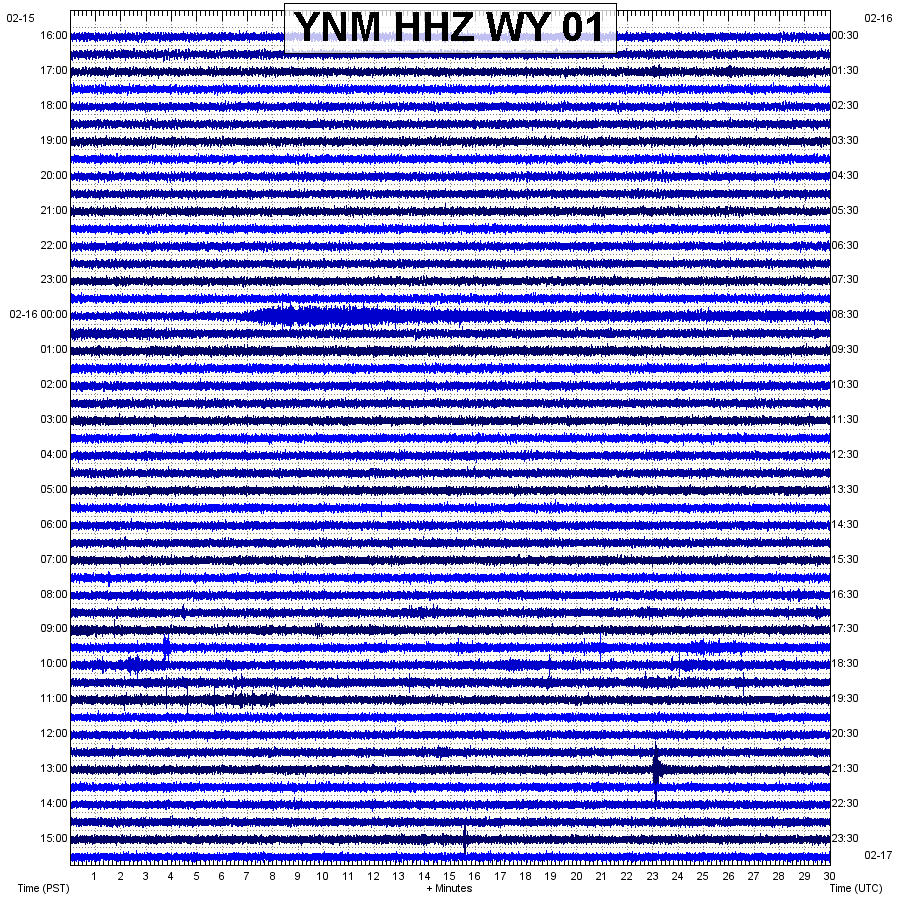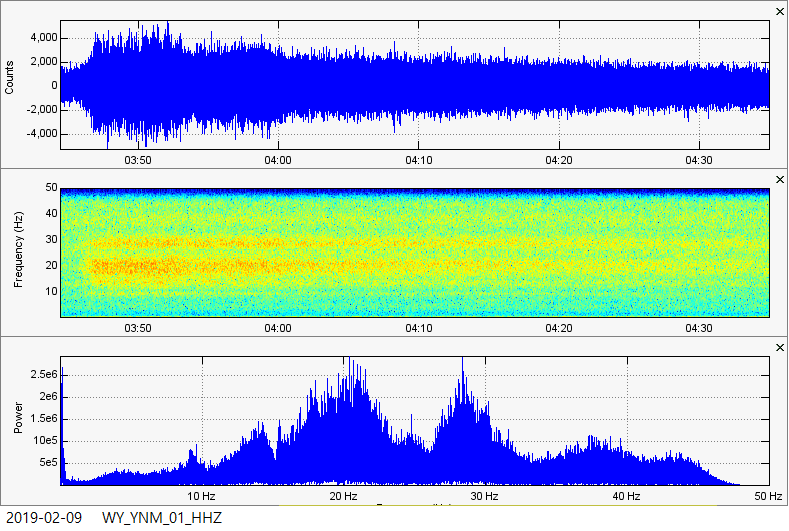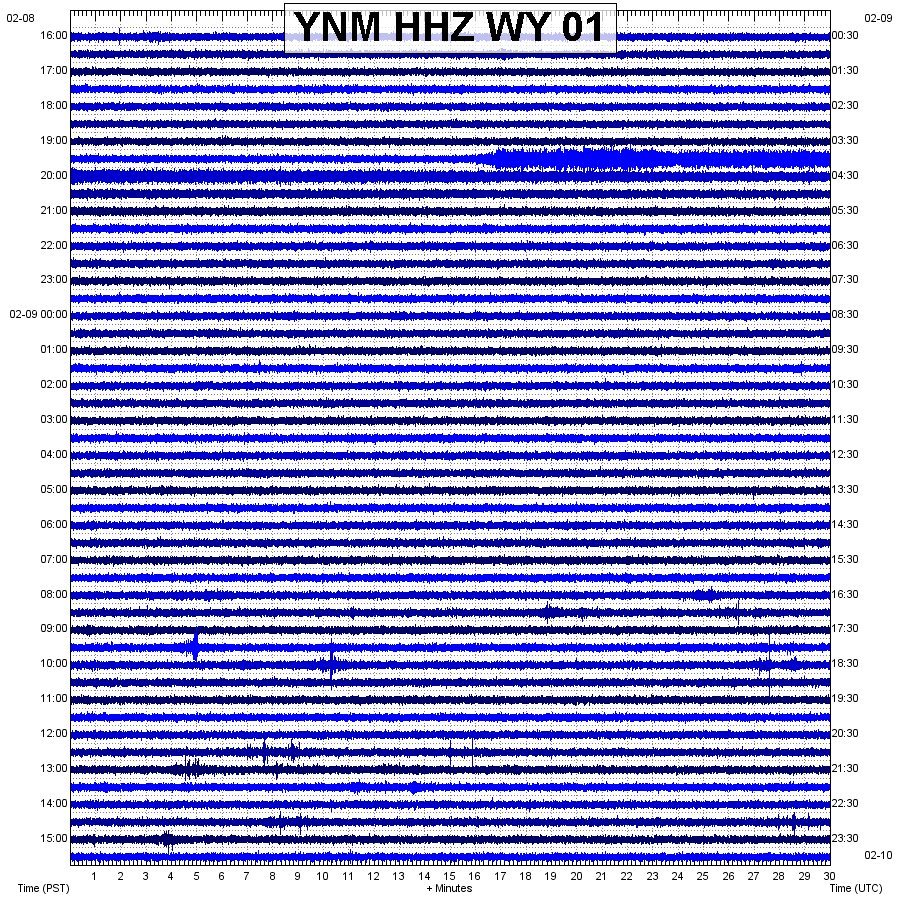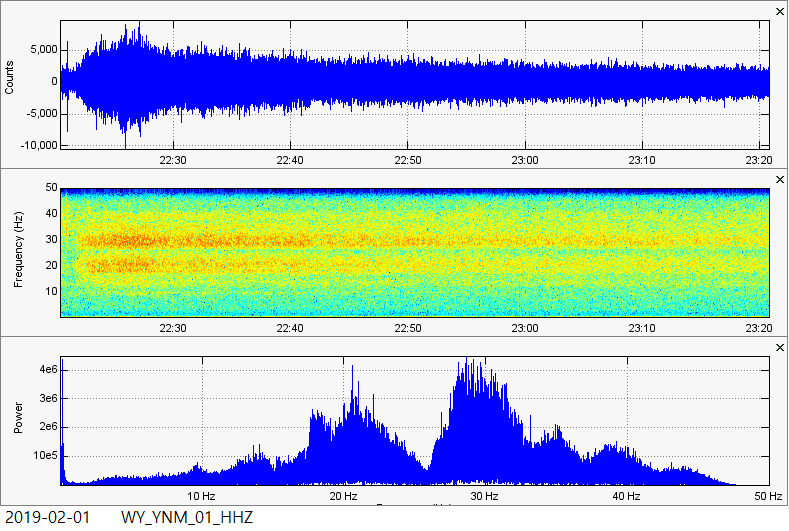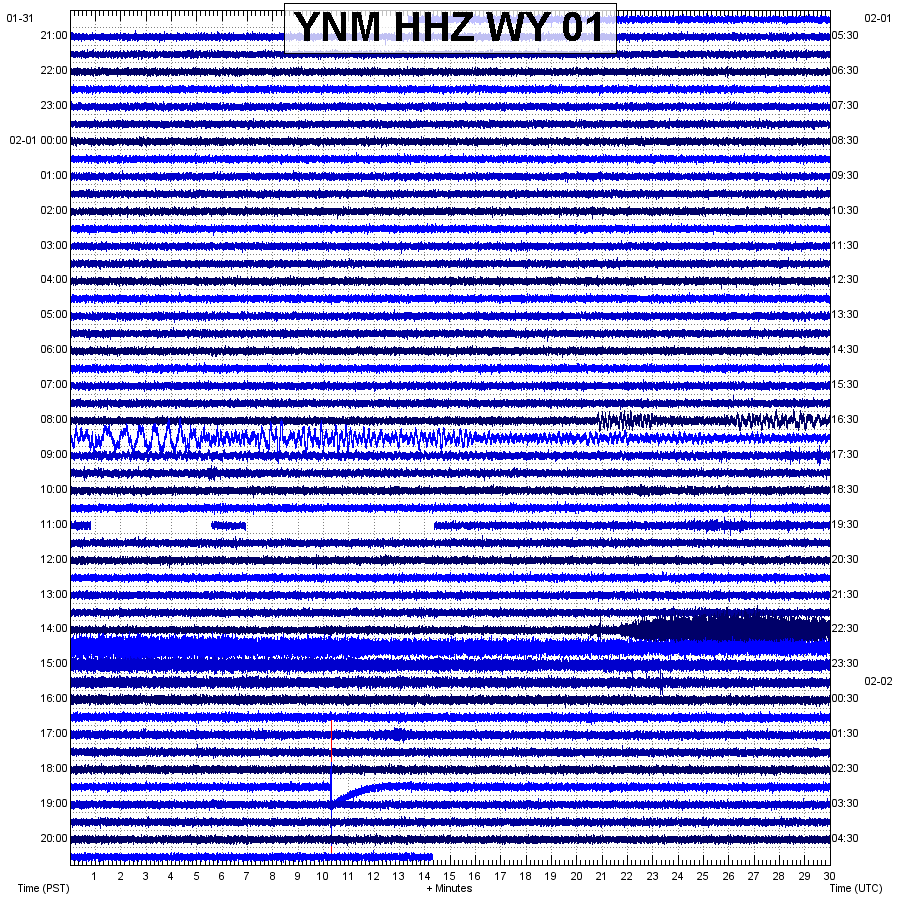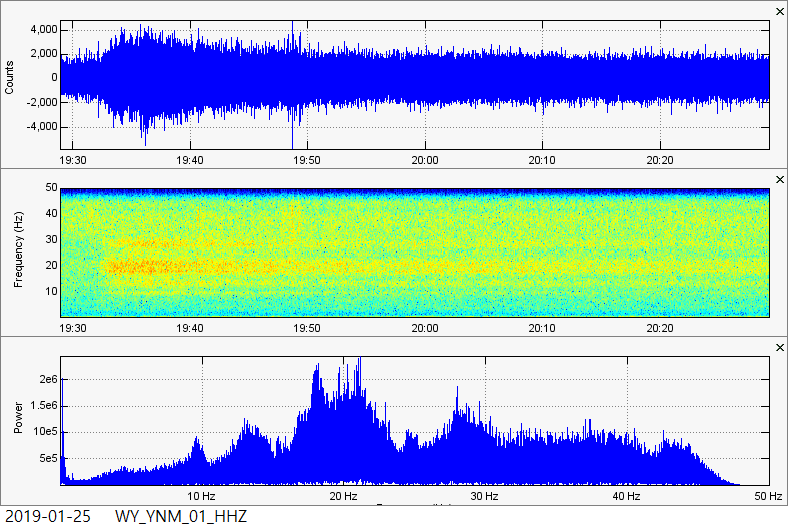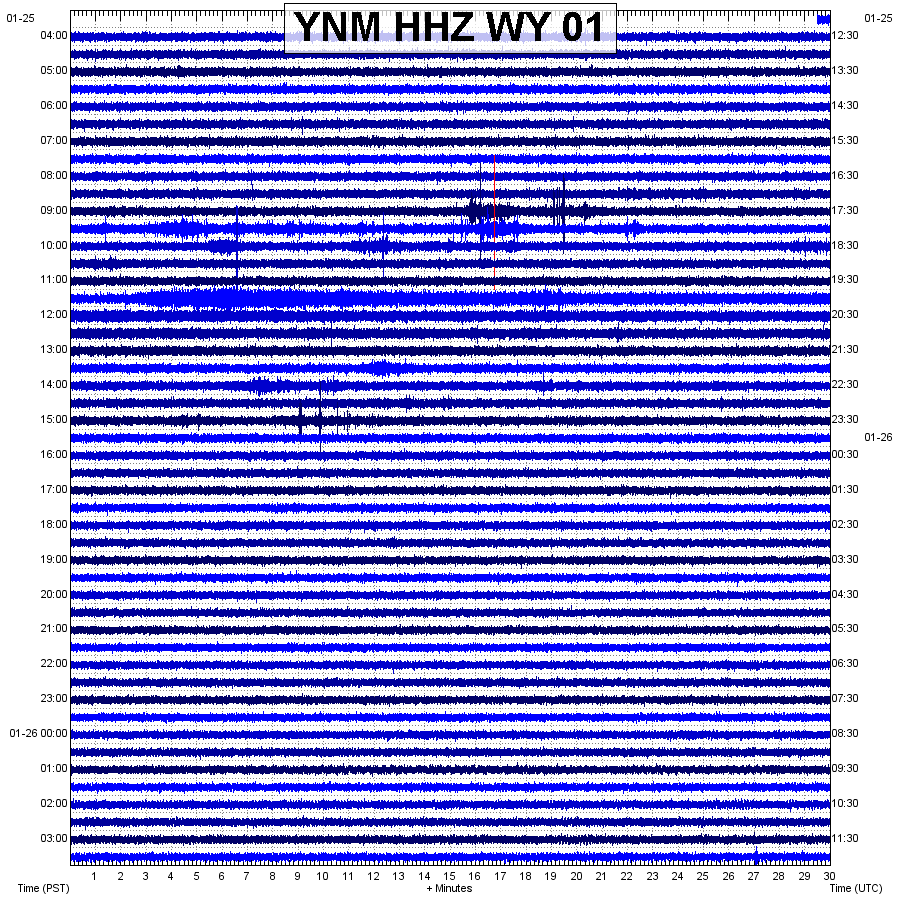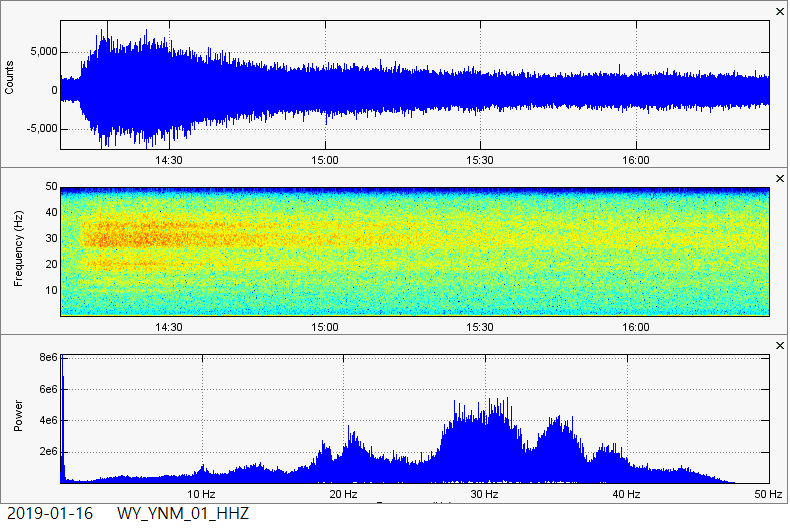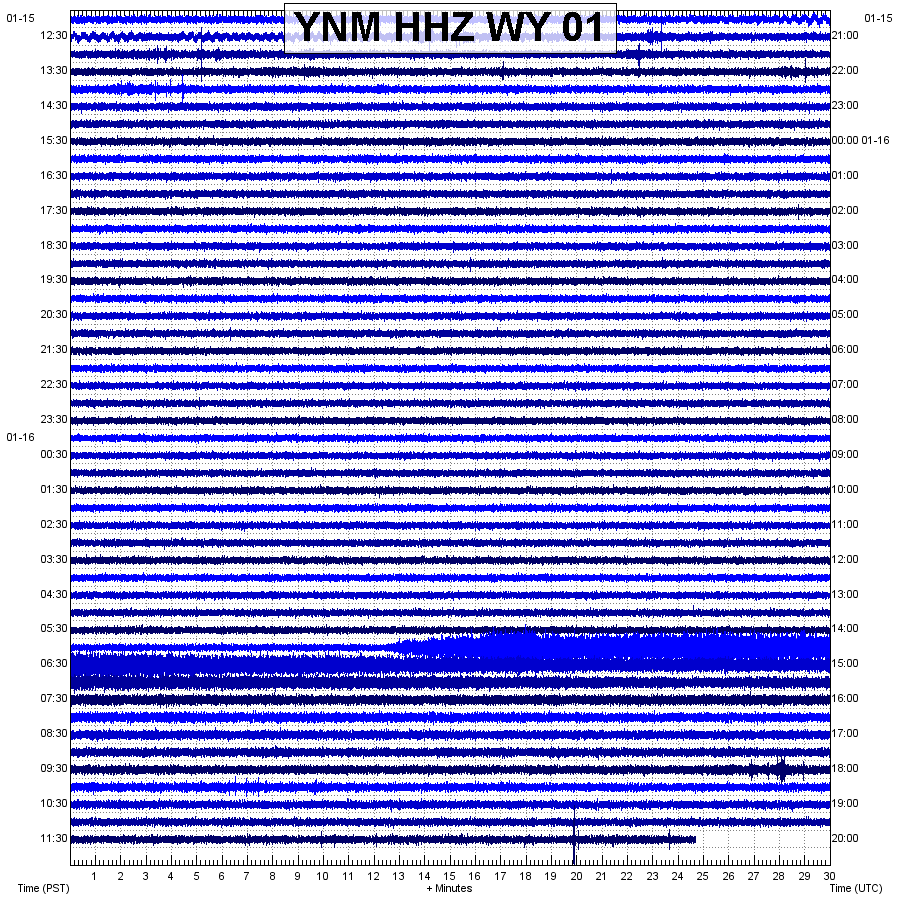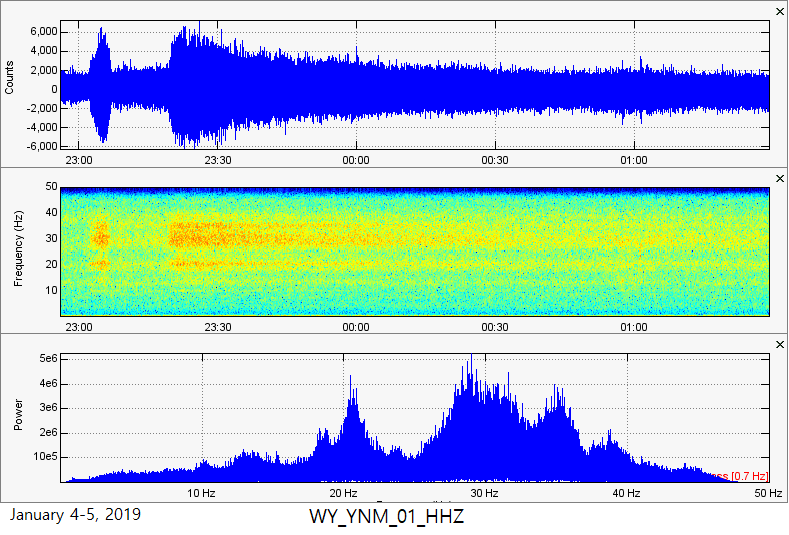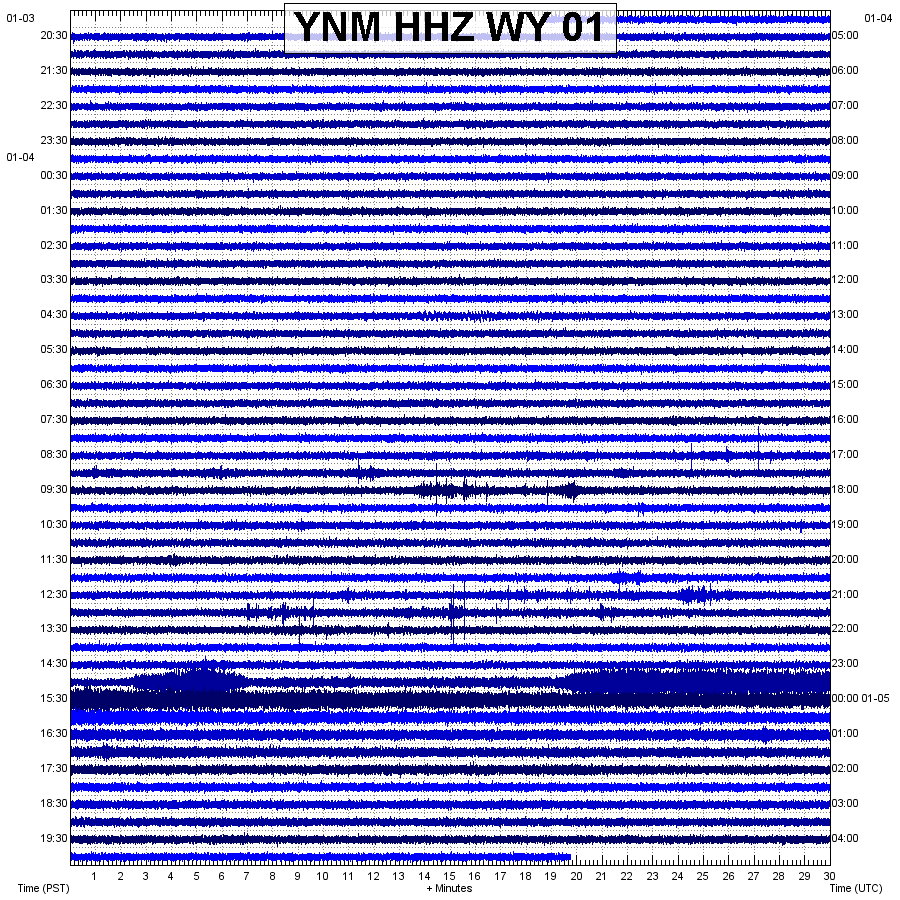2019
Steamboat Geyser is one of the world's largest hydrothermal geysers. Currently, Steamboat Geyser is the largest active geyser on the entire planet. It produces some of the largest, tallest, and longest hydrothermal eruptions known to man. It resides in the Norris Geyser Basin at the infamous super-volcano: Yellowstone National Park and Caldera. This page will show the helicorders, along with the seismogram/spectrogram/spectra plots, of every Steamboat hydrothermal eruption of the year 2019. It has been dormant for some time but miraculously sprang to life in March of 2018. The record used to be 29 eruptions in one year, which occurred in 1964. Then, on December 8, 2018, Steamboat Geyser officially beat the all-time record with 32 eruptions for 2018. Then, on August 27, 2019, Steamboat Geyser blew that record out of the water. 2019 now holds the highest count of eruptions within 1 year with a grand total of 48 eruptions for 2019. Don't forget to stay up to date with the official 2020 Steamboat page here on my website! I will try my best to update within a few hours of every Steamboat eruption.
Now I have talked about Steamboat Geyser many times on my YouTube channel and "Seismo-Blog". I have shown numerous amounts of data pertaining to these eruptions. The seismic traces you are about to see, using many different types of data sets, are the surface vibrations from these events. If you would like to see the reasons why, please click the button above. Therefore, since the seismic stations detect the surface vibrations, you can compare the amplitude count, the "count" on the left hand side of any seismogram plot, and understand which eruptions were larger, in terms of amplitude (strength), than others. Please enjoy!
This page is for 2019 only! Please refer to the 2020 page for the most recent eruptions. I will post the data in order from the oldest, at the bottom of the page, to the newest, here at the top of the page. Every time Steamboat erupts I will add the helicorder and plots from YNM, the station closest to Steamboat geyser. If you need any other data, please let me know and please check back here from time to time.
Since YNM (WY_YNM_01_HHZ) detects these eruptions best, I will use that seismic station. Remember, as always, you must read chart labels FIRST before you read the data. Time period is especially crucial when analyzing seismogram or spectrogram plots. If you keep the size of a chart the same but increase the amount of data shown within that chart, then less detail will be shown.
HEADS UP! Since some of you may be comparing the amplitude count (strength) on the seismogram plots for the eruptions, there is something you might notice that confuses you. Notice how on some of the seismogram plots the amplitude count reaches 1e5 or 1.5e5 (primarily for eruptions of 2018)? Well what does that mean? It is simple. 1e5 is a 1 followed by 5 zeroes (100,000). So 1e5 would be 100,000 amplitude count. 2e5 would be 200,000 amplitude count and 3e5 would be 300,000 amplitude count. Some traces around the world for strong quakes have shown 5e8, in other words a 5 followed by 8 zeroes (500,000,000 amplitude count). Now you may notice 1.5e5. That is simply 150,000 amplitude count. Whenever you see 1.5e5 that would be 15 followed by 4 zeroes, which would be 150,000 amplitude count. It may be a little confusing but pretty much all you need to know is 1e5=100,000 and 1.5e5=150,000. All of the following plots and helicorders were generated by me using only SWARM and the IRIS seismic archive.
Now I have talked about Steamboat Geyser many times on my YouTube channel and "Seismo-Blog". I have shown numerous amounts of data pertaining to these eruptions. The seismic traces you are about to see, using many different types of data sets, are the surface vibrations from these events. If you would like to see the reasons why, please click the button above. Therefore, since the seismic stations detect the surface vibrations, you can compare the amplitude count, the "count" on the left hand side of any seismogram plot, and understand which eruptions were larger, in terms of amplitude (strength), than others. Please enjoy!
This page is for 2019 only! Please refer to the 2020 page for the most recent eruptions. I will post the data in order from the oldest, at the bottom of the page, to the newest, here at the top of the page. Every time Steamboat erupts I will add the helicorder and plots from YNM, the station closest to Steamboat geyser. If you need any other data, please let me know and please check back here from time to time.
Since YNM (WY_YNM_01_HHZ) detects these eruptions best, I will use that seismic station. Remember, as always, you must read chart labels FIRST before you read the data. Time period is especially crucial when analyzing seismogram or spectrogram plots. If you keep the size of a chart the same but increase the amount of data shown within that chart, then less detail will be shown.
HEADS UP! Since some of you may be comparing the amplitude count (strength) on the seismogram plots for the eruptions, there is something you might notice that confuses you. Notice how on some of the seismogram plots the amplitude count reaches 1e5 or 1.5e5 (primarily for eruptions of 2018)? Well what does that mean? It is simple. 1e5 is a 1 followed by 5 zeroes (100,000). So 1e5 would be 100,000 amplitude count. 2e5 would be 200,000 amplitude count and 3e5 would be 300,000 amplitude count. Some traces around the world for strong quakes have shown 5e8, in other words a 5 followed by 8 zeroes (500,000,000 amplitude count). Now you may notice 1.5e5. That is simply 150,000 amplitude count. Whenever you see 1.5e5 that would be 15 followed by 4 zeroes, which would be 150,000 amplitude count. It may be a little confusing but pretty much all you need to know is 1e5=100,000 and 1.5e5=150,000. All of the following plots and helicorders were generated by me using only SWARM and the IRIS seismic archive.
The last eruption of 2019 is the 48th eruption of 2019. There were a total of 80 main eruptions from Steamboat Geyser during 2018-2019. June 2019 was also the most active month on record for Steamboat Geyser with 7 eruptions in just one month! The 2018-present Steamboat Geyser activity is the most active the geyser has ever been.
Please now refer to the Steamboat Geyser 2020 page which can be found in the same menu as this page.
Please now refer to the Steamboat Geyser 2020 page which can be found in the same menu as this page.
48th eruption of 2019 occurred at 04:34UTC on December 27, 2019 (9:34pm Mountain Time, December 26, 2019) (last eruption of 2019):
47th eruption of 2019 occurred at 22:42UTC on December 18, 2019 (3:41pm Mountain Time, same date):
46th eruption of 2019 occurred at 23:53UTC on December 8, 2019 (4:53pm Mountain Time, same date):
45th eruption of 2019 occurred at 07:47UTC on November 27, 2019 (12:47am Mountain Time, same date):
44th eruption of 2019 occurred at 19:29UTC on November 17, 2019 (12:29pm Mountain Time, same date):
43rd eruption of 2019 occurred at 10:59UTC on November 8, 2019 (3:59am Mountain Time, same date):
42nd eruption of 2019 occurred at 21:54UTC on October 30, 2019 (3:54pm Mountain Time, same date):
41st eruption of 2019 occurred at 19:16UTC on October 22, 2019 (1:16pm Mountain Time, same date):
40th eruption of 2019 occurred at 09:51UTC on October 16, 2019 (3:51am Mountain Time, same date):
39th eruption of 2019 occurred at 02:45UTC on October 8, 2019 (8:45pm Mountain Time, same date):
38th eruption of 2019 occurred at 18:53UTC on October 1, 2019 (12:53pm Mountain Time, same date):
37th eruption of 2019 occurred at 12:22UTC on September 25, 2019 (6:22am Mountain Time, same date):
36th eruption of 2019 occurred at 05:42UTC on September 18, 2019 (11:42pm Mountain Time, September 17, 2019):
35th eruption of 2019 occurred at 03:40UTC on September 12, 2019 (9:40pm Mountain Time, September 11, 2019):
34th eruption of 2019 occurred at 08:34UTC on September 3, 2019 (2:34am Mountain Time, same date):
33rd eruption of 2019 occurred at 16:47UTC on August 27, 2019 (10:47am Mountain Time, same date) (This is the eruption that broke the previous all-time record set in 2018.):
32nd eruption of 2019 occurred at 18:53UTC on August 20, 2019 (12:53pm Mountain Time, same date) (This officially matches the previous record of 32 eruptions in 2018):
31st eruption of 2019 occurred at 04:23UTC August 13, 2019 (10:23pm Mountain Time, August 12, 2019) (There was a minor eruption about 12 minutes before the main eruption as can be seen via the plots below):
30th eruption of 2019 occurred at 13:21UTC July 30, 2019 (7:21am Mountain Time, same date):
29th eruption of 2019 occurred at 07:57UTC July 24, 2019 (1:57am Mountain Time, same date):
28th eruption of 2019 occurred at 12:12UTC July 18, 2019 (6:12am Mountain Time, same date):
27th eruption of 2019 occurred at 1:09UTC July 11, 2019 (7:09pm Mountain Time, July 10, 2019):
26th eruption of 2019 occurred at 7:16UTC July 4, 2019 (1:16am Mountain Time, same date) (Happy 4th of July!):
25th eruption of 2019 occurred at 5:44UTC June 29, 2019 (11:44pm Mountain Time, June 28, 2019):
24th eruption of 2019 occurred at 18:47UTC June 23, 2019 (12:47pm Mountain Time, same date) (Large spikes could be caused by both many footsteps next to the YNM station in the museum and rocks being thrown from the eruption):
23rd eruption of 2019 occurred at 8:20UTC June 19, 2019 (2:20am Mountain Time, same date):
22nd eruption of 2019 occurred at 22:40UTC June 15, 2019 (4:40pm Mountain Time, same date) (Note the two bursts of the eruption; also note most of the "spikes" are either footsteps from within the museum or rocks being thrown from the eruption):
21st eruption of 2019 occurred at 18:52UTC June 12, 2019 (12:52pm Mountain Time, same date):
20th eruption of 2019 occurred at 7:13UTC June 7, 2019 (1:13am Mountain Time, same date):
19th eruption of 2019 occurred at 2:47UTC June 2, 2019 (8:47pm Mountain Time, June 1, 2019):
18th eruption of 2019 occurred at 23:30UTC May 27, 2019 (5:30pm Mountain Time, same date):
17th eruption of 2019 occurred at 21:23UTC May 20, 2019 (3:23pm Mountain Time, same date) (Plots from YNR shown as well; this was the 2nd largest eruption of 2019):
16th eruption of 2019 occurred at 1:55UTC May 14, 2019 (7:55pm Mountain Time, May 13, 2019) (Plots from YNR shown as well):
15th eruption of 2019 occurred at 14:01UTC May 8, 2019 (8:01am Mountain Time, same date) (This eruption also was detected by station YNR, shown below.):
14th eruption of 2019 occurred at 8:20UTC May 3, 2019 (2:20am Mountain Time, same date) (This eruption is the largest eruption of 2019 so far):
13th eruption of 2019 occurred at 4:25UTC on April 26, 2019 (10:25pm Mountain Time, April 25, 2019):
12th eruption of 2019 occurred at 2:44UTC on April 9, 2019 (8:44pm Mountain Time, April 8, 2019):
11th eruption of 2019 occurred at 23:37UTC on March 25, 2019 (5:37pm Mountain Time, same date):
10th eruption of 2019 occurred at 20:54UTC on March 17, 2019 (2:54pm Mountain Time, same date):
9th eruption of 2019 occurred at 07:55UTC on March 11, 2019 (1:55am Mountain Time, same date, first eruption burst preceded the main eruption by about 12 minutes) (Please CLICK HERE for much more info regarding this strange eruption):
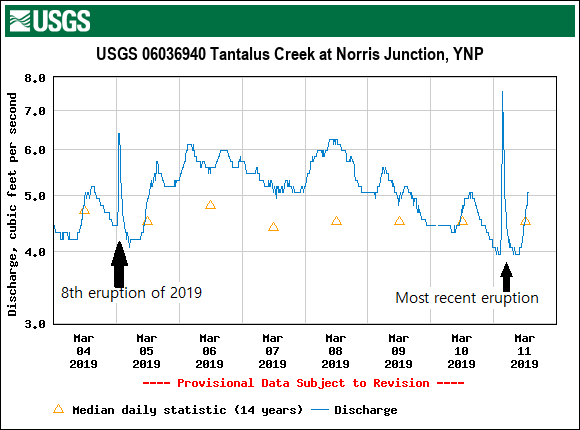
The water discharge chart for the Tantalus creek station at Norris. This station can detect the large increase of water from Steamboat's eruptions. This can be used to detect how much water was likely ejected. Although this most recent eruption was smaller in amplitude, it ejected much more water than the 8th eruption of 2019 did! Very strange. Again, click the "Click Here" button in the text above to see more detail about this recent eruption.
8th eruption of 2019 occurred at 06:38UTC on March 5, 2019 (11:38pm Mountain Time March 4, 2019):
7th eruption of 2019 occurred at 18:43UTC on February 25, 2019 (11:43am Mountain Time, same date):
6th eruption of 2019 occurred at 08:07UTC on February 16, 2019 (1:07am Mountain Time, same date):
5th eruption of 2019 occurred at 03:46UTC on February 9, 2019 (8:46pm Mountain Time, February 8, 2019):
4th eruption of 2019 occurred at 22:21UTC on February 1, 2019 (3:21pm Mountain Time, same date):
3rd eruption of 2019 occurred at 19:32UTC on January 25, 2019 (12:32pm Mountain Time, same date):
2nd eruption of 2019 occurred at 14:12UTC on January 16, 2019 (7:12am Mountain Time, same date):
1st eruption of 2019 (Happy New Year!) occurred at 23:02UTC on January 4, 2019 (4:02pm Mountain Time, same date):
